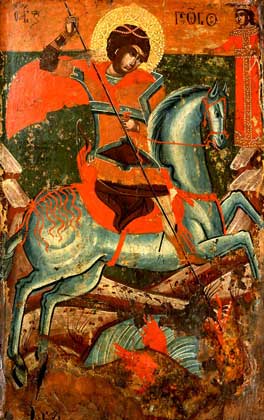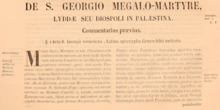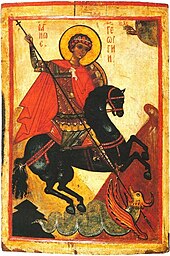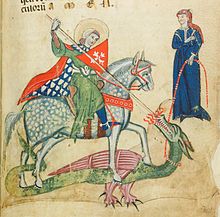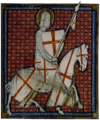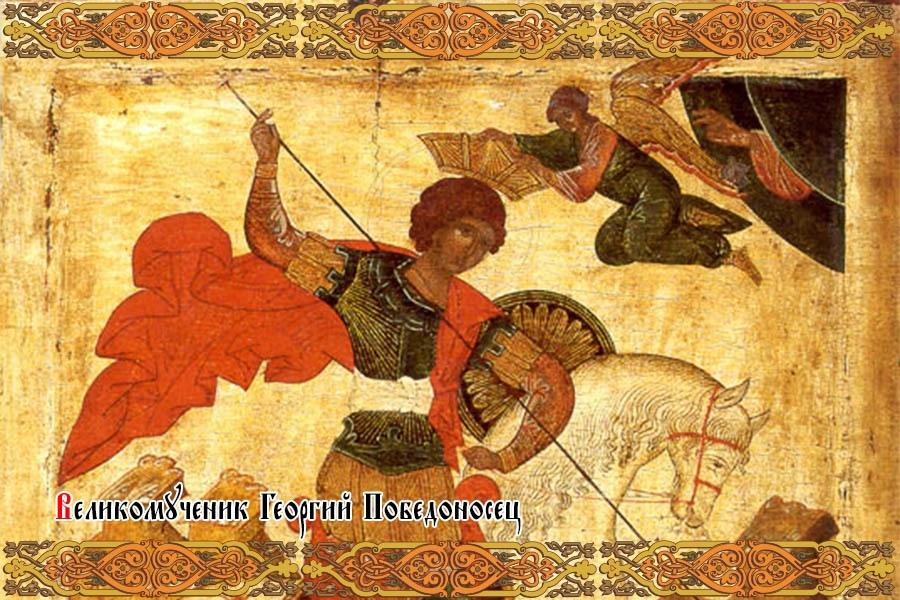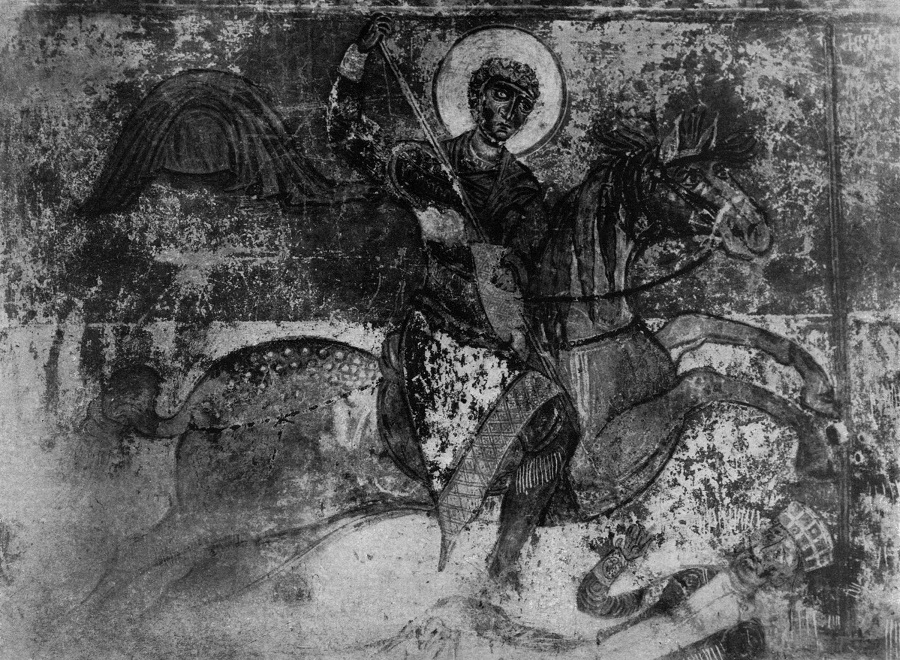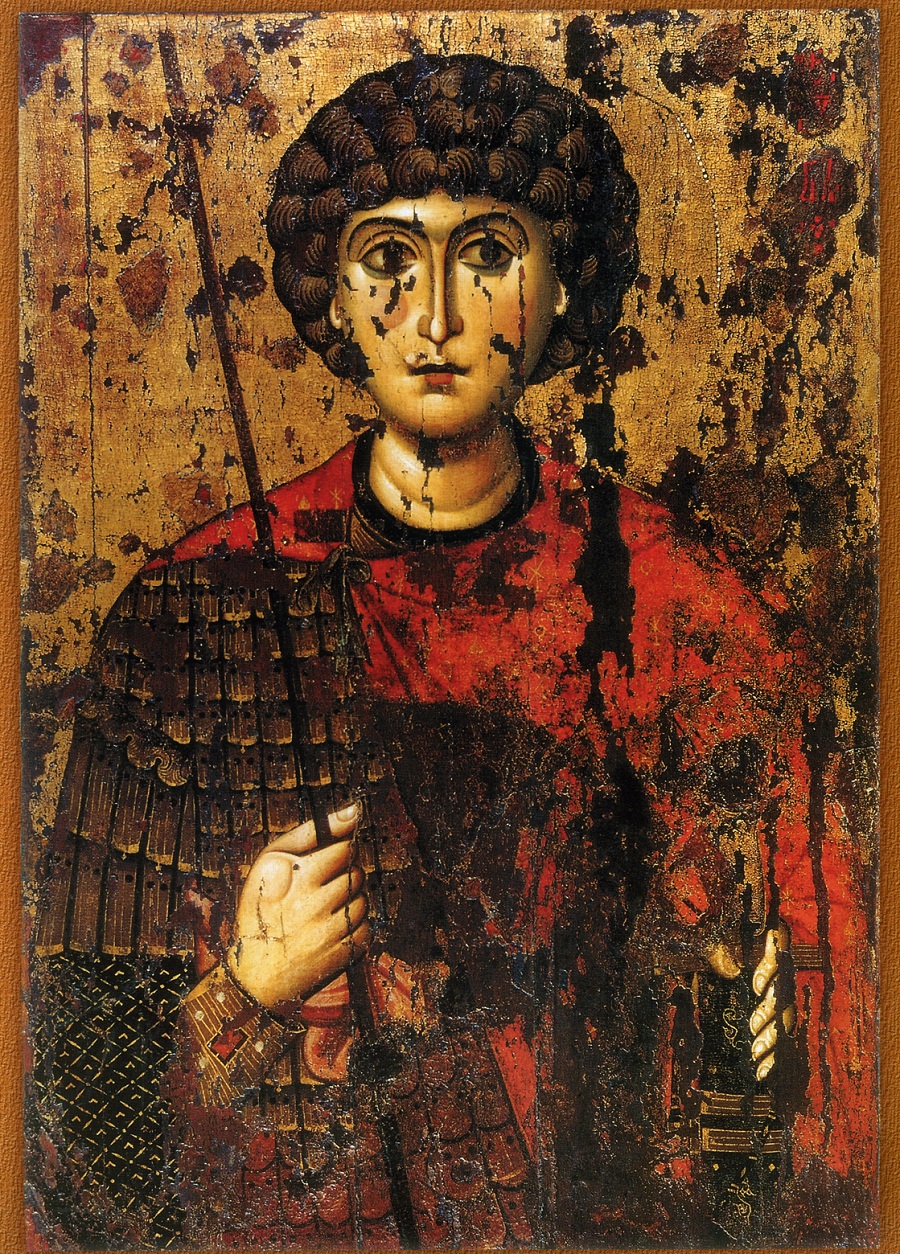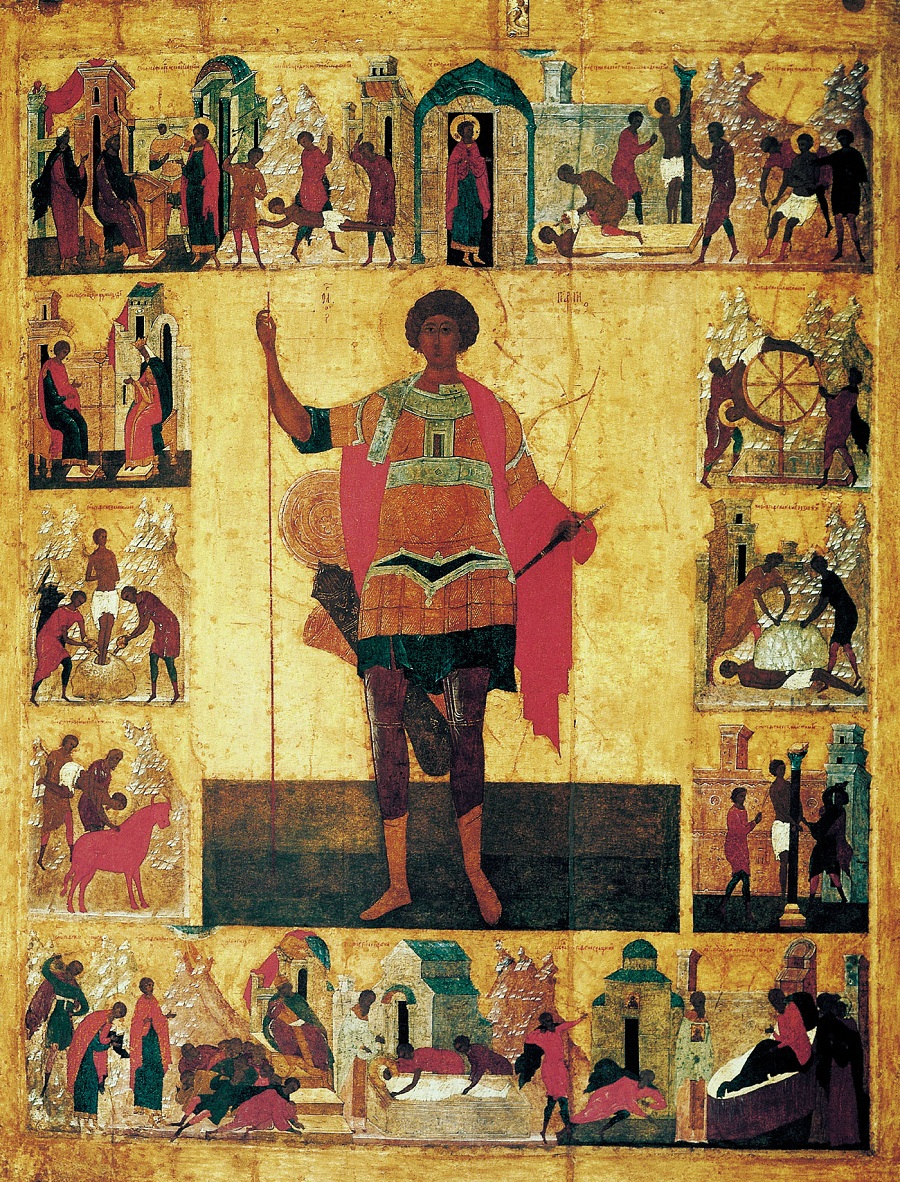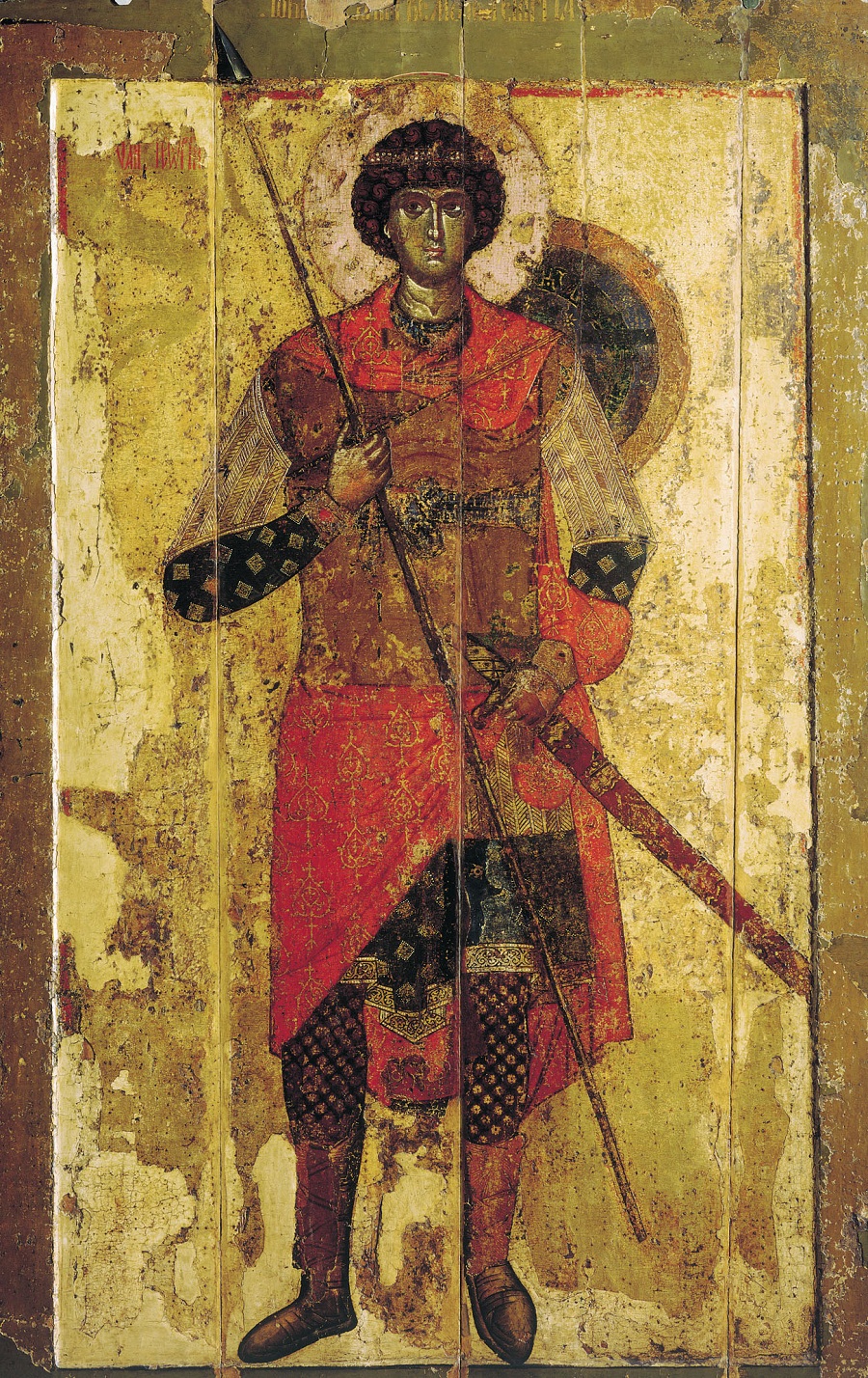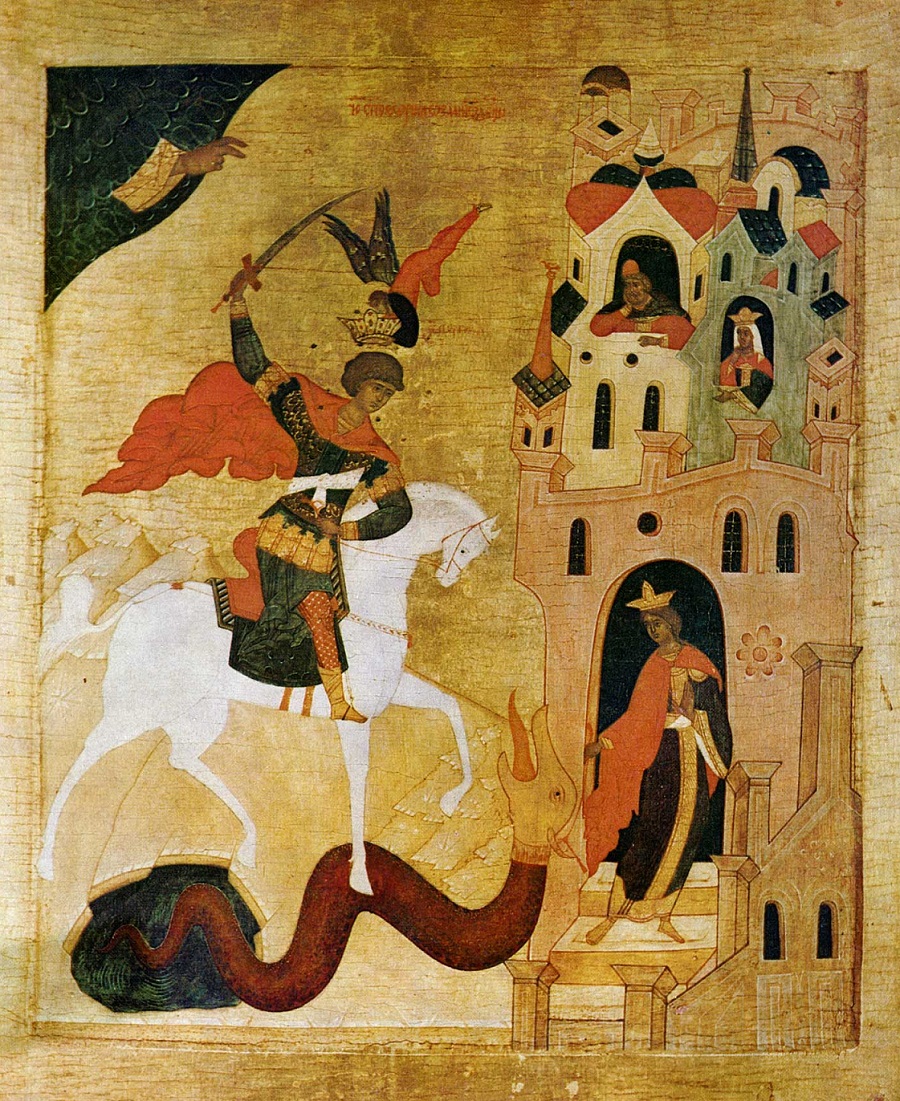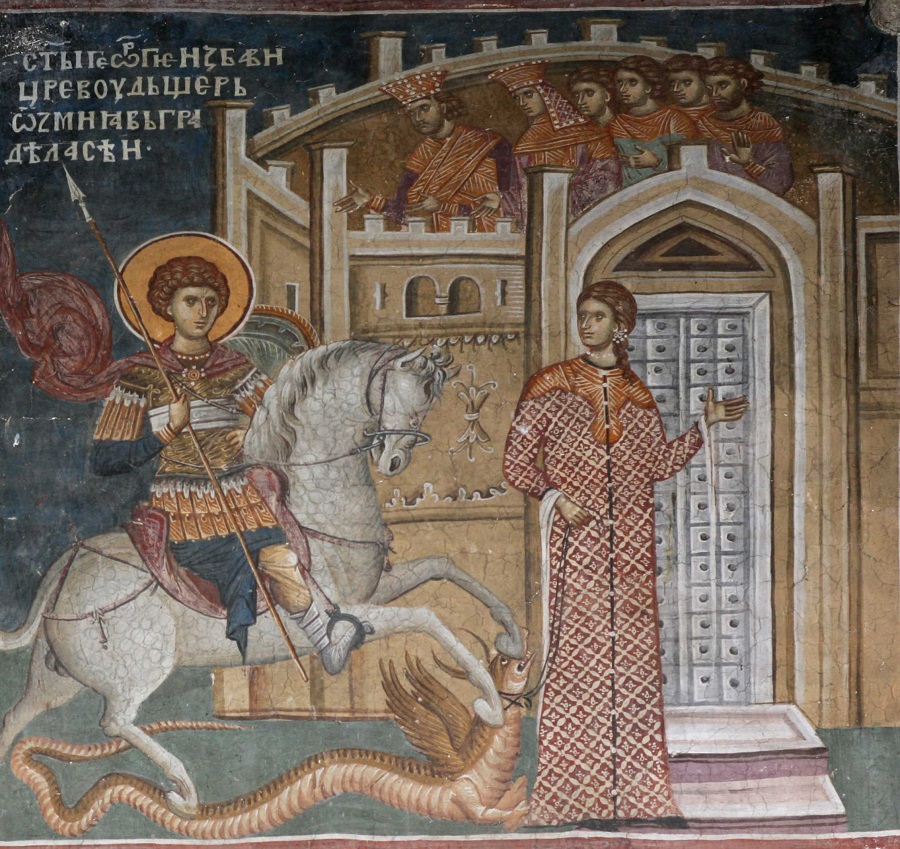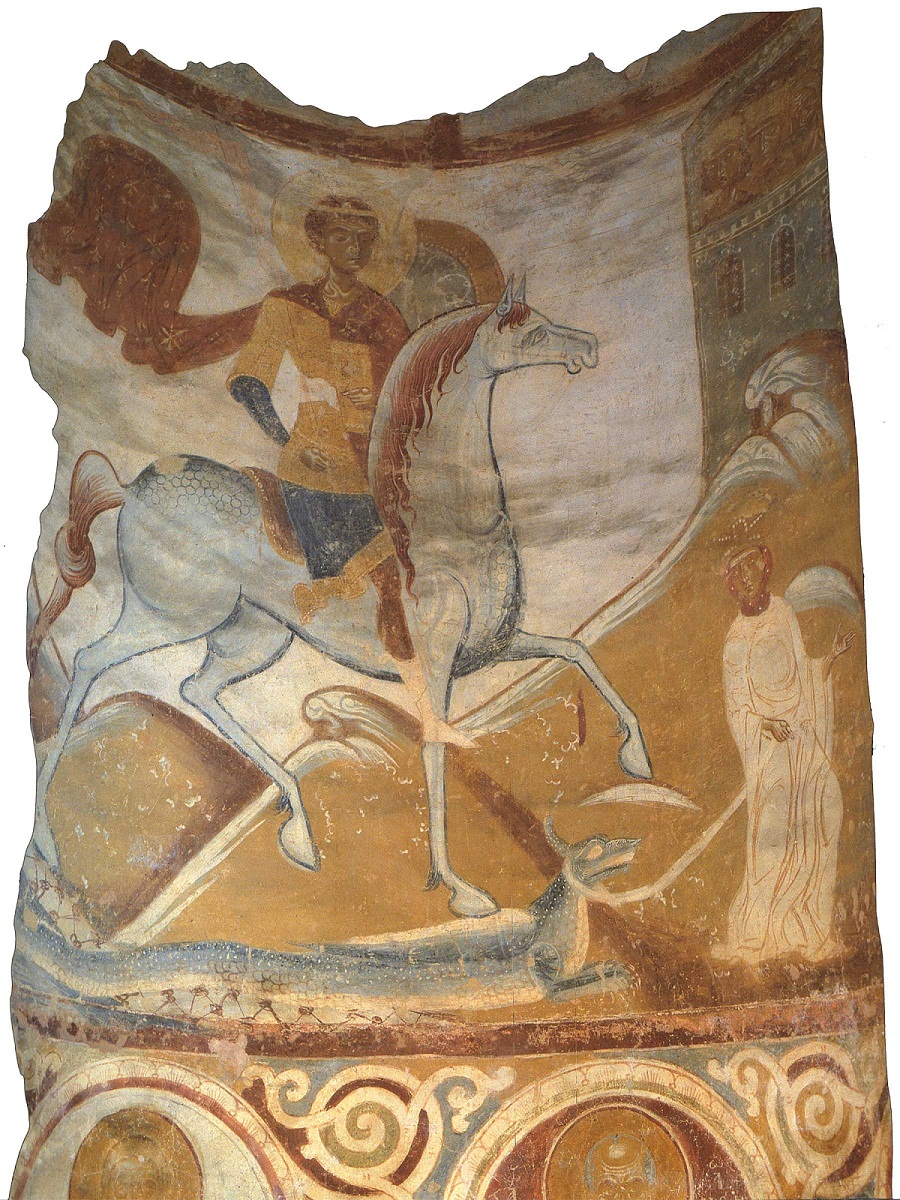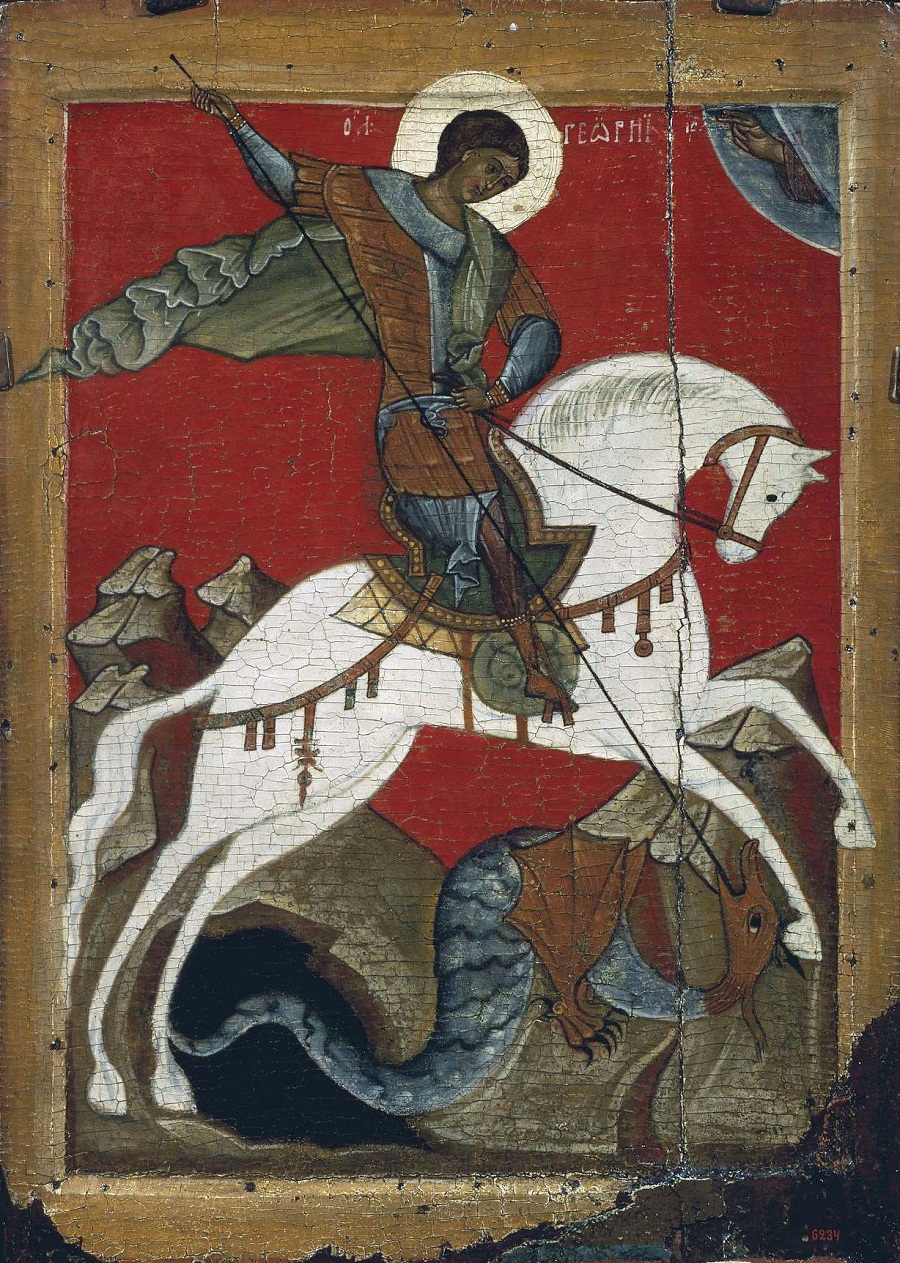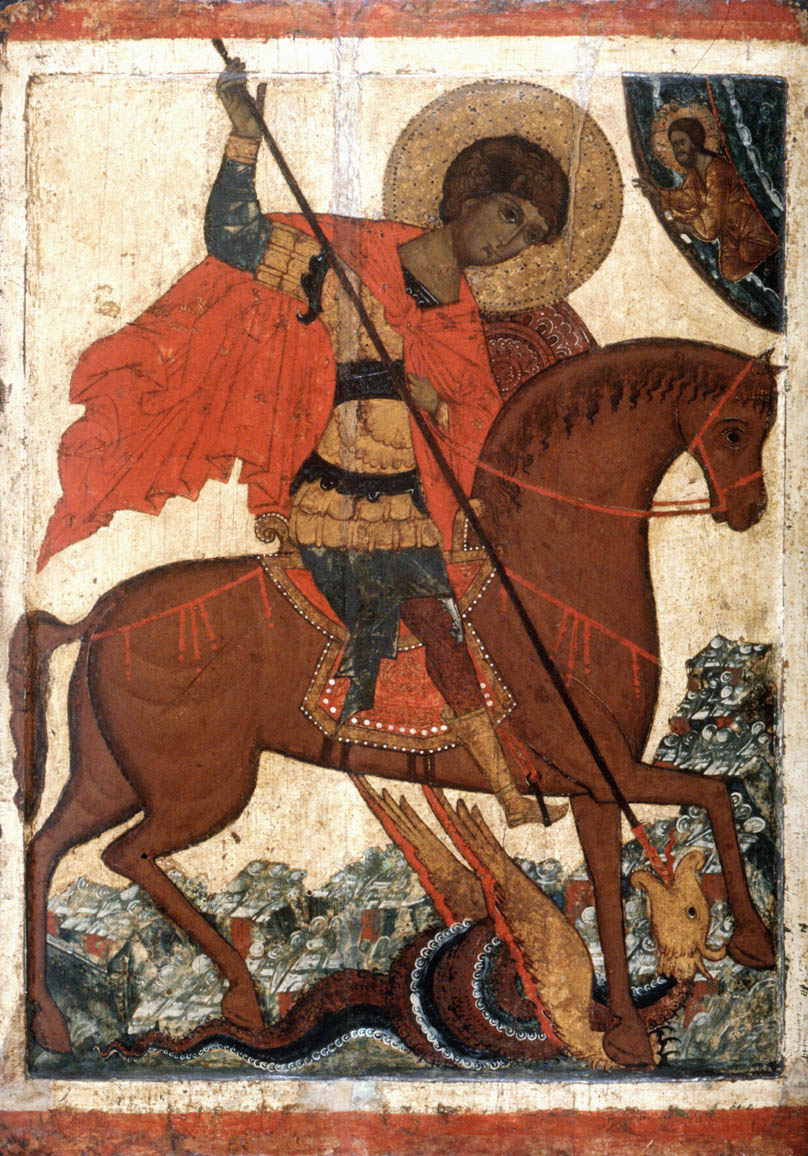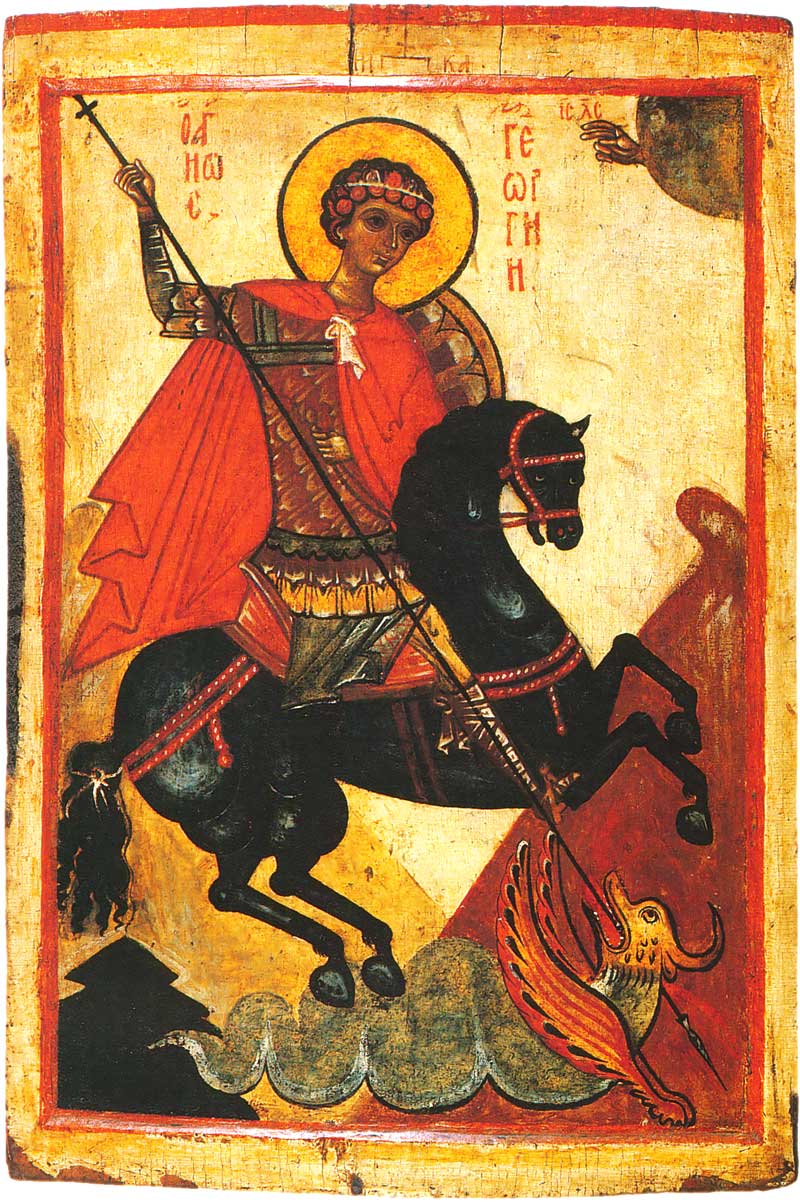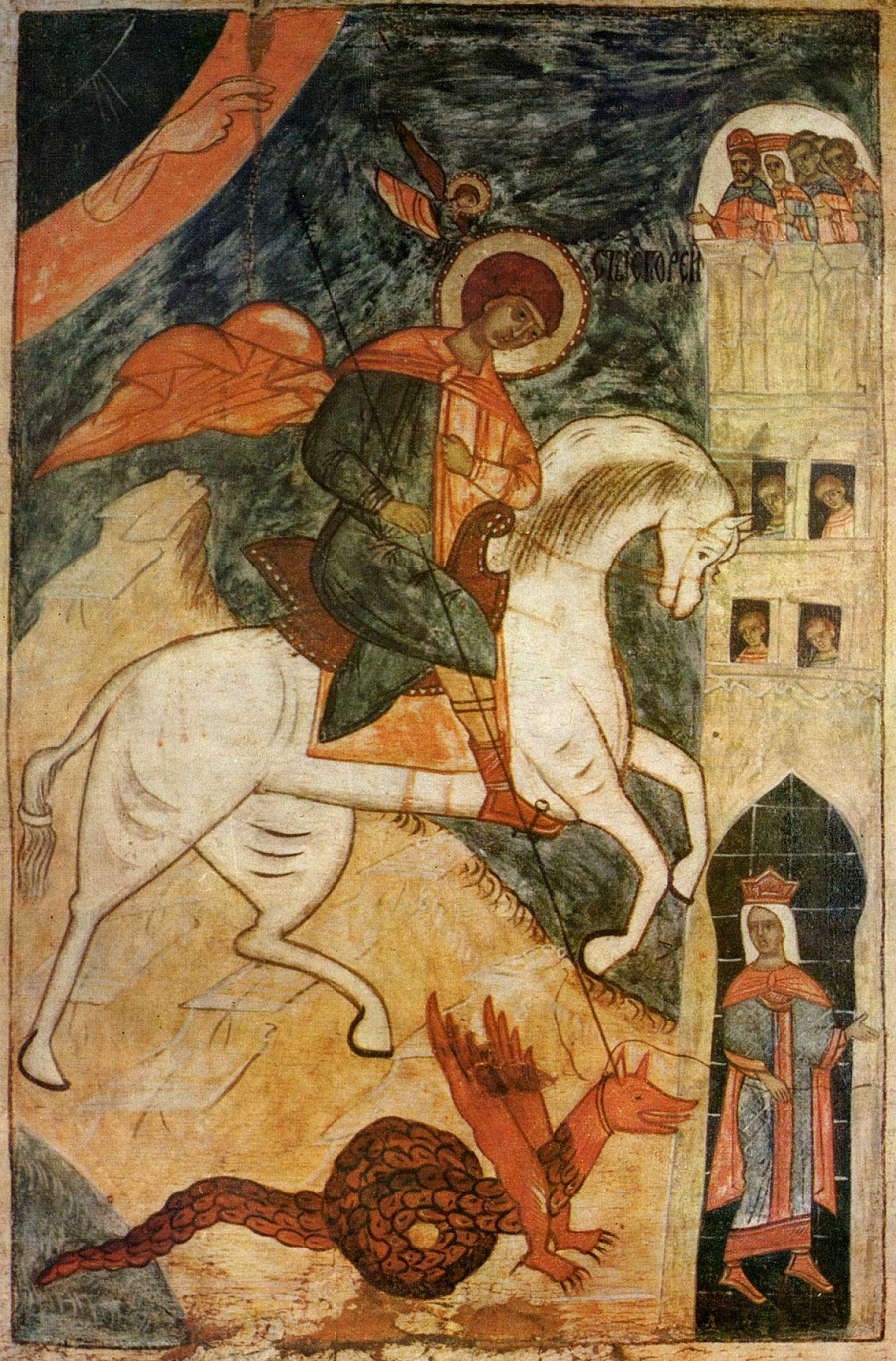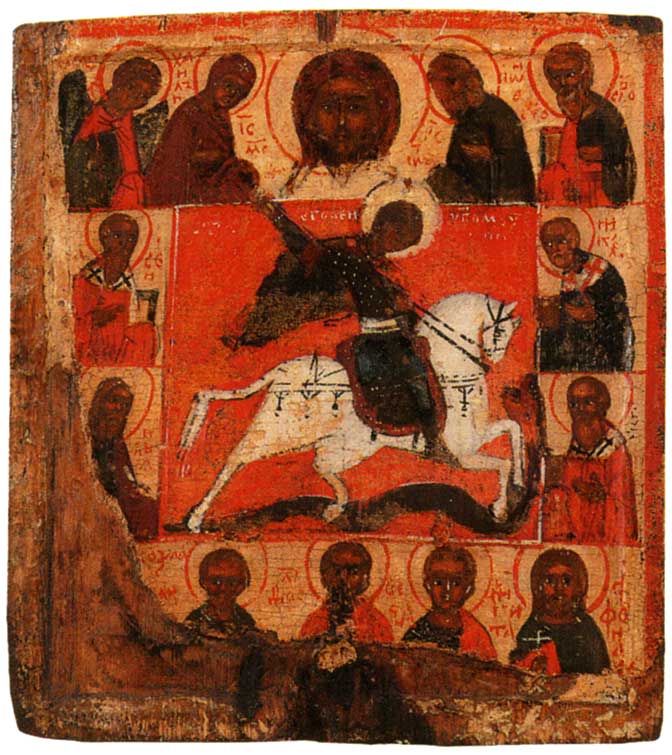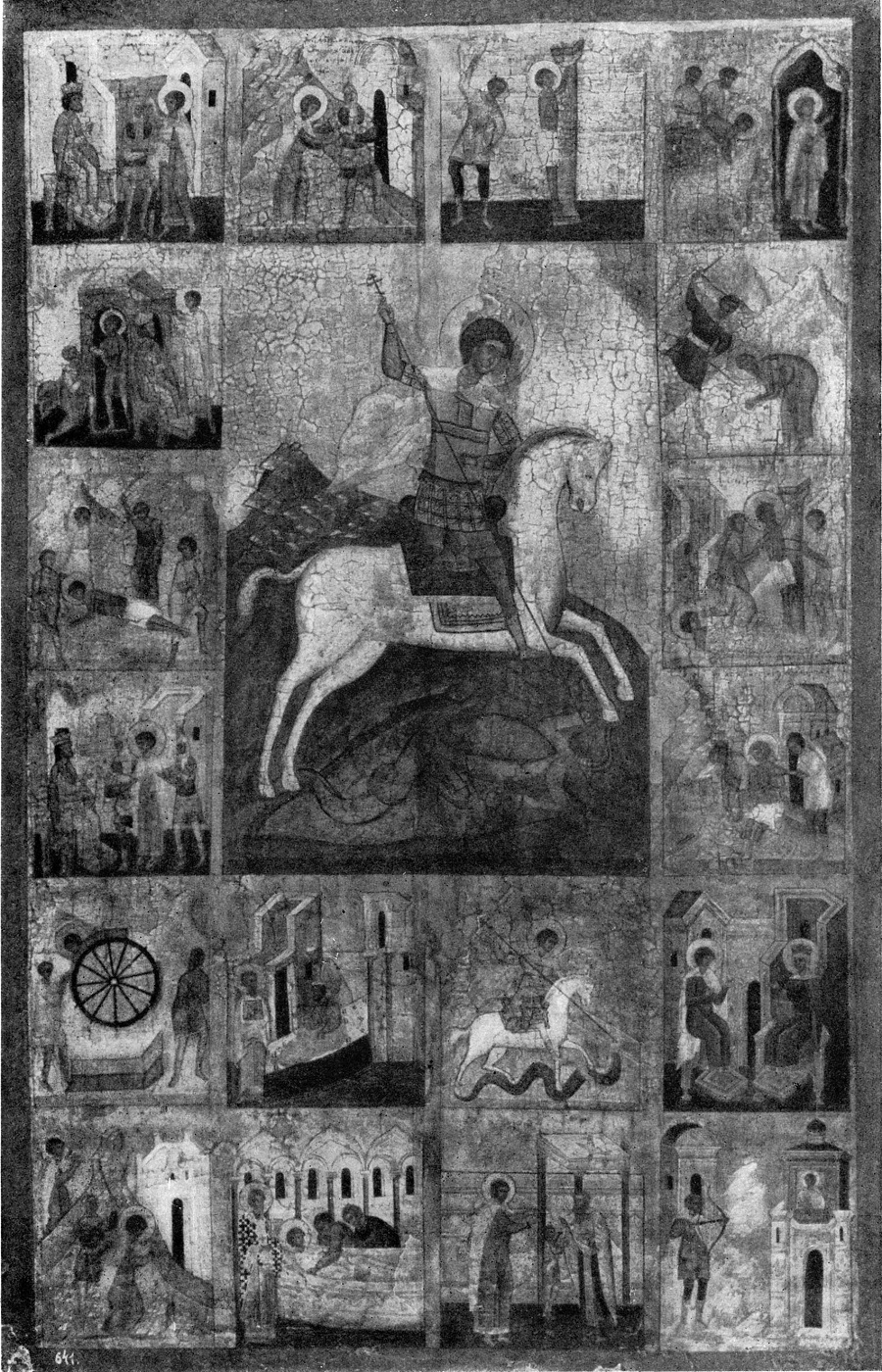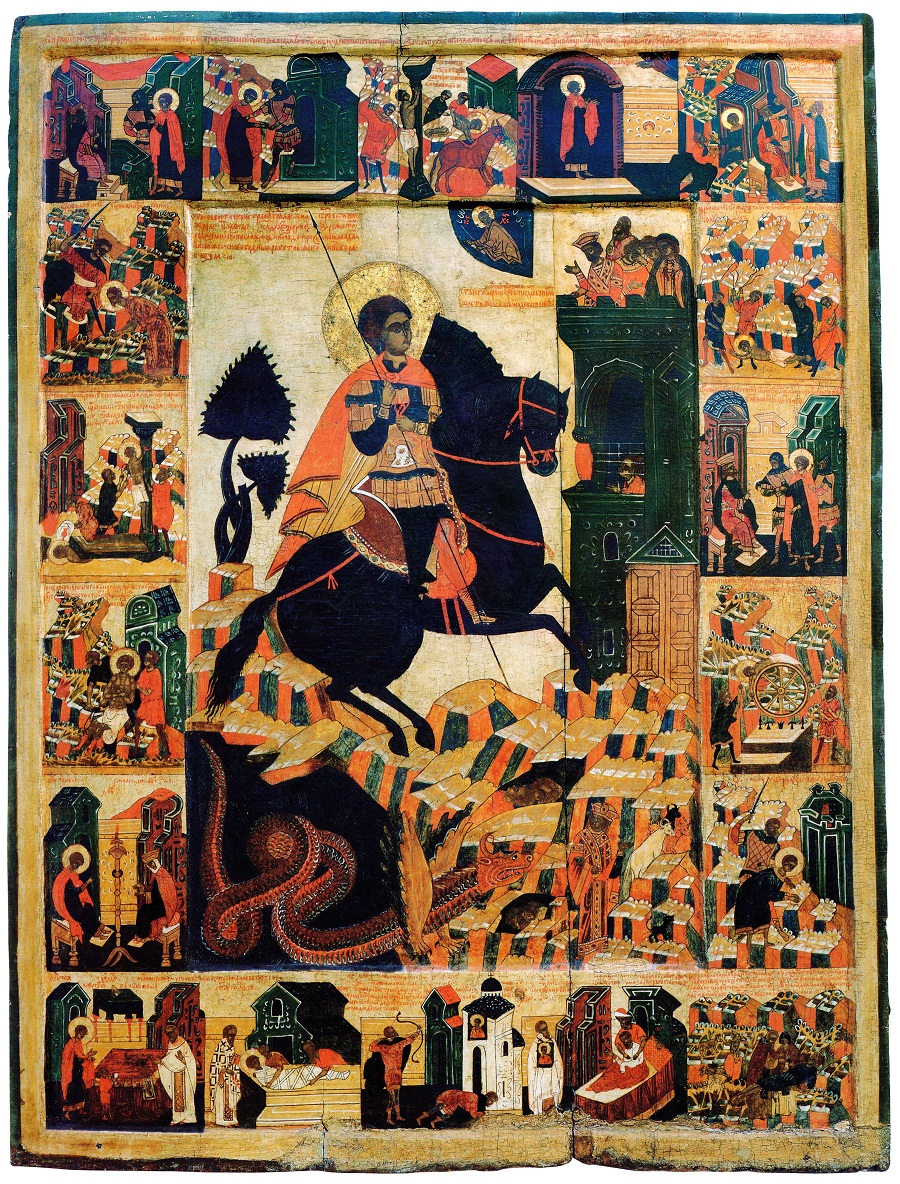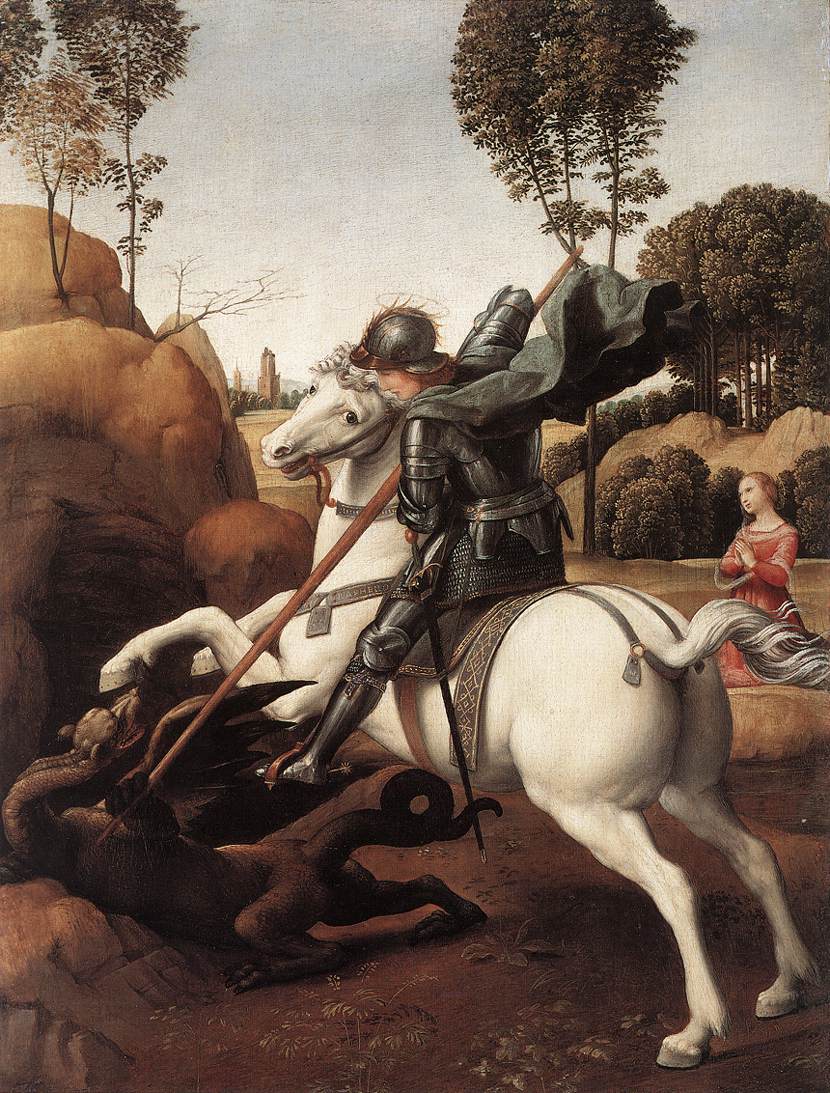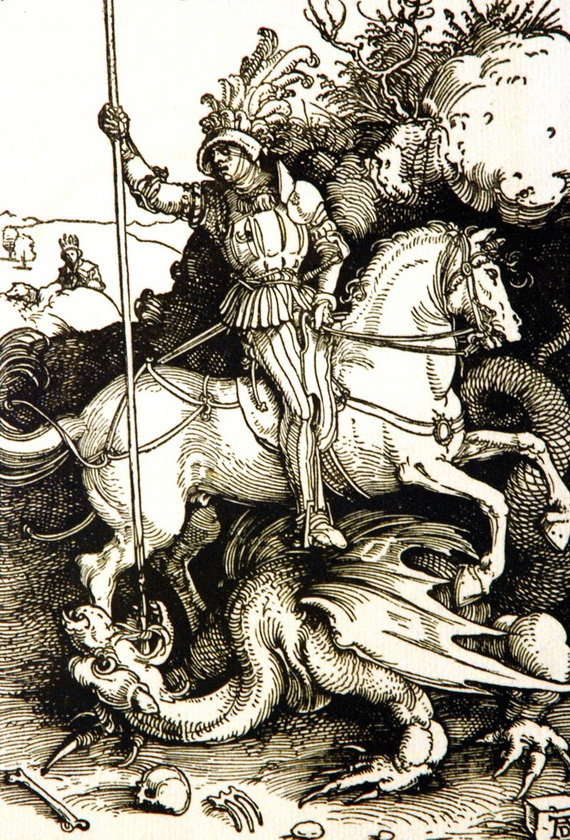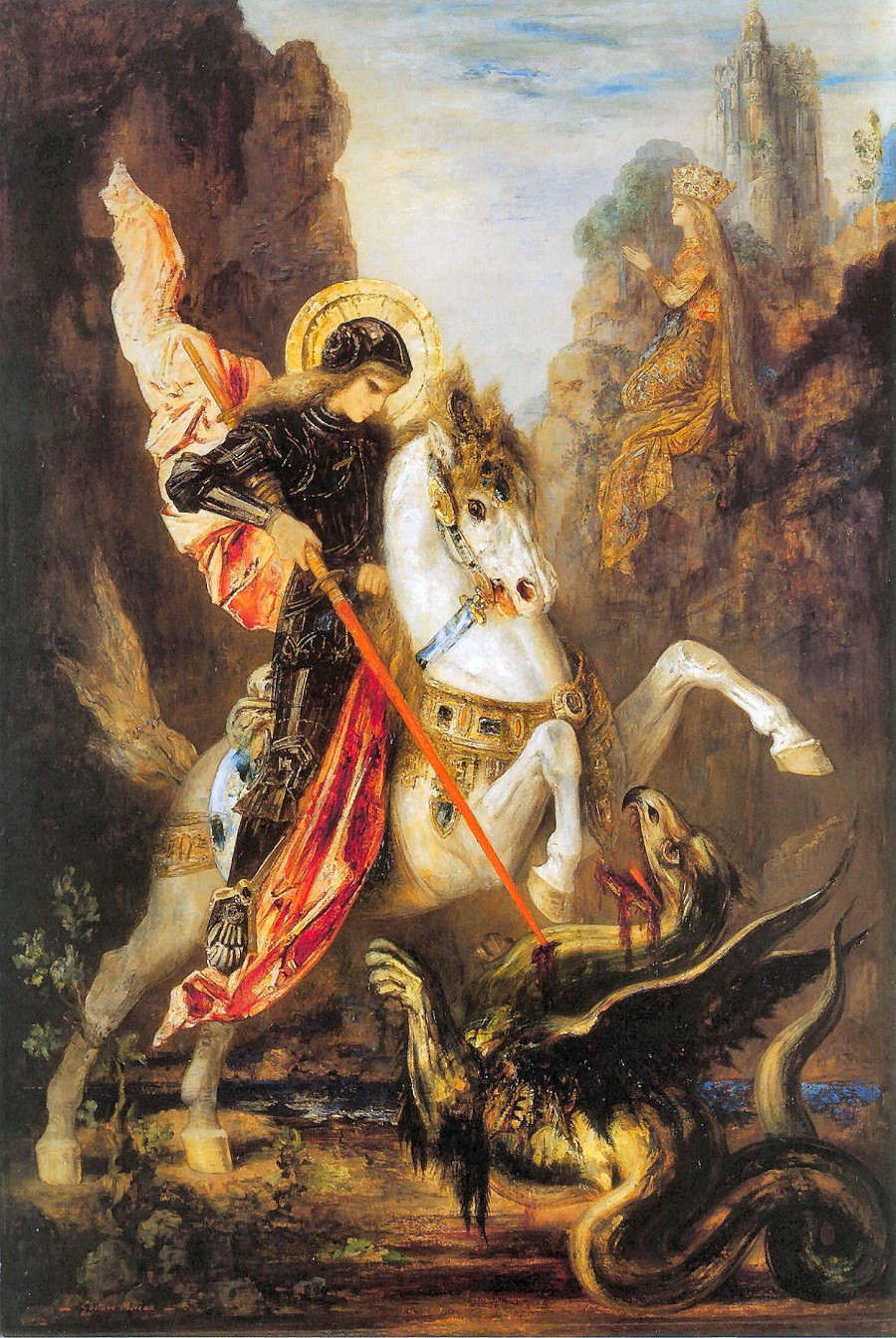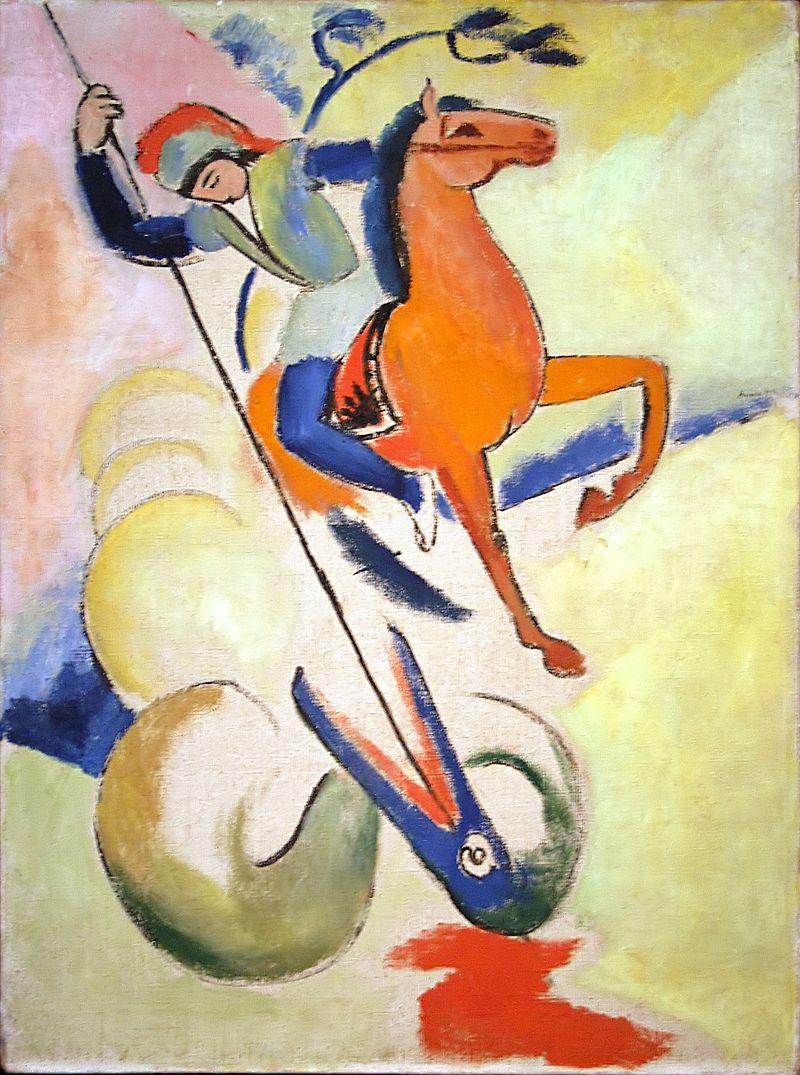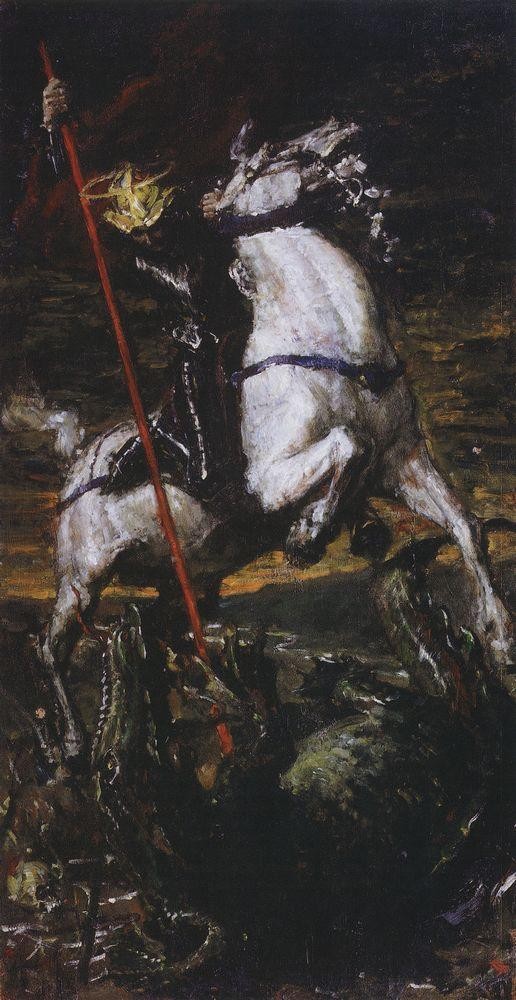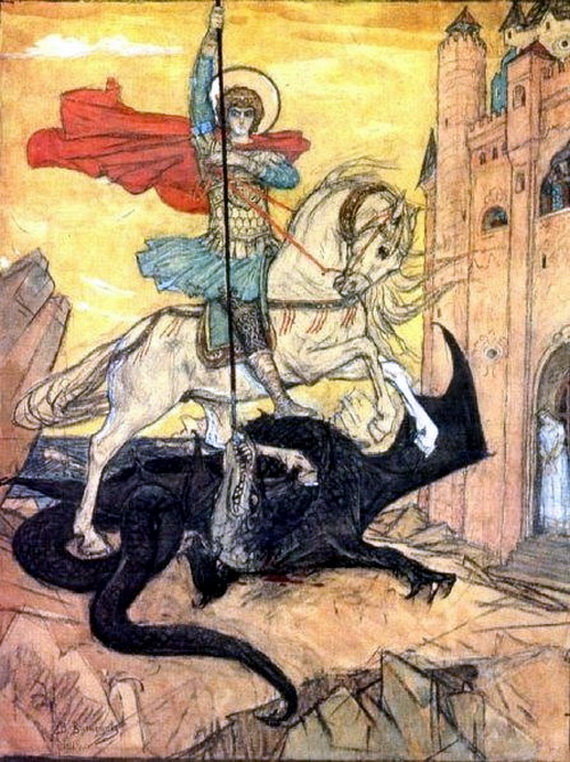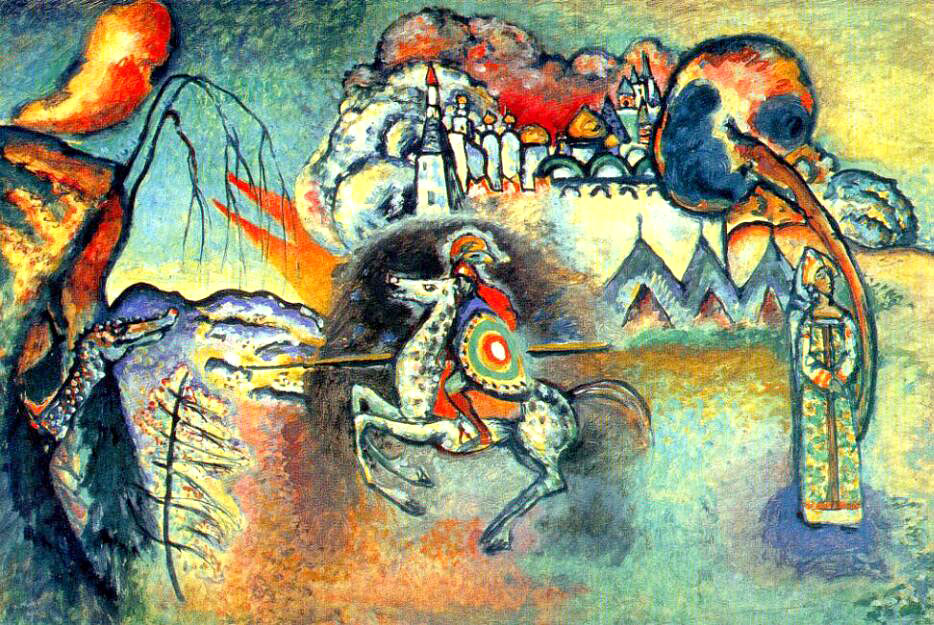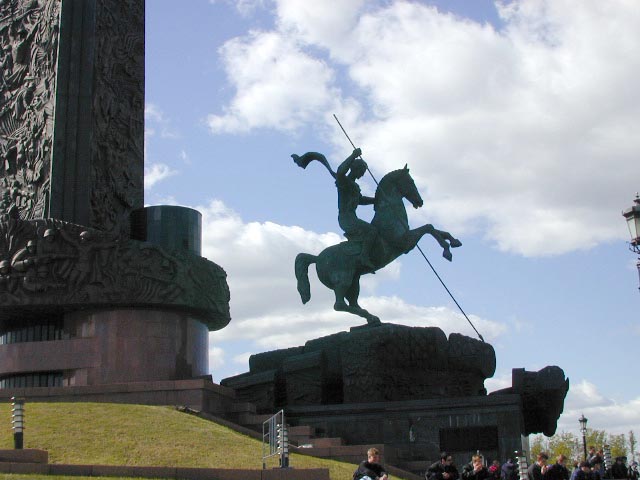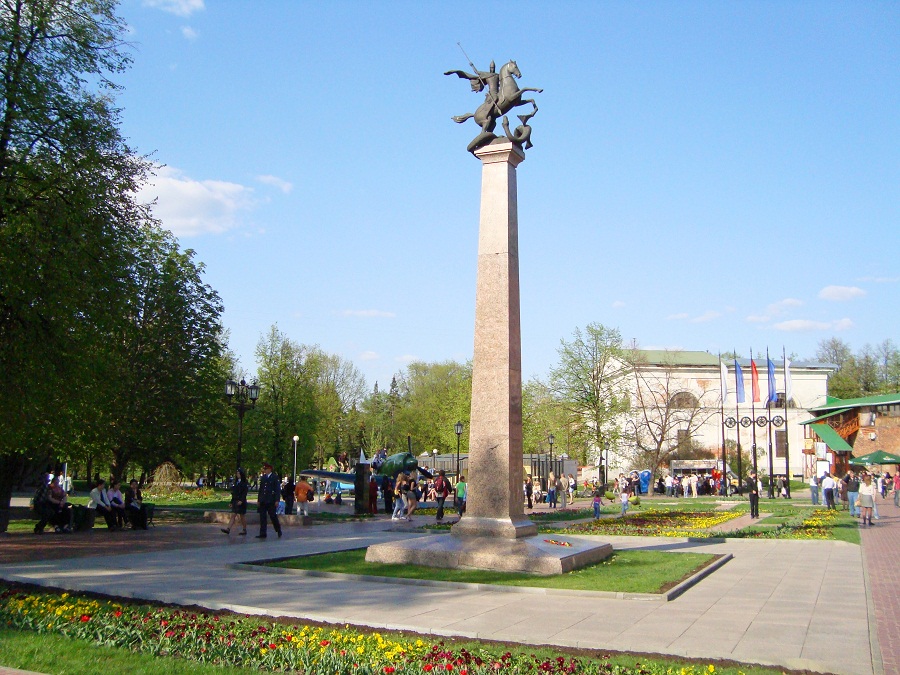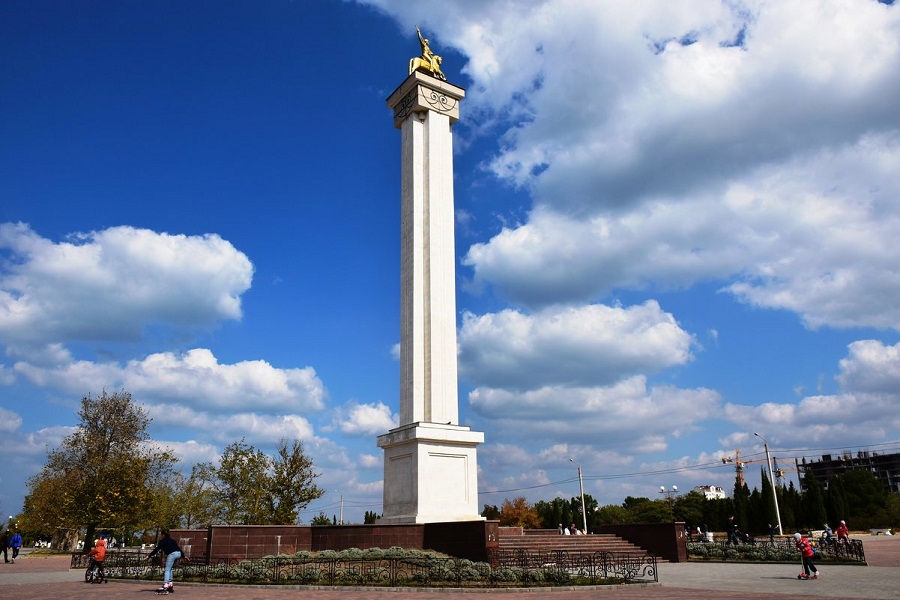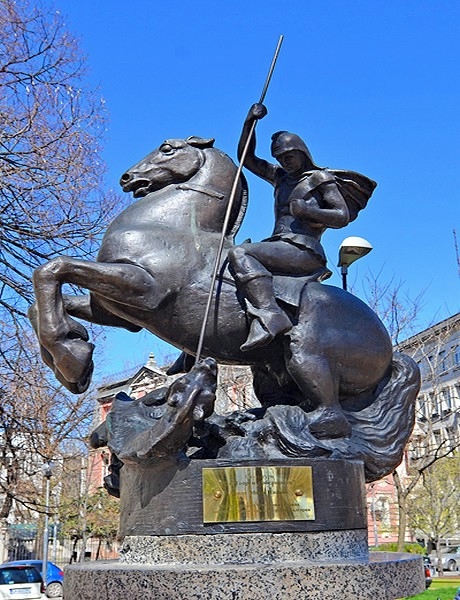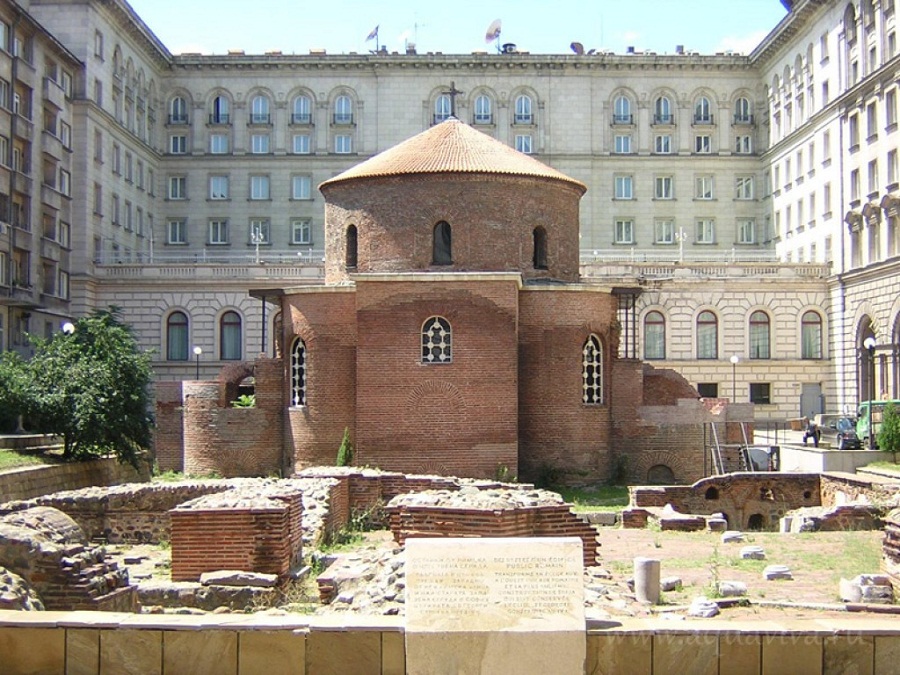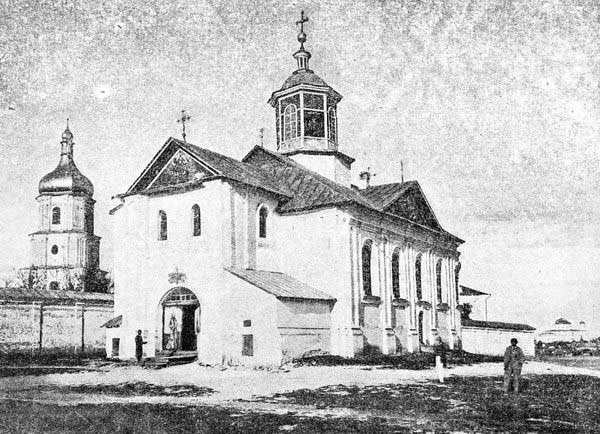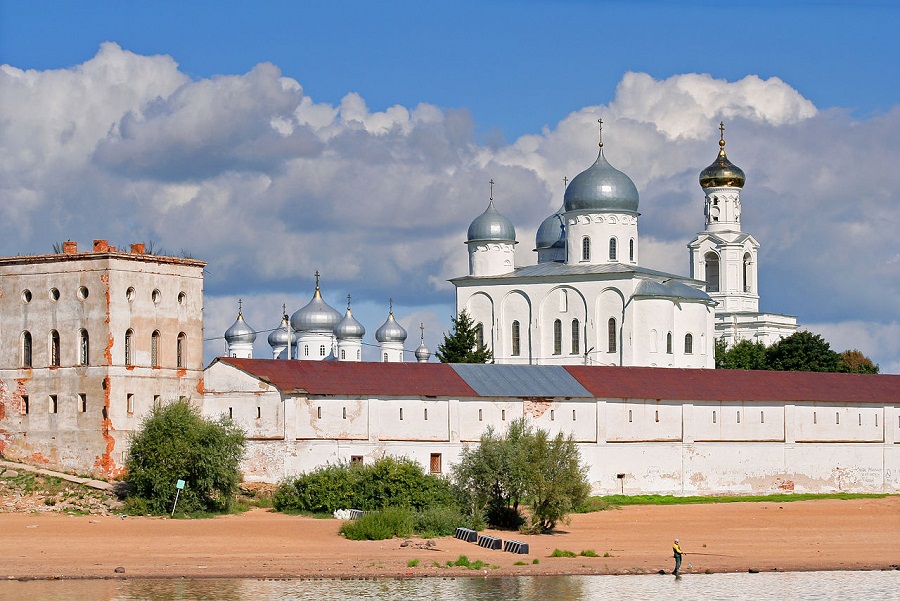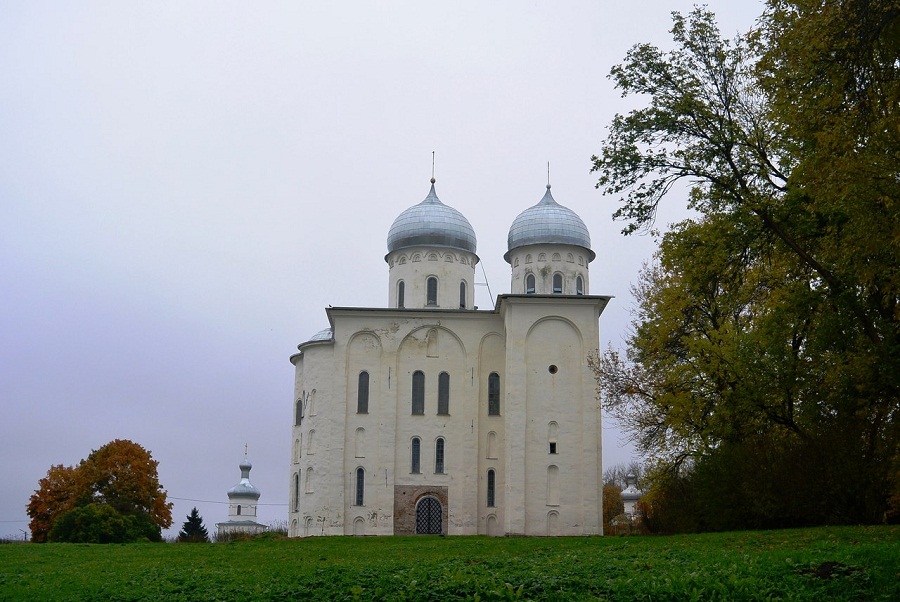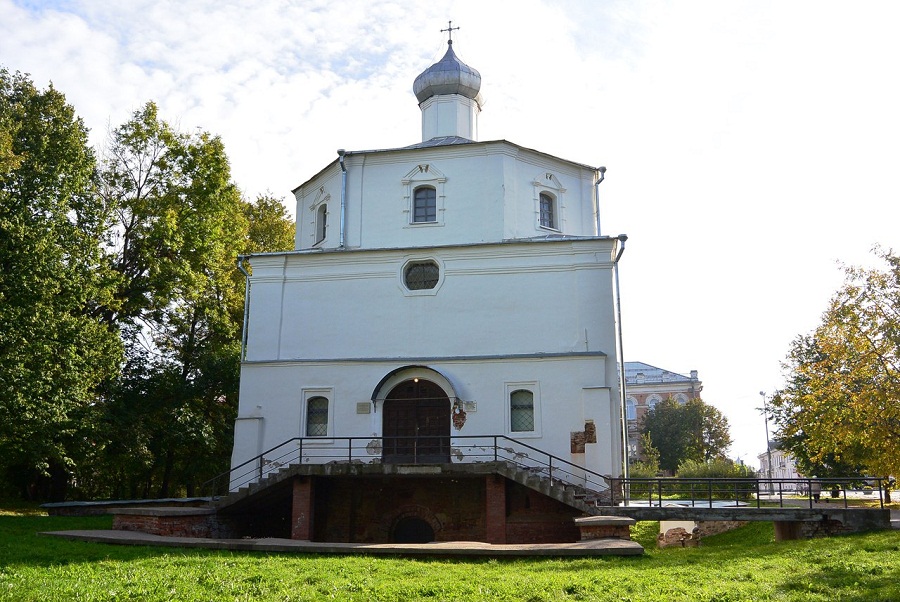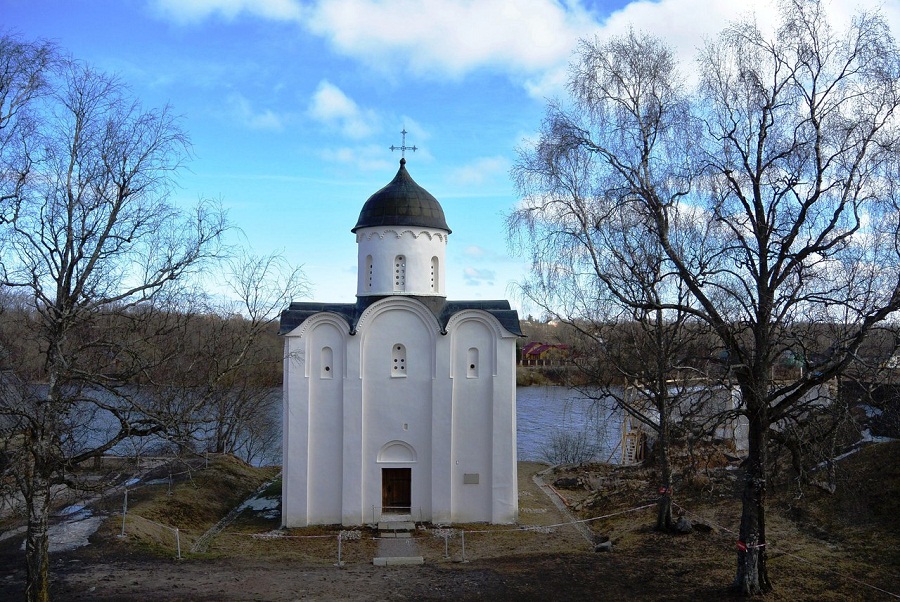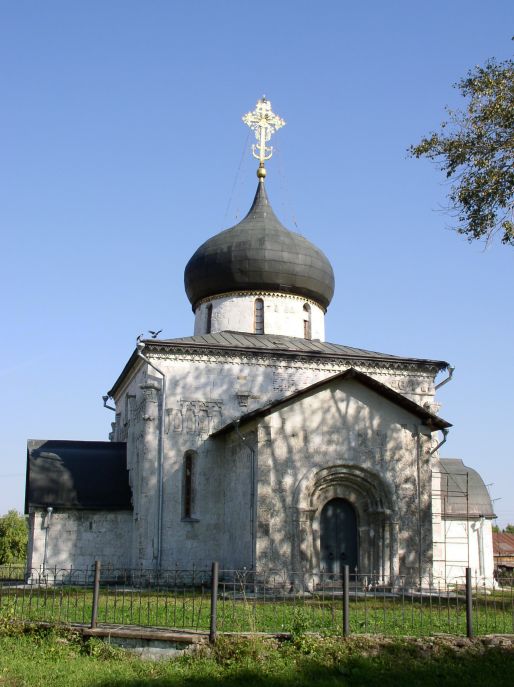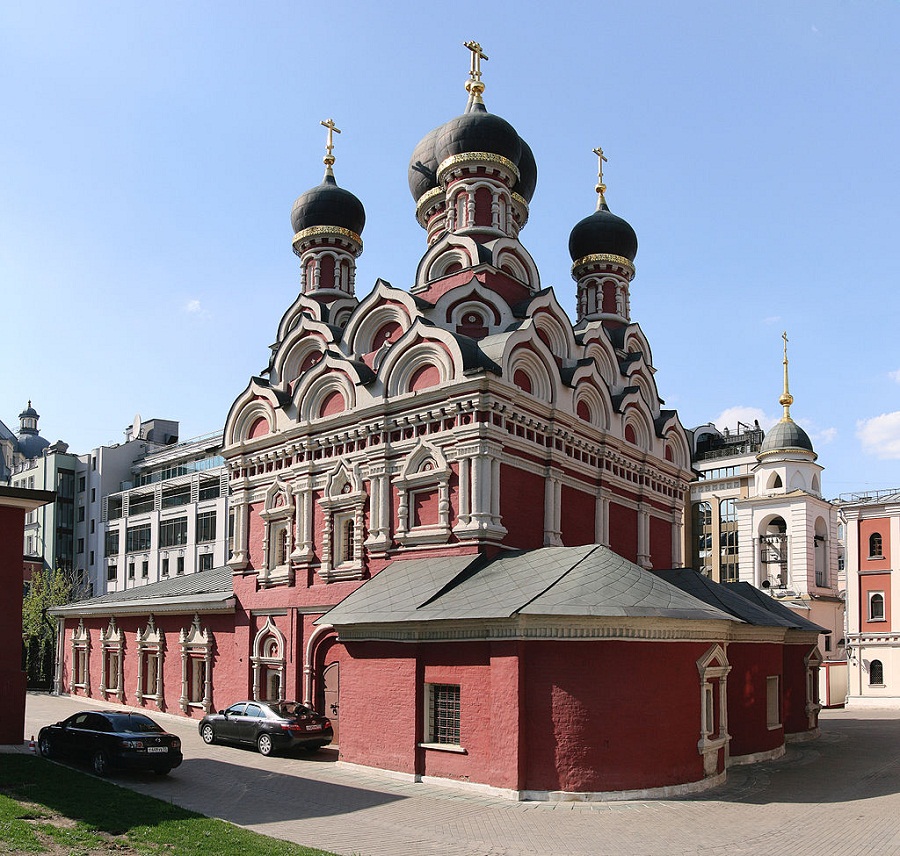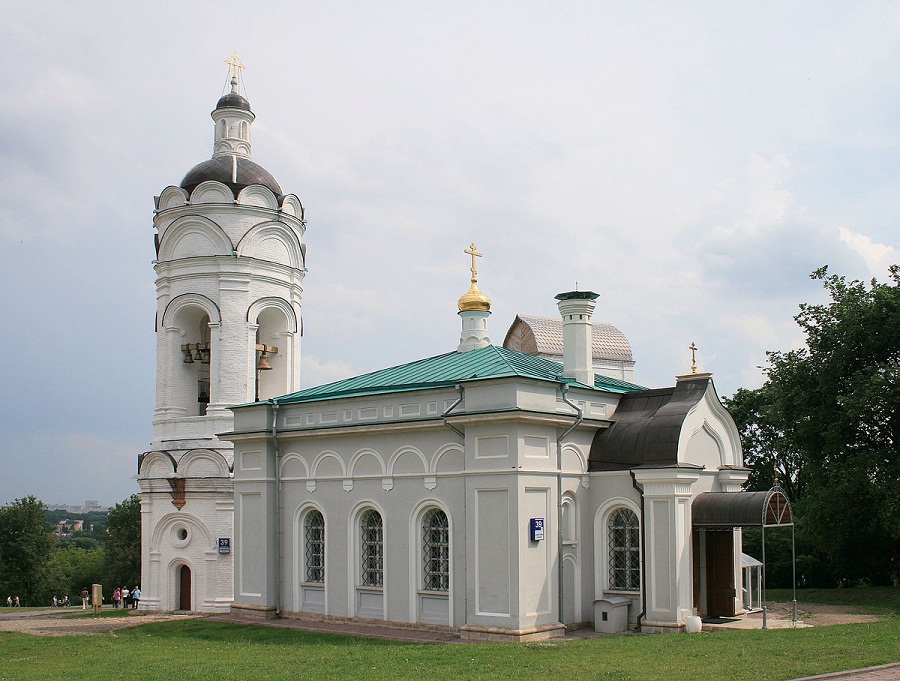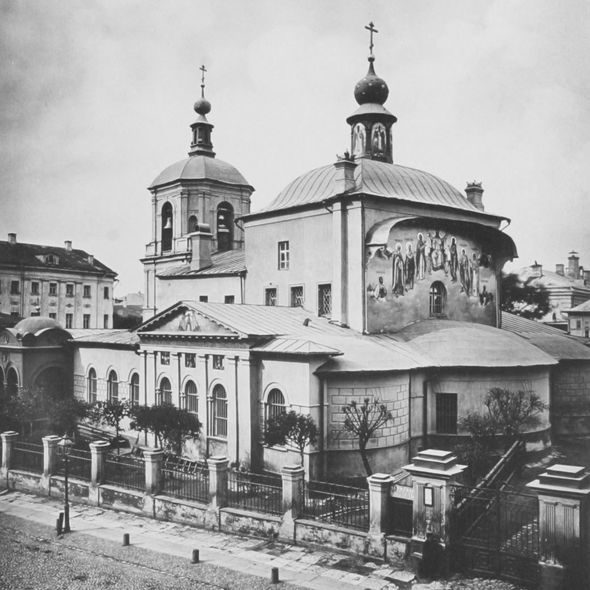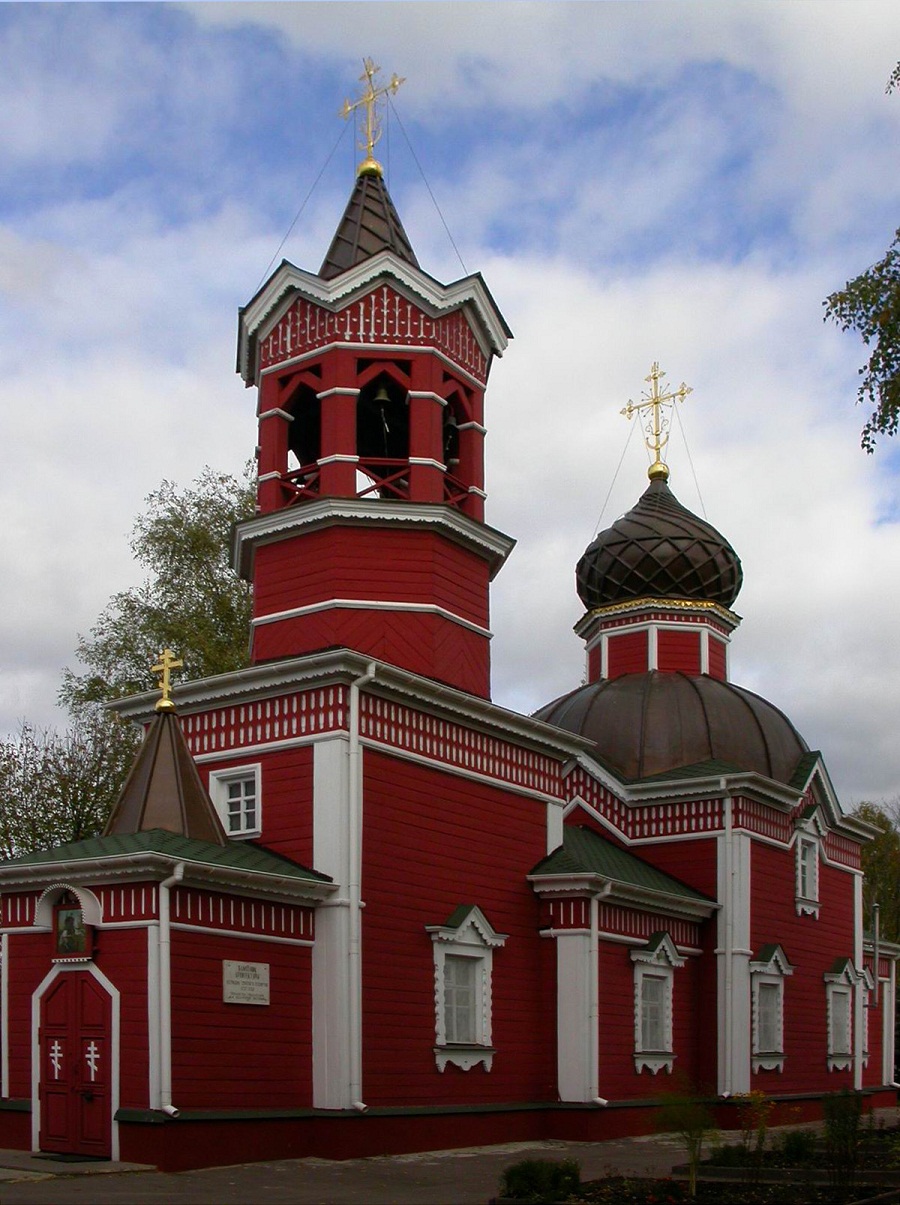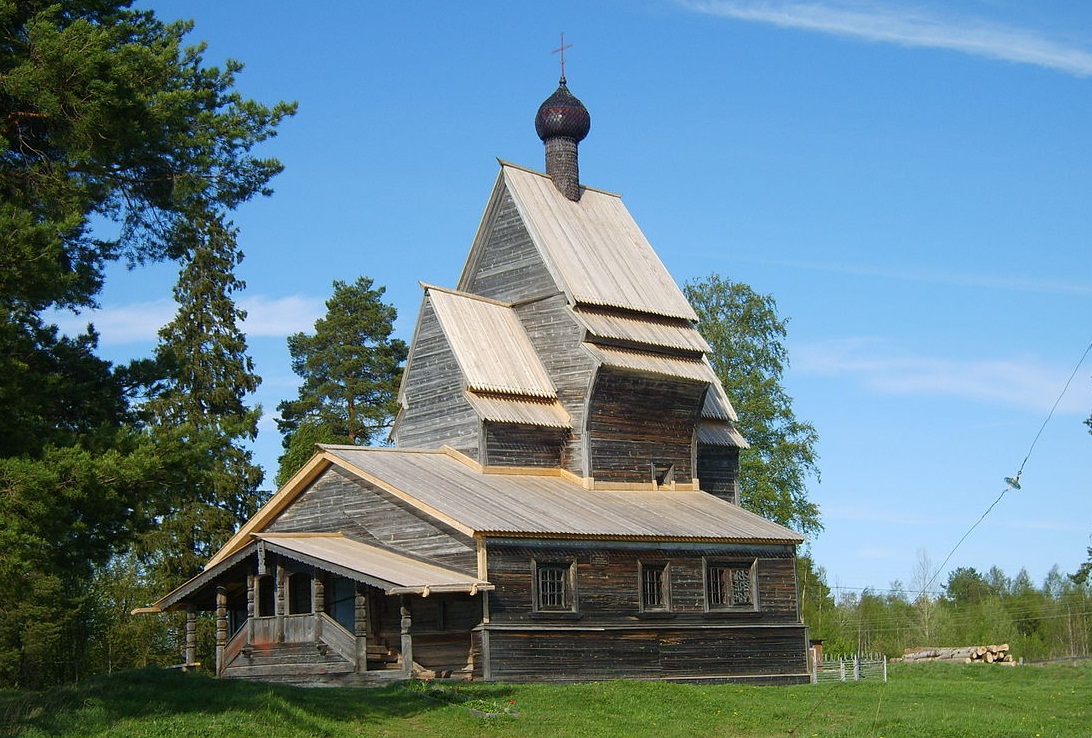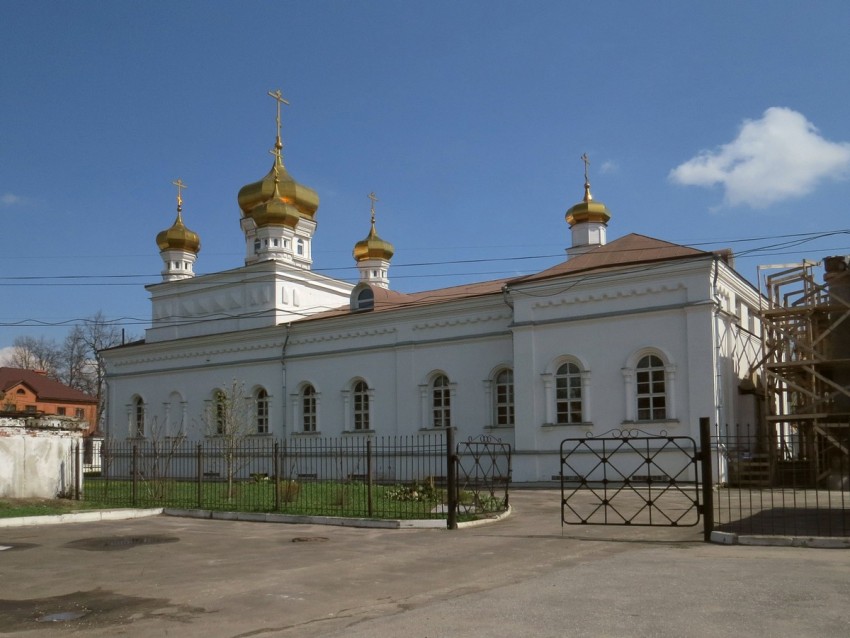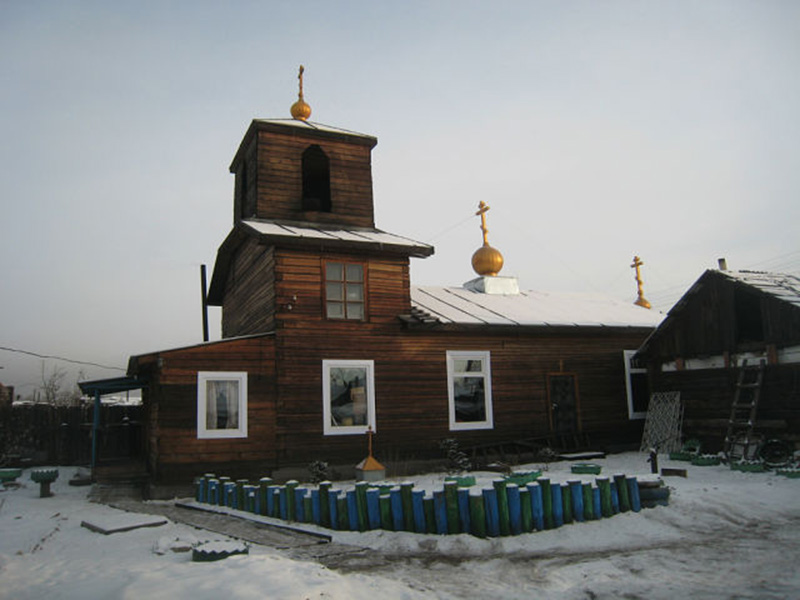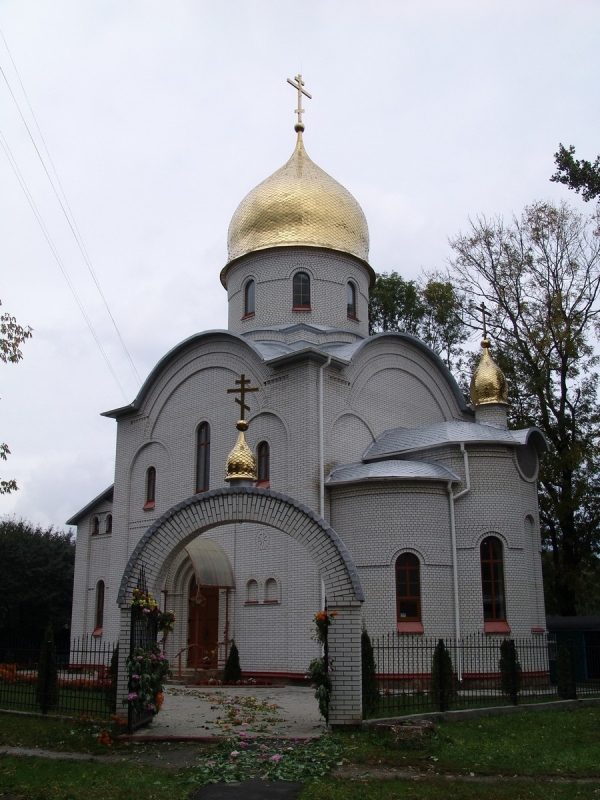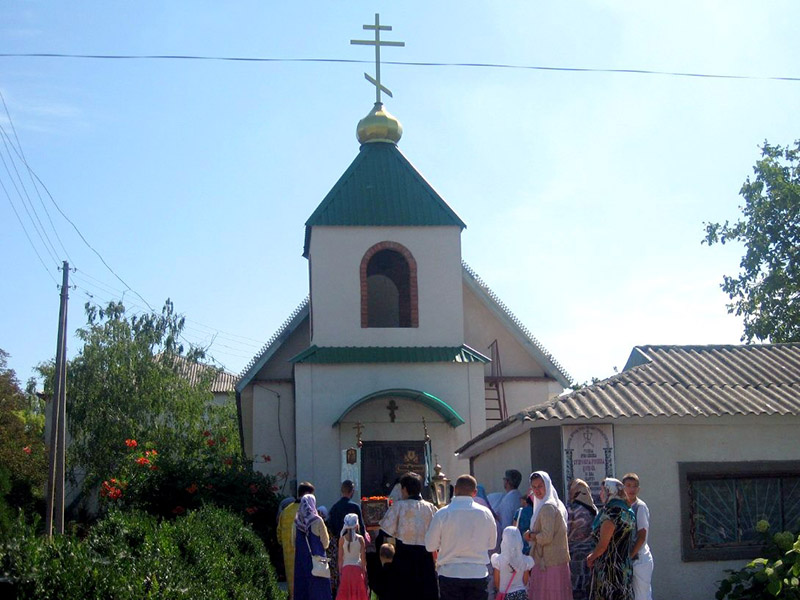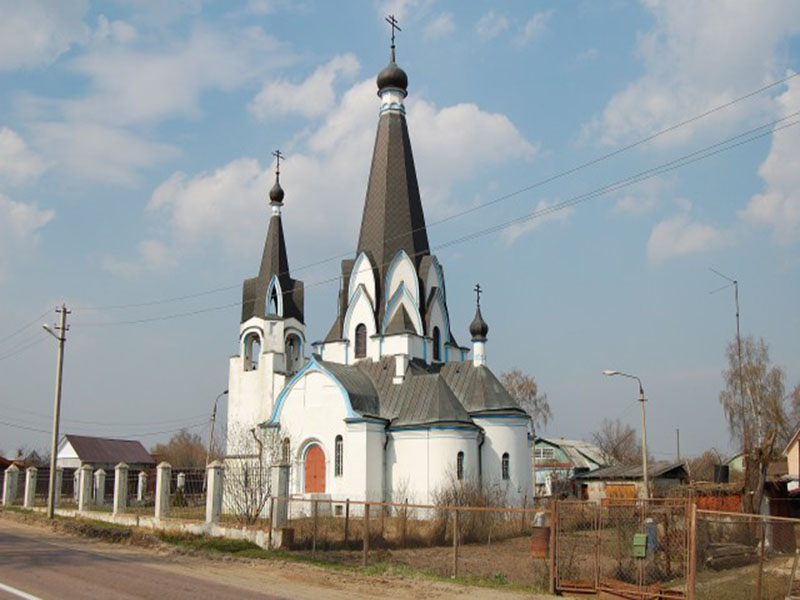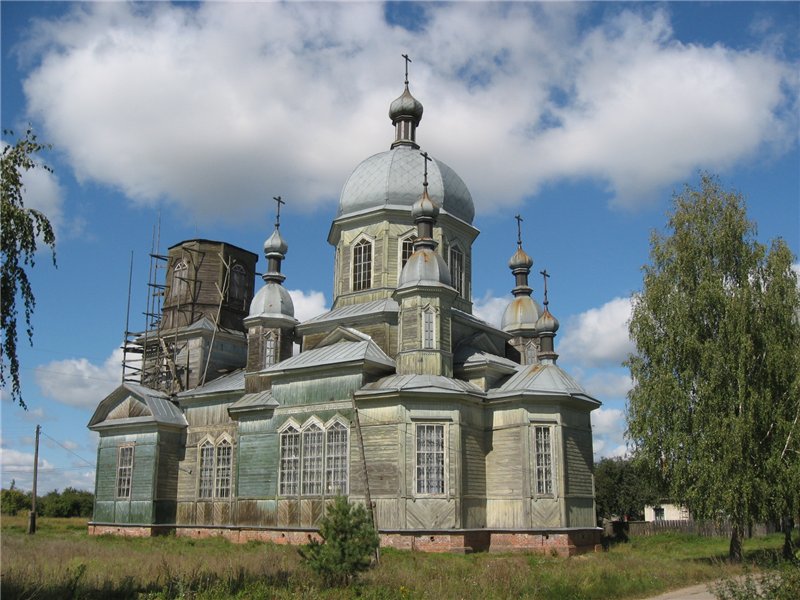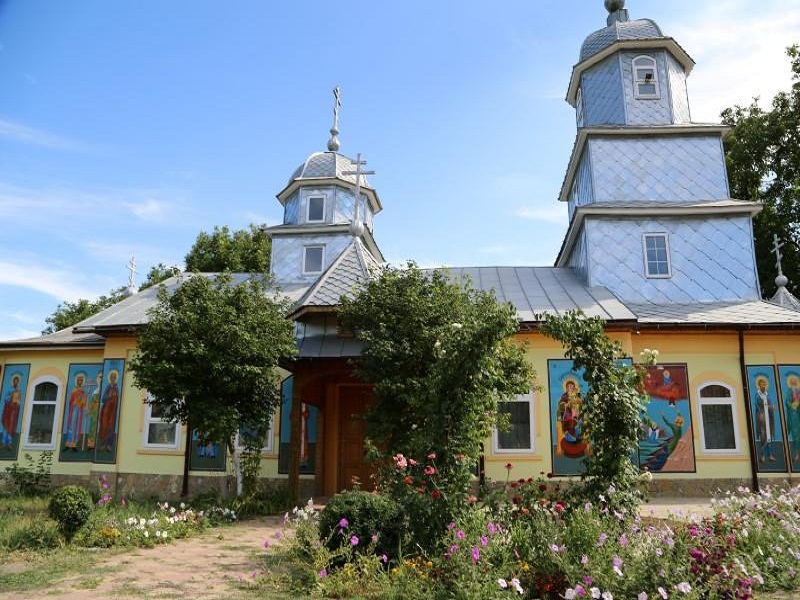Толковый словарь русского языка. Поиск по слову, типу, синониму, антониму и описанию. Словарь ударений.
Найдено определений: 5
георгий победоносец
ПОПУЛЯРНЫЙ СЛОВАРЬ
Георгий Победоносец
Гео́ргия Победоно́сца, м.
В христианских и мусульманских преданиях: святой великомученик из военного сословия, считавшийся в народе покровителем земледелия и скотоводства и почитавшийся на Руси под именем Юрия или Егория Храброго.
Этимология:
Георгий — имя собственное, заимствованное древнерусским языком из книжного греческого, устным путем трансформированное в Юрий.
Энциклопедический комментарий:
Христианская житийная литература говорит о Георгии Победоносце как о современнике римского императора Диоклетиана. Уроженец восточной Малой Азии, принадлежащий к местной знати, он дослужился до высокого военного чина. Во время гонения на христиан его пытались истязаниями принудить к отречению от веры и в конце концов отрубили голову. Памятные праздничные дни — 23 апреля и 26 ноября.
Изображения святого Георгия встречаются издревле на великокняжеских монетах и печатях. С XIV в. он считается покровителем Москвы, а изображение всадника на коне становится эмблемой Москвы. Позднее изображение святого Георгия на вздыбившемся коне, поражающего копьем дракона, вошло в состав герба Российской империи. В 1769 г. в России был учрежден военный орден св. великомученика и победоносца Георгия, в 1913 г. — военный Георгиевский крест.
ЭНЦИКЛОПЕДИЧЕСКИЙ СЛОВАРЬ
ГЕОРГИЙ ПОБЕДОНОСЕЦ — ГЕО́РГИЙ ПОБЕДОНО́СЕЦ (в России Егорий Храбрый), христианский святой, великомученик. Согласно христианскому преданию, уроженец Каппадокии (на территории совр. Турции). Принял мученическую смерть в 303 во время гонений на христиан при римском императоре Диоклетиане (см. ДИОКЛЕТИАН); день памяти в Православной церкви отмечается 23 апреля (6 мая), 26 ноября (9 декабря — Юрьев день (см. ЮРЬЕВ ДЕНЬ) ).
Древние легенды
Культ Георгия, по-видимому, распространился из города Лидда (Палестина), где в древности показывали гробницу святого. Древнейшие сведения о нем имеются во вьеннском палимпсесте (4-5 вв.). В христианской житийной литературе о нем говорится как о воине знатного происхождения, которого во время гонений Диоклетиана пытались принудить отречься от веры. Поэтому он вместе с Дмитрием Солунским, Феодором Стратилатом, Феодором Тироном (см. ФЕОДОР Тирон) и др. считается одним из «воинства небесного». Считается также и покровителем воинов на Западе и Востоке. Очень распространенная легенда повествует о победе Георгия над чудовищным змеем-драконом, пожиравшим молодых девушек. Георгий укрощает дракона силой божественного слова и приводит его в город, после чего горожане и правитель, пораженные силой веры, принимают крещение. В этом сказании явно видны отголоски языческих сюжетов (напр., Персей и Андромеда (см. ПЕРСЕЙ (в мифологии))), оно приводится обычно в редакции «Золотой легенды» Иакова Ворагинского (см. ИАКОВ из Варацце) .
Иконография. Народные предания
Каноническое изображение Георгия, согласно легенде, — всадник, поражающий змия. В византийской иконографии известно его изображение на молитве с собственной отрубленной головой в руках. В русских духовных «стихах о Егории Храбром» мотив поединка со змеем отсутствует, а Георгий изображается крестителем Руси, побеждающем на богатырском поединке язычника «царища Демьянища». В русской народной традиции Георгий выступает также и как покровитель домашнего скота («Из-за леса из-за гор едет дедушка Егор. Сам на лошадке, жена на коровке…»). Как змееборец он отвращает змей и от людей. В славянских народных вариантах его имени (Юрий, Юра, Юрай) некоторые исследователи видят перенесение на Георгия черт весенних божеств плодородия (Ярило и Яровит). В весенний Юрьев день на пастбища выгоняли скотину. Кроме змей, Георгий отгоняет от скота и волков, которых нередко называют его собаками.
Георгий-рыцарь
Легенда о Георгии была особенно популярна на Западе в эпоху крестовых походов. Он считался образцовым рыцарем, победителем язычников (змей — символ язычества), заступником Прекрасной Дамы. Крест святого Георгия — красный на белом поле. Он считается патроном Англии, ему посвящен орден Подвязки (см. ПОДВЯЗКИ ОРДЕН), позднее в Англии был учрежден крест святого Георгия.
Георгий в России и на Востоке
В России Георгий считался покровителем князей. Изображение всадника было эмблемой Москвы с 14 века, позднее этого всадника стали отождествлять со святым Георгием, а еще позже его изображение было включено в состав герба Российской империи (см. Двуглавый орел (см. ДВУГЛАВЫЙ ОРЕЛ)). Георгию был посвящен военный орден (см. ОРДЕН ГЕОРГИЯ) .
В Грузии считается покровителем страны под именем Гиорги, особо почитается среди христиан Осетии. Георгий (Джирдис) — популярный герой мусульманских преданий, в которых особо подчеркивается мотив его троекратного умирания и воскресания во время пыток.
БОЛЬШОЙ ЭНЦИКЛОПЕДИЧЕСКИЙ СЛОВАРЬ
ГЕОРГИЙ ПОБЕДОНОСЕЦ — христианский святой, великомученик. Согласно христианскому преданию, уроженец Капиадокии (на территории совр. Турции). Замучен в 303 во время гонений на христиан при римском императоре Диоклетиане; день памяти отмечается 23.4(6.5). Покровитель земледелия и скотоводства. На иконах, гербах и других предметах изображается в виде конного воина, поражающего копьем дракона («Чудо Георгия о змие»). Георгий Победоносец — герой многочисленных сказаний, песен, легенд у христиан (у русских под именем Егория или Юрия) и мусульманских народов.
ЭНЦИКЛОПЕДИЯ КОЛЬЕРА
СВ. ГЕОРГИЙ поражает дракона. Икона 17 в.
СВ. (умер ок. 303), святой покровитель Англии, принял мученическую смерть в Лидде (Палестина), вероятно, до начала эпохи Константина Великого. За исключением факта мученичества, достоверных сведений о св. Георгии крайне мало. Однако его почитание возникает очень рано: впервые о нем упоминает уже папа Геласий в декрете «О принимаемых книгах» (De libris recipiendis, 494). Рассказ о победе св. Георгия над змеем (драконом) вошел в житие святого в 12 в. и получил известность главным образом благодаря Золотой легенде (Legenda Aurea) Якова Ворагинского. Согласно этой легенде, Георгий, воин из Каппадокии, прибыл в Селену в Ливии и узнал, что жители города живут в страхе перед драконом, которому вынуждены приносить человеческие жертвы. На этот раз жертвой должна была стать дочь самого царя. Георгий сразился с драконом и пронзил его копьем. После этого он обвязал шею чудовища поясом принцессы и, ведя его за собой, возвратился вместе с принцессой в город. Там он прикончил дракона, убедил горожан принять крещение и ускакал прочь, отказавшись от награды. Почитание св. Георгия в Англии восходит по крайней мере к 8 в. Приблизительно с 14 в. крест св. Георгия украшает английский флаг. В 1347 король Эдуард III основал «Орден Подвязки», главным покровителем которого был избран св. Георгий. В 1415 день памяти святого, 23 апреля, получил статус великого праздника, и св. Георгий был провозглашен покровителем Англии. В Русской православной церкви день памяти святого 23 апреля по старому стилю.
ОРФОГРАФИЧЕСКИЙ СЛОВАРЬ
ПОЛЕЗНЫЕ СЕРВИСЫ
Георгий Победоносец
- Георгий Победоносец
-
Ге’оргий Победон’осец
Русский орфографический словарь. / Российская академия наук. Ин-т рус. яз. им. В. В. Виноградова. — М.: «Азбуковник».
.
1999.
Смотреть что такое «Георгий Победоносец» в других словарях:
-
ГЕОРГИЙ ПОБЕДОНОСЕЦ — (в России Егорий Храбрый), христианский святой, великомученик. Согласно христианскому преданию, уроженец Каппадокии (на территории совр. Турции). Принял мученическую смерть в 303 во время гонений на христиан при римском императоре Диоклетиане (см … Энциклопедический словарь
-
ГЕОРГИЙ ПОБЕДОНОСЕЦ — ГЕОРГИЙ ПОБЕДОНОСЕЦ, христианский святой, великомученик. Согласно христианскому преданию, уроженец Каппадокии (на территории современной Турции). Замучен в 303 во время гонений на христиан при римском императоре Диоклетиане; день памяти… … Современная энциклопедия
-
ГЕОРГИЙ ПОБЕДОНОСЕЦ — христианский святой, великомученик. Согласно христианскому преданию, уроженец Капиадокии (на территории совр. Турции). Замучен в 303 во время гонений на христиан при римском императоре Диоклетиане; день памяти отмечается 23.4(6.5). Покровитель… … Большой Энциклопедический словарь
-
Георгий Победоносец — (в русском фольклоре Егорий Храбрый, мусульманском Джирджис) в христианстве и исламе воин мученик. Георгий жил в 3 в., уроженец Малой Азии (Каппадокия), дослужился до высокого военного чина. Во время гонений на христиан его пытались принудить… … Исторический словарь
-
Георгий Победоносец — (греч. , в рус. фольклоре Егорий Храбрый, мусульм. Д ж и р д ж и с), в христианских и мусульманских преданиях воин мученик, с именем которого фольклорная традиция связала реликтовую языческую обрядность весенних скотоводческих и отчасти… … Энциклопедия культурологии
-
Георгий Победоносец — (в России Егорий Храбрый) христианский святой, великомученик. Согласно христианскому преданию, уроженец Каппадокии (на территории совр. Турции). Принял мученическую смерть в 303 во время гонений на христиан при римском императоре Диоклетиане;… … Политология. Словарь.
-
Георгий Победоносец — Запрос «Святой Георгий» перенаправляется сюда; см. также другие значения. У этого термина существуют и другие значения, см. Георгий Победоносец (значения). Георгий Победоносец Γεώργιος … Википедия
-
ГЕОРГИЙ ПОБЕДОНОСЕЦ — Христианский святой великомученик, один из самых почитаемых Русской Православной Церковью. Дни памяти 23 апреля и 26 ноября (по старому стилю*). По преданию, римский воин, христианин, уроженец Каппадокии (территория современной Турции). Замучен в … Лингвострановедческий словарь
-
ГЕОРГИЙ ПОБЕДОНОСЕЦ — великомученик (ск. 303), один из самых чтимых русских святых, покровитель Москвы и Русского государства. Не случайно своим покровителем его нарекли такие разные страны, как Россия, Англия и Грузия (официально последняя из них и именуется Страной… … Русская история
-
Георгий Победоносец (значения) — Георгий Победоносец может относиться с следующим статьям: Георгий Победоносец христианский святой воин, великомученик. Георгий Победоносец (броненосец) броненосец Российской Империи. Георгий Победоносец (монета) инвестиционная монета Банка России … Википедия
-
Георгий Победоносец. Символ Москвы и защитник православного воинства — Русская православная церковь отмечает 6 мая праздник cвятого великомученика Георгия Победоносца. В этот день Патриарх Московский и всея Руси Алексий II по традиции совершаетт праздничное богослужение в храме святого Георгия на Поклонной горе. По… … Энциклопедия ньюсмейкеров
|
Saint George |
|
|---|---|

Portrait by Hans von Kulmbach (c. 1510) |
|
| Martyr, Patron of England | |
| Born | Cappadocia (modern-day Turkey) |
| Died | 23 April 303 Lydda, Syria Palaestina (modern-day Lod, Israel)[1][2] |
| Venerated in |
|
| Major shrine |
|
| Feast |
|
| Attributes | Clothed as a crusader in plate armour or mail, often bearing a lance tipped by a cross, riding a white horse, often slaying a dragon. In the Greek East and Latin West he is shown with St George’s Cross emblazoned on his armour, or shield or banner. |
| Patronage | Many Patronages of Saint George exist around the world |
Saint George (Greek: Γεώργιος, translit. Geṓrgios, Latin: Georgius, Arabic: القديس جرجس; died 23 April 303), also George of Lydda, was a Christian who is venerated as a saint in Christianity. According to tradition he was a soldier in the Roman army. Saint George was a soldier of Cappadocian Greek origin and member of the Praetorian Guard for Roman emperor Diocletian, who was sentenced to death for refusing to recant his Christian faith. He became one of the most venerated saints and megalomartyrs in Christianity, and he has been especially venerated as a military saint since the Crusades. He is respected by Christians, Druze, as well as some Muslims as a martyr of monotheistic faith.
In hagiography, as one of the Fourteen Holy Helpers and one of the most prominent military saints, he is immortalized in the legend of Saint George and the Dragon. His memorial, Saint George’s Day, is traditionally celebrated on 23 April. Historically, the countries of England, Ukraine, Ethiopia, and Georgia, as well as Catalonia and Aragon in Spain, and Moscow in Russia, have claimed George as their patron saint, as have several other regions, cities, universities, professions, and organizations. The Church-Mosque of Saint George in Lod (Lydda), Israel, contains a sarcophagus believed by many Christians to contain St. George’s remains.[6]
Legend[edit]
Very little is known about George’s life, but it is thought he was a Roman officer of Greek descent who was martyred in one of the pre-Constantinian persecutions.[7] Beyond this, early sources give conflicting information.
The saint’s veneration dates to the 5th century with some certainty, and possibly even to the 4th. The addition of the dragon legend dates to the 11th century.
The earliest text which preserves fragments of George’s narrative is in a Greek hagiography which is identified by Hippolyte Delehaye of the scholarly Bollandists to be a palimpsest of the 5th century.[8] An earlier work by Eusebius, Church history, written in the 4th century, contributed to the legend but did not name George or provide significant detail.[9] The work of the Bollandists Daniel Papebroch, Jean Bolland, and Godfrey Henschen in the 17th century was one of the first pieces of scholarly research to establish the saint’s historicity, via their publications in Bibliotheca Hagiographica Graeca.[10] Pope Gelasius I stated in 494 that George was among those saints «whose names are justly reverenced among men, but whose actions are known only to God.»[11]
The most complete version, based upon the fifth-century Greek text but in a later form, survives in a translation into Syriac from about 600. From text fragments preserved in the British Library a translation into English was published in 1925.[12][13][14]
In the Greek tradition, George was born to Greek Christian parents, in Cappadocia. After his father died, his mother, who was originally from Lydda, in Syria Palaestina, returned with George to her hometown.[15] He went on to become a soldier for the Roman army, but, because of his Christian faith, he was arrested and tortured, «at or near Lydda, also called Diospolis»; on the following day, he was paraded and then beheaded, and his body was buried in Lydda.[15] According to other sources, after his mother’s death he travelled to the eastern imperial capital, Nicomedia,[16] where he was persecuted by one Dadianus. In later versions of the Greek legend, this name is rationalised to Diocletian, and George’s martyrdom is placed in the Diocletian persecution of AD 303. The setting in Nicomedia is also secondary, and inconsistent with the earliest cults of the saint being located in Diospolis.[17]
George was executed by decapitation on 23 April 303. A witness of his suffering convinced Empress Alexandra of Rome to become a Christian as well, so she joined George in martyrdom. His body was buried in Lydda, where Christians soon came to honour him as a martyr.[18][19]
George in the Acta Sanctorum, as collected in late 1600s and early 1700s. The Latin title De S Georgio Megalo-Martyre; Lyddae seu Diospoli in Palaestina translates as St. George Great-Martyr; [from] Lydda or Diospolis, in Palestine.
The Latin Passio Sancti Georgii (6th century) follows the general course of the Greek legend, but Diocletian here becomes Dacian, Emperor of the Persians. His martyrdom was greatly extended to more than twenty separate tortures over the course of seven years. Over the course of his martyrdom, 40,900 pagans were converted to Christianity, including the empress Alexandra. When George finally died, the wicked Dacian was carried away in a whirlwind of fire. In later Latin versions, the persecutor is the Roman emperor Decius, or a Roman judge named Dacian serving under Diocletian.[20]
Historicity[edit]
There is little information on the early life of George. Herbert Thurston in The Catholic Encyclopedia states that based upon an ancient cultus, narratives of the early pilgrims, and the early dedications of churches to George, going back to the fourth century, «there seems, therefore, no ground for doubting the historical existence of St. George», although no faith can be placed in either the details of his history or his alleged exploits.[21]
Russian icon (mid 14th century), Novgorod
The Diocletianic Persecution of 303, associated with military saints because the persecution was aimed at Christians among the professional soldiers of the Roman army, is of undisputed historicity. According to Donald Attwater,
No historical particulars of his life have survived, … The widespread veneration for St George as a soldier saint from early times had its centre in Palestine at Diospolis, now Lydda. St George was apparently martyred there, at the end of the third or the beginning of the fourth century; that is all that can be reasonably surmised about him.[22]
Edward Gibbon[23][24] argued that George, or at least the legend from which the above is distilled, is based on George of Cappadocia,[25][17] a notorious 4th-century Arian bishop who was Athanasius of Alexandria’s most bitter rival, and that it was he who in time became George of England. This identification is seen as highly improbable. Bishop George was slain by Gentile Greeks for exacting onerous taxes, especially inheritance taxes. J. B. Bury, who edited the 1906 edition of Gibbon’s The Decline and Fall, wrote «this theory of Gibbon’s has nothing to be said for it». He adds that: «the connection of St. George with a dragon-slaying legend does not relegate him to the region of the myth».[21] Saint George in all likelihood was martyred before the year 290.[26]
St. George and the dragon[edit]
Miniature from a 13th-century Passio Sancti Georgii (Verona)
The legend of Saint George and the Dragon was first recorded in the 11th century, in a Georgian source.[27]
It reached Catholic Europe in the 12th century. In the Golden Legend, by 13th-century Archbishop of Genoa Jacobus de Voragine, George’s death was at the hands of Dacian, and about the year 287.[citation needed]
The tradition tells that a fierce dragon was causing panic at the city of Silene, Libya, at the time George arrived there. In order to prevent the dragon from devastating people from the city, they gave two sheep each day to the dragon, but when the sheep were not enough they were forced to sacrifice humans instead of the two sheep. The human to be sacrificed was elected by the city’s own people and one time the king’s daughter was chosen to be sacrificed but no one was willing to take her place. George saved the girl by slaying the dragon with a lance. The king was so grateful that he offered him treasures as a reward for saving his daughter’s life, but George refused it and instead he gave these to the poor. The people of the city were so amazed at what they had witnessed that they became Christians and were all baptized.[28]
The Golden Legend offered a narration of George’s encounter with a dragon.
This account was very influential and it remains the most familiar version in English owing to William Caxton’s 15th-century translation.[29]
In the medieval romances, the lance with which George slew the dragon was called Ascalon, after the Levantine city of Ashkelon, today in Israel. The name Ascalon was used by Winston Churchill for his personal aircraft during World War II, according to records at Bletchley Park.[30] Iconography of the horseman with spear overcoming evil was widespread throughout the Christian period.[31]
[edit]
George (Arabic: جرجس, Jirjis or Girgus) is included in some Muslim texts as a prophetic figure. The Islamic sources state that he lived among a group of believers who were in direct contact with the last apostles of Jesus. He is described as a rich merchant who opposed erection of Apollo’s statue by Mosul’s king Dadan. After confronting the king, George was tortured many times to no effect, was imprisoned and was aided by the angels. Eventually, he exposed that the idols were possessed by Satan, but was martyred when the city was destroyed by God in a rain of fire.[32]
Muslim scholars had tried to find a historical connection of the saint due to his popularity.[33] According to Muslim legend, he was martyred under the rule of Diocletian and was killed three times but resurrected every time. The legend is more developed in the Persian version of al-Tabari wherein he resurrects the dead, makes trees sprout and pillars bear flowers. After one of his deaths, the world is covered by darkness which is lifted only when he is resurrected. He is able to convert the queen but she is put to death. He then prays to God to allow him to die, which is granted.[34]
Al-Thaʿlabi states that he was from Palestine and lived in the times of some disciples of Jesus. He was killed many times by the king of Mosul, and resurrected each time. When the king tried to starve him, he touched a piece of dry wood brought by a woman and turned it green, with varieties of fruits and vegetables growing from it. After his fourth death, the city was burnt along with him. Ibn al-Athir’s account of one of his deaths is parallel to the crucifixion of Jesus, stating, «When he died, God sent stormy winds and thunder and lightning and dark clouds, so that darkness fell between heaven and earth, and people were in great wonderment.» The account adds that the darkness was lifted after his resurrection.[33]
Veneration[edit]
History[edit]
A titular church built in Lydda during the reign of Constantine the Great (reigned 306–337) was consecrated to «a man of the highest distinction», according to the church history of Eusebius; the name of the titulus «patron» was not disclosed, but later he was asserted[by whom?] to have been George.
The veneration of George spread from Syria Palaestina through Lebanon to the rest of the Byzantine Empire – though the martyr is not mentioned in the Syriac Breviarium[19] – and the region east of the Black Sea.
By the 5th century, the veneration of George had reached the Christian Western Roman Empire, as well: in 494, George was canonized as a saint by Pope Gelasius I, among those «whose names are justly reverenced among men, but whose acts are known only to [God].»[citation needed]
The early cult of the saint was localized in Diospolis (Lydda), in Palestine.
The first description of Lydda as a pilgrimage site where George’s relics were venerated is De Situ Terrae Sanctae by
the archdeacon Theodosius, written between 518 and 530.
By the end of the 6th century, the center of his veneration appears to have shifted to Cappadocia.
The Life of Saint Theodore of Sykeon, written in the 7th century, mentions the veneration of the relics of the saint in Cappadocia.[35]
By the time of the early Muslim conquests of the mostly Christian and Zoroastrian Middle East, a basilica in Lydda dedicated to George existed.[36] A new church was erected in 1872 and is still standing, where the feast of the translation of the relics of Saint George to that location is celebrated on 3 November each year.[37] In England, he was mentioned among the martyrs by the 8th-century monk Bede. The Georgslied is an adaptation of his legend in Old High German, composed in the late 9th century. The earliest dedication to the saint in England is a church at Fordington, Dorset, that is mentioned in the will of Alfred the Great.[38] George did not rise to the position of «patron saint» of England, however, until the 14th century, and he was still obscured by Edward the Confessor, the traditional patron saint of England, until in 1552 during the reign of Edward VI all saints’ banners other than George’s were abolished in the English Reformation.[39][40]
Belief in an apparition of George heartened the Franks at the Battle of Antioch in 1098,[41] and a similar appearance occurred the following year at Jerusalem. The chivalric military Order of Sant Jordi d’Alfama was established by king Peter the Catholic from the Crown of Aragon in 1201, Republic of Genoa, Kingdom of Hungary (1326), and by Frederick III, Holy Roman Emperor.[42] Edward III of England put his Order of the Garter under the banner of George, probably in 1348. The chronicler Jean Froissart observed the English invoking George as a battle cry on several occasions during the Hundred Years’ War. In his rise as a national saint, George was aided by the very fact that the saint had no legendary connection with England, and no specifically localized shrine, as that of Thomas Becket at Canterbury: «Consequently, numerous shrines were established during the late fifteenth century,» Muriel C. McClendon has written,[43] «and his did not become closely identified with a particular occupation or with the cure of a specific malady.»
In the wake of the Crusades, George became a model of chivalry in works of literature, including medieval romances. In the 13th century, Jacobus de Voragine, Archbishop of Genoa, compiled the Legenda Sanctorum, (Readings of the Saints) also known as Legenda Aurea (the Golden Legend). Its 177 chapters (182 in some editions) include the story of George, among many others. After the invention of the printing press, the book became a bestseller.
The establishment of George as a popular saint and protective giant[44] in the West, that had captured the medieval imagination, was codified by the official elevation of his feast to a festum duplex[45] at a church council in 1415, on the date that had become associated with his martyrdom, 23 April. There was wide latitude from community to community in celebration of the day across late medieval and early modern England,[46] and no uniform «national» celebration elsewhere, a token of the popular and vernacular nature of George’s cultus and its local horizons, supported by a local guild or confraternity under George’s protection, or the dedication of a local church. When the English Reformation severely curtailed the saints’ days in the calendar, Saint George’s Day was among the holidays that continued to be observed.
In April 2019, the parish church of São Jorge, in São Jorge, Madeira Island, Portugal, solemnly received the relics of George, patron saint of the parish. During the celebrations the 504th anniversary of its foundation. the relics were brought by the new Bishop of Funchal, D. Nuno Brás.[47]
Veneration in the Levant[edit]
George is renowned throughout the Middle East, as both saint and prophet. His veneration by Christians and Muslims lies in his composite personality combining several biblical, Quranic and other ancient mythical heroes.[48] Saint George is the patron saint of Lebanese Christians,[49] Palestinian Christians,[50] and Syrian Christians.[51]
Saint George dragged through the streets (detail), by Bernat Martorell, 15th century
William Dalrymple, who reviewed the literature in 1999, tells us that J. E. Hanauer in his 1907 book Folklore of the Holy Land: Muslim, Christian and Jewish «mentioned a shrine in the village of Beit Jala, beside Bethlehem, which at the time was frequented by Christians who regarded it as the birthplace of George and some Jews who regarded it as the burial place of the Prophet Elias. According to Hanauer, in his day the monastery was «a sort of madhouse. Deranged persons of all the three faiths are taken thither and chained in the court of the chapel, where they are kept for forty days on bread and water, the Eastern Orthodox priest at the head of the establishment now and then reading the Gospel over them, or administering a whipping as the case demands.»[52] In the 1920s, according to Tawfiq Canaan’s Mohammedan Saints and Sanctuaries in Palestine, nothing seemed to have changed, and all three communities were still visiting the shrine and praying together.»[53]
Dalrymple himself visited the place in 1995. «I asked around in the Christian Quarter in Jerusalem, and discovered that the place was very much alive. With all the greatest shrines in the Christian world to choose from, it seemed that when the local Arab Christians had a problem – an illness, or something more complicated – they preferred to seek the intercession of George in his grubby little shrine at Beit Jala rather than praying at the Church of the Holy Sepulchre in Jerusalem or the Church of the Nativity in Bethlehem.»[53] He asked the priest at the shrine «Do you get many Muslims coming here?» The priest replied, «We get hundreds! Almost as many as the Christian pilgrims. Often, when I come in here, I find Muslims all over the floor, in the aisles, up and down.»[53][54]
The Encyclopædia Britannica quotes G. A. Smith in his Historic Geography of the Holy Land, p. 164, saying: «The Mahommedans who usually identify St. George with the prophet Elijah, at Lydda confound his legend with one about Christ himself. Their name for Antichrist is Dajjal, and they have a tradition that Jesus will slay Antichrist by the gate of Lydda. The notion sprang from an ancient bas-relief of George and the Dragon on the Lydda church. But Dajjal may be derived, by a very common confusion between n and l, from Dagon, whose name two neighbouring villages bear to this day, while one of the gates of Lydda used to be called the Gate of Dagon.»[55]
Veneration in the Muslim world[edit]
George is described as a prophetic figure in Islamic sources.[32] George is venerated by some Christians and Muslims because of his composite personality combining several biblical, Quranic and other ancient mythical heroes.[citation needed] In some sources he is identified with Elijah or Mar Elis, George or Mar Jirjus and in others as al-Khidr. The last epithet meaning the «green prophet», is common to Christian, Muslim, and Druze folk piety. Samuel Curtiss who visited an artificial cave dedicated to him where he is identified with Elijah, reports that childless Muslim women used to visit the shrine to pray for children. Per tradition, he was brought to his place of martyrdom in chains, thus priests of Church of St. George chain the sick especially the mentally ill to a chain for overnight or longer for healing. This is sought after by both Muslims and Christians.[48]
According to Elizabeth Anne Finn’s Home in the Holy land (1866):[57]
St George killed the dragon in this country; and the place is shown close to Beyroot. Many churches and convents are named after him. The church at Lydda is dedicated to George; so is a convent near Bethlehem, and another small one just opposite the Jaffa gate, and others beside. The Arabs believe that George can restore mad people to their senses, and to say a person has been sent to St. George’s is equivalent to saying he has been sent to a madhouse. It is singular that the Moslem Arabs adopted this veneration for St George, and send their mad people to be cured by him, as well as the Christians, but they commonly call him El Khudder – The Green
– according to their favourite manner of using epithets instead of names. Why he should be called green, however, I cannot tell – unless it is from the colour of his horse. Gray horses are called green in Arabic.
The mosque of Nabi Jurjis, which was restored by Timur in the 14th century, was located in Mosul and supposedly contained the tomb of George.[58] It was however destroyed in July 2014 by the Islamic State of Iraq and the Levant, who also destroyed the Mosque of the Prophet Sheeth (Seth) and the Mosque of the Prophet Younis (Jonah). The militants claim such mosques have become places for apostasy instead of prayer.[59]
George or Hazrat Jurjays was the patron saint of Mosul. Along with Theodosius, he was revered by both Christian and Muslim communities of Jazira and Anatolia. The wall paintings of Kırk Dam Altı Kilise at Belisırma dedicated to him are dated between 1282 and 1304. These paintings depict him as a mounted knight appearing between donors including a Georgian lady called Thamar and her husband, the Emir and Consul Basil, while the Seljuk Sultan Mesud II and Byzantine Emperor Androncius II are also named in the inscriptions.[60]
A shrine attributed to prophet George can be found in Diyarbakir, Turkey. Evliya Çelebi states in his Seyahatname that he visited the tombs of prophet Jonah and prophet George in the city.[61][62]
Feast days[edit]
In the General Roman Calendar, the feast of George is on 23 April. In the Tridentine Calendar of 1568, it was given the rank of «Semidouble». In Pope Pius XII’s 1955 calendar this rank was reduced to «Simple», and in Pope John XXIII’s 1960 calendar to a «Commemoration». Since Pope Paul VI’s 1969 revision, it appears as an «optional memorial». In some countries such as England, the rank is higher – it is a Solemnity (Roman Catholic) or Feast (Church of England): if it falls between Palm Sunday and the Second Sunday of Easter inclusive, it is transferred to the Monday after the Second Sunday of Easter.[63]
George is very much honoured by the Eastern Orthodox Church, wherein he is referred to as a «Great Martyr», and in Oriental Orthodoxy overall. His major feast day is on 23 April (Julian calendar 23 April currently corresponds to Gregorian calendar 6 May). If, however, the feast occurs before Easter, it is celebrated on Easter Monday, instead. The Russian Orthodox Church also celebrates two additional feasts in honour of George. One is on 3 November, commemorating the consecration of a cathedral dedicated to him in Lydda during the reign of Constantine the Great (305–37). When the church was consecrated, the relics of George were transferred there. The other feast is on 26 November for a church dedicated to him in Kiev, c. 1054.
In Bulgaria, George’s day (Bulgarian: Гергьовден) is celebrated on 6 May, when it is customary to slaughter and roast a lamb. George’s day is also a public holiday.
In Serbia and Bosnia and Herzegovina, the Serbian Orthodox Church refers to George as Sveti Djordje (Свети Ђорђе) or Sveti Georgije (Свети Георгије). George’s day (Đurđevdan) is celebrated on 6 May, and is a common slava (patron saint day) among ethnic Serbs.
In Egypt, the Coptic Orthodox Church of Alexandria refers to George (Coptic: Ⲡⲓⲇⲅⲓⲟⲥ Ⲅⲉⲟⲣⲅⲓⲟⲥ or ⲅⲉⲱⲣⲅⲓⲟⲥ) as the «Prince of Martyrs» and celebrates his martyrdom on the 23rd of Paremhat of the Coptic calendar, equivalent to 1 May.[citation needed]
The Copts also celebrate the consecration of the first church dedicated to him on the seventh of the month of Hatour of the Coptic calendar usually equivalent to 17 November.
In India, the Syro-Malabar Catholic Church, one of the oriental catholic churches (Eastern Catholic Churches), and Malankara Orthodox Church venerate George. The main pilgrim centers of the saint in India are at Aruvithura and Puthuppally in Kottayam District, Edathua[64] in Alappuzha district, and Edappally[65] in Ernakulam district of the southern state of Kerala. The saint is commemorated each year from 27 April to 14 May at Edathua.[66] On 27 April after the flag hoisting ceremony by the parish priest, the statue of the saint is taken from one of the altars and placed at the extension of the church to be venerated by devotees till 14 May. The main feast day is 7 May, when the statue of the saint along with other saints is taken in procession around the church. Intercession to George of Edathua is believed to be efficacious in repelling snakes and in curing mental ailments. The sacred relics of George were brought to Antioch from Mardin in 900 and were taken to Kerala, India, from Antioch in 1912 by Mar Dionysius of Vattasseril and kept in the Orthodox seminary at Kundara, Kerala. H.H. Mathews II Catholicos had given the relics to St. George churches at Puthupally, Kottayam District, and Chandanappally, Pathanamthitta district.
George is remembered in the Church of England with a Festival on 23 April.[67]
Catholic Church feast days:
- 23 April – main commemoration,[68]
- 24 April – commemoration in Poland,[69] (23 April – commemoration of Saint Wojciech)[70]
- 7 May – martyrdom in Lydda,[71]
- 20 June – commemoration of translation of relics to Anchin Abbey,[72]
- 15 October – commemoration of translation of relics to Toulouse,[72]
Eastern Orthodox Church feast days:[73]
- 27 January – Commemoration of the Miracle (deliverance of the island of Zakynthos from the plague) of the Great Martyr George in Zakynthos in 1689/1688. (Greek Orthodox Church)[74]
- 12 April – Gerontius from Cappadocia, martyr, father of George, husband of Polychronia (c.290)[75]
- 23 April – Holy Glorious Great-martyr, Victory-bearer and Wonderworker George (303) [Death anniversary]
- 23 April – Polychronia from Cappadocia, martyr, mother of George, wife of Gerontius (303/304)[76]
- 6 May – George’s Day in Spring [BOC]
- 3 November – Dedication of the Church of the Great-martyr George in Lydda (4th century)
- 10 November – Commemoration of the torture of Great-martyr George in 303 [GOC][77][78]
- 23 November – Dedication of the Church of St. George at Kiev (1051)
Patronages[edit]
George is a highly celebrated saint in both the Western and Eastern Christian churches, and many Patronages of Saint George exist throughout the world.[79]
George is the patron saint of England. His cross forms the national flag of England, which also (through the structure of England and Wales) represents Wales within the Union Flag of the United Kingdom and other national flags containing the Union Flag, such as those of Australia and New Zealand. By the 14th century, the saint had been declared both the patron saint and the protector of the royal family.[80]
George has been the patron saint of Bosnia and Herzegovina from the medieval times until 26 August 1752, when he was replaced by Elijah at the request of a Bosnian Franciscan friar, Bishop Pavao Dragičević. The reasons for the replacement are unclear. It has been suggested that Elijah was chosen because of his importance to all three main religious groups in Bosnia and Herzegovina—Catholics, Muslims and Orthodox Christians. Pope Benedict XIV is said to have approved Bishop Dragičević’s request with the remark that «a wild nation deserved a wild patron».[81][82]
George is the patron saint of Ethiopia.[83] He is also the patron saint of the Ethiopian Orthodox Church; George slaying the dragon is one of the most frequently used subjects of icons in the church.[84]
Monument dedicated to St George in the Georgian capital of Tbilisi
The country of Georgia, where devotions to the saint date back to the fourth century, is not technically named after the saint, but is a well-attested back-formation of the English name. However, many towns and cities around the world are. George is one of the patron saints of Georgia. Exactly 365 Orthodox churches in Georgia are named after George according to the number of days in a year. According to legend, George was cut into 365 pieces after he fell in battle and every single piece was spread throughout the entire country.[85][86][87]
George is also one of the patron saints of the Mediterranean islands of Malta and Gozo.[88] In a battle between the Maltese and the Moors, George was alleged to have been seen with Saint Paul and Saint Agata, protecting the Maltese. George is the protector of the island of Gozo and the patron of Gozo’s largest city, Victoria. The St. George’s Basilica in Victoria is dedicated to him.[89]
English recruitment poster from World War I, featuring George and the Dragon
Devotions to George in Portugal date back to the 12th century. Nuno Álvares Pereira attributed the victory of the Portuguese in the battle of Aljubarrota in 1385 to George. During the reign of John I of Portugal (1357–1433), George became the patron saint of Portugal and the King ordered that the saint’s image on the horse be carried in the Corpus Christi procession. The flag of George (white with red cross) was also carried by the Portuguese troops and hoisted in the fortresses, during the 15th century. «Portugal and Saint George» became the battle cry of the Portuguese troops, being still today the battle cry of the Portuguese Army, with simply «Saint George» being the battle cry of the Portuguese Navy.[90]
Devotions to Saint George in Brazil was influenced by the Portuguese colonization. George is the unofficial patron saint of the city of Rio de Janeiro (title officially attributed to Saint Sebastian) and of the city of São Jorge dos Ilhéus (Saint George of Ilhéus). Additionally, George is the patron saint of Scouts and of the Cavalry of the Brazilian Army. In May 2019, he was made official as the patron saint of the State of Rio de Janeiro, next to Saint Sebastian.[91] George is also revered in several Afro-Brazilian religions, such as Umbanda, where it is syncretized in the form of Ogum. However, the connection of George with the Moon is purely Brazilian, with a strong influence of African culture, and in no way related to the European saint. Tradition says that the spots at the Moon’s surface represent the miraculous saint, his horse and his sword slaying the dragon and ready to defend those who seek his help.[92]
George, is also the patron saint of the region of Aragon, in Spain, where his feast day is celebrated on 23 April and is known as «Aragon Day», or ‘Día de Aragón’ in Spanish. He became the patron saint of the former Kingdom of Aragon and Crown of Aragon when King Pedro I of Aragon won the Battle of Alcoraz in 1096. Legend has it that victory eventually fell to the Christian armies when George appeared to them on the battlefield, helping them secure the reconquest of the city of Huesca which had been under the Muslim control of the Taifa of Zaragoza. The battle, which had begun two years earlier in 1094, was long and arduous, and had also taken the life of King Pedro’s own father, King Sancho Ramirez. With the Aragonese spirits flagging, it is said that George descending from heaven on his charger and bearing a dark red cross, appeared at the head of the Christian cavalry leading the knights into battle. Interpreting this as a sign of protection from God, the Christian militia returned emboldened to the battle field, more energized than ever, convinced theirs was the banner of the one true faith. Defeated, the moors rapidly abandoned the battlefield. After two years of being locked down under siege, Huesca was liberated and King Pedro made his triumphal entry into the city. To celebrate this victory, the cross of St. George was adopted as the personal coat of arms of Huesca and Aragon, in honour of their saviour. After the taking of Huesca, King Pedro aided the military leader and nobleman, Rodrigo Díaz de Vivar, otherwise known as El Cid, with a coalition army from Aragon in the long reconquest of the Kingdom of Valencia.
Tales of King Pedro’s success at Huesca and in leading his expedition of armies with El Cid against the Moors, under the auspices of George on his standard, spread quickly throughout the realm and beyond the Crown of Aragon, and Christian armies throughout Europe quickly began adopting George as their protector and patron, during all subsequent Crusades to the Holy Lands. By 1117, the military order of Templars adopted the Cross of St. George as a simple, unifying sign for international Christian militia embroidered on the left hand side of their tunics, placed above the heart.
The Cross of St. George, also known in Aragon as The Cross of Alcoraz, continues to emblazon the flags of all of Aragon’s provinces.
The association of St. George with chivalry and noblemen in Aragon continued through the ages. Indeed, even the author Miguel de Cervantes, in his book on the adventures of Don Quixote, also mentions the jousting events that took place at the festival of St. George in Zaragoza in Aragon where one could gain international renown in winning a joust against any of the knights of Aragon.
In Valencia, Catalonia, the Balearics, Malta, Sicily and Sardinia, the origins of the veneration of St. George go back to their shared history as territories under the Crown of Aragon, thereby sharing the same legend.
One of the highest civil distinctions awarded in Catalonia is the St. George’s Cross (Creu de Sant Jordi). The Sant Jordi Awards have been awarded in Barcelona since 1957.
Saint George (Sant Jordi in Catalan) is also the patron saint of Catalonia. His cross appears in many buildings and local flags, including the flag of Barcelona, the Catalan capital. A Catalan variation to the traditional legend places George’s life story as having occurred in the town of Montblanc, near Tarragona.
In 1469, the Order of St. George (Habsburg-Lorraine) was founded in Rome by Emperor Friedrich III of Habsburg in the presence of Pope Paul II in honor of Saint George. The order was continued and promoted by his son, Emperor Maximilian of Habsburg. The later history of the order was eventful, in particular the order was dissolved by Nazi Germany. Only after the fall of the Iron Curtain and the collapse of communism in Central and Eastern Europe was the order reactivated as a European association in association with Saint George by the Habsburg family.[93][94][95]
Arms and flag[edit]
It became fashionable in the 15th century, with the full development of classical heraldry, to provide attributed arms to saints and other historical characters from the pre-heraldic ages. The widespread attribution to George of the red cross on a white field in Western art – «Saint George’s Cross» – probably first arose in Genoa, which had adopted this image for their flag and George as their patron saint in the 12th century. A vexillum beati Georgii is mentioned in the Genovese annals for the year 1198, referring to a red flag with a depiction of George and the dragon. An illumination of this flag is shown in the annals for the year 1227. The Genoese flag with the red cross was used alongside this «George’s flag», from at least 1218, and was known as the insignia cruxata comunis Janue («cross ensign of the commune of Genoa»). The flag showing the saint himself was the city’s principal war flag, but the flag showing the plain cross was used alongside it in the 1240s.[96]
In 1348 Edward III of England chose George as the patron saint of his Order of the Garter, and also took to using a red-on-white cross in the hoist of his Royal Standard.
The term «Saint George’s cross» was at first associated with any plain Greek cross touching the edges of the field (not necessarily red on white).[97] Thomas Fuller in 1647 spoke of «the plain or St George’s cross» as «the mother of all the others» (that is, the other heraldic crosses).[98]
Iconography[edit]
George is most commonly depicted in early icons, mosaics, and frescos wearing armour contemporary with the depiction, executed in gilding and silver colour, intended to identify him as a Roman soldier. Particularly after the Fall of Constantinople and George’s association with the crusades, he is often portrayed mounted upon a white horse. Thus, a 2003 Vatican stamp (issued on the anniversary of the Saint’s death) depicts an armoured George atop a white horse, killing the dragon.[99]
Eastern Orthodox iconography also permits George to ride a black horse, as in a Russian icon in the British museum collection.[100]
In the south Lebanese village of Mieh Mieh, the Saint George Church for Melkite Catholics commissioned for its 75th jubilee in 2012 (under the guidance of Mgr Sassine Gregoire) the only icons in the world portraying the whole life of George, as well as the scenes of his torture and martyrdom (drawn in eastern iconographic style).[101]
George may also be portrayed with Saint Demetrius, another early soldier saint. When the two saintly warriors are together and mounted upon horses, they may resemble earthly manifestations of the archangels Michael and Gabriel. Eastern traditions distinguish the two as George rides a white horse and Demetrius a red horse (the red pigment may appear black if it has bituminized).
George can also be identified by his spearing a dragon, whereas Demetrius may be spearing a human figure, representing Maximian.
Gallery[edit]
- Eastern
-
Main icon of Yuriev Monastery in Novgorod (c. 1130)
-
A plaque, on which is represented George rescuing the emperor’s daughter (15th century)
- Western
-
George as a crusader knight, miniature from a ms. of Vies de Saints, c. 1340 (BNF Richelieu Manuscrits Français 185)
-
Miniature of George and the Dragon, ms. of the Legenda Aurea, dated 1348 (BNF Français 241, fol. 101v.)
-
Miniature of George and the Dragon, ms. of the Legenda Aurea, Paris, 1382 (BL Royal 19 B XVII, f. 109).
-
George on a small pavise (Nuremberg, c. 1480)
-
-
-
See also[edit]
- Saint George’s Day
- Saint Andrew
- «St. George and the Dragon», a 17th-century ballad comparing the myth of George to that of other heroes
- Dragon Hill, Uffington, English hill named due to a legend that George slew the dragon there
- Fort St George, an English-built fort in Chennai, India
- «Georgslied«, 9th-century Old High German poem about the life of George
- «Georgslegende«, 13th-century Middle High German poem about the martyrdom of George
- Ederlezi, song and Romani name for the Bulgarian, Macedonian and Serbian Feast of Saint George
- Knights of St George
- Uastyrdzhi, Ossetian name for George
- Tetri Giorgi, Georgian name for George
- Moors and Christians of Alcoy, an international historical festival dedicated to George in Alcoy (Alicante), Spain
- The Magic Sword, a 1962 film loosely based on the legend of St George and the Dragon
- Patrick Woodroffe, author of several poems about St George collated in a book called Hallelujah Anyway
- St George’s Church, churches dedicated to St George
- St George’s School, schools dedicated to St George
- St George’s College, colleges dedicated to St George
- St George’s Castle, castles dedicated to St George
- St George’s Hospital, hospitals dedicated to St George
- Ribbon of St. George, ribbon dedicated to St George
- George (given name)
- Joris en de Draak, a roller coaster in the theme park Efteling based on the legend of St George and the dragon
- Order of St. George (Habsburg-Lorraine)
References[edit]
- ^ «Saint George». Encyclopædia Britannica (Online ed.). Retrieved 21 July 2022.
- ^ «St. George». Catholic Encyclopedia. Retrieved 21 July 2022.
- ^ Murphy-O’Connor, Jerome (2008). The Holy Land: An Oxford Archaeological Guide from Earliest Times to 1700. OUP Oxford. p. 205. ISBN 9780191647666.
- ^ Otto Friedrich August Meinardus, Two Thousand Years of Coptic Christianity (1999), p. 315 Archived 13 November 2022 at the Wayback Machine.
- ^ Domar: the calendrical and liturgical cycle of the Armenian Apostolic Orthodox Church, Armenian Orthodox Theological Research Institute, 2002, p. 504-5
- ^ G. Massiot. «Church of Saint George, Lod: Interior, view of the nave from the southeast end». CurateND. University of Notre Dame. Retrieved 11 May 2022.
- ^ «Who was Saint George and why is he England’s patron saint?». The Independent. 23 April 2020. Retrieved 21 August 2020.
- ^ Acta Sanctorum, Volume 12, as republished in 1866
- ^ Church History (Eusebius), book 8, chapter 5; Greek text here Archived 14 January 2022 at the Wayback Machine, and English text here Archived 14 February 2017 at the Wayback Machine. Eusebius’s full text as follows:
Immediately on the publication of the decree against the churches in Nicomedia, a certain man, not obscure but very highly honored with distinguished temporal dignities, moved with zeal toward God, and incited with ardent faith, seized the edict as it was posted openly and publicly, and tore it to pieces as a profane and impious thing; and this was done while two of the sovereigns were in the same city,—the oldest of all, and the one who held the fourth place in the government after him. But this man, first in that place, after distinguishing himself in such a manner suffered those things which were likely to follow such daring, and kept his spirit cheerful and undisturbed till death.
- ^ Walter, Christopher (2003), The Warrior Saints in Byzantine Art and Tradition, Ashgate Publishing, p. 110, ISBN 1-84014-694-X.
Bibliotheca Hagiographica Graeca 271, 272. - ^ Chisholm, Hugh, ed. (1911). «George, Saint» . Encyclopædia Britannica. Vol. 11 (11th ed.). Cambridge University Press. p. 737.
In the canon of Pope Gelasius (494) George is mentioned in a list of those ‘whose names are justly reverenced among men, but whose acts are known only to God’
- ^ Cross, Frank; Livingstone, Elizabeth, eds. (1957). The Oxford Dictionary of the Christian Church (2005 ed.). pp. 667–668.
- ^ Brooks, Ernest W. (1925). «Acts of S. George». Le Muséon. 38: 67–115. ISSN 0771-6494., online here.
- ^ Collins, Michael (2012). «3 The Greek and Latin traditions». St George and the dragons: the making of English identity. Fonthill. ISBN 978-1-78155-649-8.
- ^ a b Guiley, Rosemary (2001). The Encyclopedia of Saints. p. 129. ISBN 978-1-4381-3026-2.
George was an historical figure. According to an account by Metaphrastes, he was born in Cappadocia (in modern Turkey) to a noble Christian family; his mother was Palestinian.
- ^ Heylin, A. (1862), The Journal of Sacred Literature and Biblical Record, vol. 1, p. 244. Darch, John H (2006), Saints on Earth, Church House Press, p. 56, ISBN 978-0-7151-4036-9. Walter, Christopher (2003), The Warrior Saints in Byzantine Art and Tradition, Ashgate Publishing, p. 112, ISBN 1-84014-694-X.
- ^ a b «Saint George», Catholic Encyclopedia,
it is not improbable that the apocryphal Acts have borrowed some incidents from the story of the Arian bishop
. - ^ Hackwood, Fred (2003), Christ Lore the Legends, Traditions, Myths, Kessinger Publishing, p. 255, ISBN 0-7661-3656-6.
- ^ a b Butler, Alban (2008), Lives of the Saints, ISBN 978-1-4375-1281-6.: 166
- ^ Michael Collins, St George and the Dragons: The Making of English Identity (2018), p. 129 Archived 13 November 2022 at the Wayback Machine.
- ^ a b Thurston, Herbert (1913). «St. George» . In Herbermann, Charles (ed.). Catholic Encyclopedia. New York: Robert Appleton Company. «There seems, therefore, no ground for doubting the historical existence of St. George, even though he is not commemorated in the Syrian, or in the primitive Hieronymian Martyrologium, but no faith can be placed in the attempts that have been made to fill up any of the details of his history. For example, it is now generally admitted that St. George cannot safely be identified by the nameless martyr spoken of by Eusebius (Church History VIII.5), who tore down Diocletian’s edict of persecution at Nicomedia. The version of the legend in which Diocletian appears as persecutor is not primitive. Diocletian is only a rationalized form of the name Dadianus. Moreover, the connection of the saint’s name with Nicomedia is inconsistent with the early cultus at Diospolis. Still less is St. George to be considered, as suggested by Gibbon, Vetter, and others, a legendary double of the disreputable bishop, George of Cappadocia, the Arian opponent of St. Athanasius.»
- ^ Attwater, Donald (1995) [1965]. Dictionary of Saints (Third ed.). London: Penguin Reference. p. 152.
- ^ Edward Gibbon, The History of the Decline and Fall of the Roman Empire, 2:23:5
- ^ Richardson, Robert D.; Moser, Barry, eds. (1996), Emerson, p. 520,
George of Cappadocia … [held] the contract to supply the army with bacon … embraced Arianism … [and was] promoted … to the episcopal throne of Alexandria … When Julian came, George was dragged to prison, the prison was burst open by a mob, and George was lynched … [he] became in good time Saint George of England
. - ^ Edward Gibbon, The History of the Decline and Fall of the Roman Empire, 2:23:5
- ^ Hogg, John (1863), «Supplemental Notes on St George the Martyr, and on George the Arian Bishop», Transactions of the Royal Society of Literature of the United Kingdom, Royal Society of Literature: 106–136
- ^ «St. George and the Dragon: Introduction». Robbins Library Digital Projects. Retrieved 14 July 2020.
- ^ Pirlo, Paolo O. (1997). «St. George». My first book of saints. Sons of Holy Mary Immaculate – Quality Catholic Publications. pp. 83–85. ISBN 971-91595-4-5.
- ^ De Voragine, Jacobus (1995), The Golden Legend, Princeton University Press, p. 238, ISBN 978-0-691-00153-1.
- ^ «Getting There: Churchill’s Wartime Journeys». The International Churchill Society. 1 May 2013. Retrieved 9 November 2019.
- ^ Charles Clermont-Ganneau, «Horus et Saint Georges, d’après un bas-relief inédit du Louvre». Revue archéologique, 1876
- ^ a b Scott B. Noegel, Brannon M. Wheeler (April 2010). The A to Z of Prophets in Islam and Judaism. Rowman & Littlefield. p. 313. ISBN 978-1-4617-1895-6.
- ^ a b H. S. Haddad (1968). «‘Georgic’ Cults and Saints of the Levant». Numen. Brill: 37.
- ^ Bernard Carra de Vaux. P. Bearman; Th. Bianquis; C. E. Bosworth; E. van Donzel; W. P. Heinrichs (eds.). Encyclopaedia of Islam. Vol. I, Part 2 (Second ed.). Brill. p. 1047.
- ^ Christopher Walter, «The Origins of the Cult of Saint George», Revue des études byzantines 53 (1995), 295–326 (p. 296) (persee.fr Archived 28 May 2019 at the Wayback Machine)
- ^ Pringle, Denys (1998), The Churches of the Crusader Kingdom of Jerusalem, Cambridge University Press, p. 25, ISBN 0-521-39037-0.
- ^ Eastern Christian Publications, Theosis: Calendar of Saints (2020), pp. 75-76.
- ^ Samantha Riches, St. George: Hero, Martyr and Myth (Sutton, 2000), ISBN 0750924527, p. 19.
- ^ McClendon 1999, p .6
- ^ Perrin, British Flags, 1922, p. 38.
- ^ Runciman, Steven (1951–1952). A History of the Crusades I: The First Crusade. Penguin Classics. pp. 204–205. ISBN 978-0-14-198550-3.
- ^ Catholic Encyclopedia 1913, s.v. «Orders of St. George» Archived 22 October 2021 at the Wayback Machine omits Genoa and Hungary: see David Scott Fox, Saint George: The Saint with Three Faces (1983:59–63, 98–123), noted by McClellan 999:6 note 13. Additional Orders of St. George were founded in the eighteenth century (Catholic Encyclopedia).
- ^ McClendon 1999:10.
- ^ Desiderius Erasmus, in The Praise of Folly (1509, printed 1511) remarked «The Christians have now their gigantic St. George, as well as the pagans had their Hercules.»
- ^ Only the most essential work might be done on a festum duplex
- ^ Muriel C. McClendon, «A Moveable Feast: Saint George’s Day Celebrations and Religious Change in Early Modern England» The Journal of British Studies 38.1 (January 1999:1–27).
- ^ Gonçalves, Luisa (29 April 2019). «D. Nuno Brás presidiu à Festa em honra de São Jorge». Jornal da Madeira (in European Portuguese). Retrieved 3 September 2019.
- ^ a b Religion and Culture in Medieval Islam by Richard G. Hovannisian, Georges Sabagh (2000) ISBN 0-521-62350-2, Cambridge University Press, pp. 109–110
- ^ History Project, Christian (2003). By this Sign: A.D. 250 to 350 : from the Decian Persecution to the Constantine Era. Christian History Project. p. 44. ISBN 9780968987322.
St. George is also the patron saint of Lebanese and Palestinian Christians.
- ^ Melton, J. Gordon (2021). Religious Celebrations: An Encyclopedia of Holidays, Festivals, Solemn Observances, and Spiritual Commemorations. ABC-CLIO. p. 334. ISBN 9781598842050.
He is also the patron saint of the Palestinian Christian community.
- ^ S. Hassan, Wail (2014). Immigrant Narratives: Orientalism and Cultural Translation in Arab American and Arab British Literature. Oxford University Press. p. 83. ISBN 9780199354979.
There are several examples of this: “Besides being the patron saint of England and of the Christians of Syria.
- ^ Hanauer, JE (1907). «Folk-lore of the Holy Land, Moslem, Christian and Jewish». Retrieved 18 January 2007.
- ^ a b c William Dalrymple (1999). From the Holy Mountain: a journey among the Christians of the Middle East. Owl Books.[ISBN missing]
- ^ H. S. Haddad (1969). ««Georgic» Cults and Saints of the Levant». Numen. 16 (1): 21–39. doi:10.1163/156852769X00029. JSTOR 3269569.
- ^ Chisholm, Hugh, ed. (1911). «George, Saint» . Encyclopædia Britannica. Vol. 11 (11th ed.). Cambridge University Press. p. 737.
- ^ Ferg, Erica (2020). Geography, Religion, Gods, and Saints in the Eastern Mediterranean. Routledge. p. 197-200. ISBN 9780429594496.
- ^ Elizabeth Anne Finn (1866). Home in the Holyland. London: James Nisbet and Co. pp. 46–47.
- ^ Middle East and Africa: International Dictionary of Historic Places. I.B. Tauris. 5 March 2014. p. 525. ISBN 978-1-134-25986-1.
- ^ «Islamic militants destroy historic 14th century mosque in Mosul». The Telegraph. 28 July 2014. Archived from the original on 11 January 2022.
- ^ Teresa Fitzherbert (5 October 2006). «Religious Diversity Under Ilkhanid Rule». In Linda Komaroff (ed.). Beyond the Legacy of Genghis Khan. Brill. p. 402. ISBN 9789047418573.
- ^ «EVLİYA ÇELEBİ NİN SEYAHATNAME SİNDE DİYARBAKIR* DIYARBAKIR IN EVLIYA ÇELEBI S SEYAHATNAME — PDF Ücretsiz indirin». docplayer.biz.tr. Retrieved 21 August 2020.
- ^ EVLİYA ÇELEBİ DİYARBAKIR’DA (Turkish) Archived 13 June 2021 at the Wayback Machine TigrisHaber. Posted 22 July 2014.
- ^ The Divine Office: Table of Liturgical Days, Section I (RC) and Calendar, Lectionary and Collects (Church House Publishing 1997) p. 12 (C of E)
- ^ B, Sathish (20 March 2008). «St. George forane church Edathua-689573». Edathuapalli. Sathish B. Retrieved 5 February 2017.
- ^ «St. George forane church Edappally». Edappally. St: George Church. 22 April 2014. Retrieved 5 February 2017.
- ^ «Arrangements for Edathua church fete». The Hindu. Alappuzha. 3 April 2016. Retrieved 5 February 2017.
- ^ «The Calendar». The Church of England. Retrieved 27 March 2021.
- ^ popadmin (25 March 2021). «23 April: Feast of Saint George — Prince of Peace Catholic Church & School». Retrieved 19 August 2022.
- ^ «24 kwietnia: św. Jerzego, męczennika». ordo.pallotyni.pl. Retrieved 19 August 2022.
- ^ «23 kwietnia: św. Wojciecha, biskupa i męczennika, głównego patrona Polski». ordo.pallotyni.pl. Retrieved 19 August 2022.
- ^ «Georg der Märtyrer — Ökumenisches Heiligenlexikon». www.heiligenlexikon.de (in German). Retrieved 19 August 2022.
- ^ a b «Georg der Märtyrer — Ökumenisches Heiligenlexikon». www.heiligenlexikon.de (in German). Retrieved 19 August 2022.
- ^ «ГЕОРГИЙ ПОБЕДОНОСЕЦ — Древо». drevo-info.ru (in Russian). Retrieved 17 July 2022.
- ^ «Ο Τροπαιοφόρος και η πανούκλα». Εφημερίδα Ημέρα, Ζάκυνθος. (in Greek). 31 January 2013. Retrieved 17 July 2022.
- ^ «ГЕРОНТИЙ КАППАДОКИЙСКИЙ — Древо». drevo-info.ru (in Russian). Retrieved 17 July 2022.
- ^ «ПОЛИХРОНИЯ КАППАДОКИЙСКАЯ — Древо». drevo-info.ru (in Russian). Retrieved 17 July 2022.
- ^ «КОЛЕСОВАНИЕ ВЕЛИКОМУЧЕНИКА ГЕОРГИЯ — Древо». drevo-info.ru (in Russian). Retrieved 17 July 2022.
- ^ «Воспоминание колесования великомученика Георгия Победоносца (Груз.) — Храм великомученицы Ирины» (in Russian). Retrieved 17 July 2022.
- ^ Seal, Graham (2001), Encyclopedia of folk heroes, p. 85, ISBN 1-57607-216-9.
- ^ Hinds, Kathryn (2001), Medieval England, Marshall Cavendish, p. 44, ISBN 0-7614-0308-6.
- ^ Skoko, Iko (21 August 2012). «Sveti Ilija – zaštitnik Bosne i Hercegovine» (in Serbo-Croatian). Večernji list.
- ^ Martić, Zvonko (2014). «Sveti Jure i sveti Ilija u pučkoj pobožnosti katolika u Bosni i Hercegovini» (in Serbo-Croatian). Svjetlo riječi. Archived from the original on 22 August 2016. Retrieved 6 August 2016.
- ^ «Saint George, Patron Saint of Ethiopia». Horniman Museum and Gardens. Retrieved 4 June 2022.
- ^ Fargher, Brian L. (1996). The Origins of the New Churches Movement in Southern Ethiopia: 1927–1944. Brill. ISBN 978-9004106611.
- ^ Gabidzashvili, Enriko (1991), Saint George: In Ancient Georgian Literature, Tbilisi, Georgia: Armazi – 89.
- ^ Foakes-Jackson, FJ (2005), A History of the Christian Church, Cosimo, p. 556, ISBN 1-59605-452-2.
- ^ Eastmond, Antony (1998), Royal Imagery in Medieval Georgia, Penn State Press, p. 119, ISBN 0-271-01628-0.
- ^ Vella, George Francis. «St George, the patron saint of Gozo». Times of Malta. Times of Malta. Retrieved 26 January 2017.
«The patron saint and protector of Gozo». Times of Malta. Times of Malta. Retrieved 26 January 2017. - ^ de Bles, Arthur (2004), How to Distinguish the Saints in Art, p. 86, ISBN 1-4179-0870-X.
- ^ de Oliveira Marques, AH; André, Vítor; Wyatt, SS (1971), Daily Life in Portugal in the Late Middle Ages, University of Wisconsin Press, p. 216, ISBN 0-299-05584-1.
- ^ «Governador sanciona lei que torna São Jorge e São Sebastião padroeiros do estado».
- ^ Santos, Georgina Silva dos.Ofício e sangue: a Irmandade de São Jorge e a Inquisição na Lisboa moderna.Lisboa: Colibri; Portimão: Instituto de Cultura Ibero-Atlântica, 2005
- ^ Manfred Hollegger «Maximilian I.» (2005), p 150.
- ^ «History of the St. Georgs-Orden».
- ^ Roman Procházka «Österreichisches Ordenshandbuch» (1979), p 274.
- ^ Aldo Ziggioto, «Genova», in Vexilla Italica 1, XX (1993); Aldo Ziggioto, «Le Bandiere degli Stati Italiani», in Armi Antiche 1994, cited after Pier Paolo Lugli, 18 July 2000 Archived 29 October 2021 at the Wayback Machine on Flags of the World.
- ^ William Woo Seymour, The Cross in Tradition, History and Art, 1898, p. 363
- ^ Fuller, A Supplement tu the Historie of the Holy Warre (Book V), 1647, chapter 4.
- ^ «Vatican stamps». Vaticanstate.va. Archived from the original on 1 October 2011. Retrieved 23 April 2011.
- ^ «Bobrov, Yury. «A catalogue of the Russian icons in the British Museum», The British Museum».
- ^ «احتفالات بمناسبة اليوبيل الماسي لبناء كنيسة مار جاورجيوس – المية ومية». Noursat. Retrieved 11 August 2019.
Further reading[edit]
- Ælfric of Eynsham (1881). «Of Saint George» . Ælfric’s Lives of Saints. London, Pub. for the Early English text society, by N. Trübner & co.
- Brook, E.W., 1925. Acts of Saint George in series Analecta Gorgiana 8 (Gorgias Press).
- Burgoyne, Michael H. 1976. A Chronological Index to the Muslim Monuments of Jerusalem. In The Architecture of Islamic Jerusalem. Jerusalem: The British School of Archaeology in Jerusalem.
- Gabidzashvili, Enriko. 1991. Saint George: In Ancient Georgian Literature. Armazi – 89: Tbilisi, Georgia.
- Good, Jonathan, 2009. The Cult of Saint George in Medieval England (Woodbridge, Suffolk: The Boydell Press).
- Loomis, C. Grant, 1948. White Magic, An Introduction to the Folklore of Christian Legend (Cambridge: Medieval Society of America)
- Natsheh, Yusuf. 2000. «Architectural survey», in Ottoman Jerusalem: The Living City 1517–1917. Edited by Sylvia Auld and Robert Hillenbrand (London: Altajir World of Islam Trust) pp. 893–899.
- Whatley, E. Gordon, editor, with Anne B. Thompson and Robert K. Upchurch, 2004. St. George and the Dragon in the South English Legendary (East Midland Revision, c. 1400) Originally published in Saints’ Lives in Middle English Collections (Kalamazoo, Michigan: Medieval Institute Publications) (on-line introduction)
- George Menachery, Saint Thomas Christian Encyclopaedia of India. Vol.II Trichur – 73.
External links[edit]
- English translation of the 5th century Latin legend at Archive.org.
- St. George and the Dragon, free illustrated book based on ‘The Seven Champions’ by Richard Johnson (1596)
- Archnet
- Saint George and the Dragon links and pictures (more than 125), from Dragons in Art and on the Web
- Story of Saint George from The Golden Legends
- Saint George and the Boy Scouts, including a woodcut of a Scout on horseback slaying a dragon
- A prayer for St George’s Day
- St. George
- St. George and the Dragon: An Introduction
- Greatmartyr, Victory-bearer and Wonderworker George Orthodox icon and synaxarion for 23 April
- Dedication of the Church of the Greatmartyr George in Lydia Icon and synaxarion for 3 November
- Dedication of the Church of the Greatmartyr George at Kiev Icon and synaxarion for 26 November
- Saint George in the church in Plášťovce, (Palást) in Slovakia
- Famous Georgian Pilgrim Center in India St. George Orthodox Church Puthuppally, Kerala, India
- Hail George Radio webcast explains how Saint George came to be confused with some Afro-Brazilian deities
- Blog Article on the Feast of Saint George The feast of Saint George is 23 April – About that Dragon …
- St. George, Martyr at the Christian Iconography web site.
- Of St. George, Martyr from Caxton’s translation of the Golden Legend
|
Saint George |
|
|---|---|

Portrait by Hans von Kulmbach (c. 1510) |
|
| Martyr, Patron of England | |
| Born | Cappadocia (modern-day Turkey) |
| Died | 23 April 303 Lydda, Syria Palaestina (modern-day Lod, Israel)[1][2] |
| Venerated in |
|
| Major shrine |
|
| Feast |
|
| Attributes | Clothed as a crusader in plate armour or mail, often bearing a lance tipped by a cross, riding a white horse, often slaying a dragon. In the Greek East and Latin West he is shown with St George’s Cross emblazoned on his armour, or shield or banner. |
| Patronage | Many Patronages of Saint George exist around the world |
Saint George (Greek: Γεώργιος, translit. Geṓrgios, Latin: Georgius, Arabic: القديس جرجس; died 23 April 303), also George of Lydda, was a Christian who is venerated as a saint in Christianity. According to tradition he was a soldier in the Roman army. Saint George was a soldier of Cappadocian Greek origin and member of the Praetorian Guard for Roman emperor Diocletian, who was sentenced to death for refusing to recant his Christian faith. He became one of the most venerated saints and megalomartyrs in Christianity, and he has been especially venerated as a military saint since the Crusades. He is respected by Christians, Druze, as well as some Muslims as a martyr of monotheistic faith.
In hagiography, as one of the Fourteen Holy Helpers and one of the most prominent military saints, he is immortalized in the legend of Saint George and the Dragon. His memorial, Saint George’s Day, is traditionally celebrated on 23 April. Historically, the countries of England, Ukraine, Ethiopia, and Georgia, as well as Catalonia and Aragon in Spain, and Moscow in Russia, have claimed George as their patron saint, as have several other regions, cities, universities, professions, and organizations. The Church-Mosque of Saint George in Lod (Lydda), Israel, contains a sarcophagus believed by many Christians to contain St. George’s remains.[6]
Legend[edit]
Very little is known about George’s life, but it is thought he was a Roman officer of Greek descent who was martyred in one of the pre-Constantinian persecutions.[7] Beyond this, early sources give conflicting information.
The saint’s veneration dates to the 5th century with some certainty, and possibly even to the 4th. The addition of the dragon legend dates to the 11th century.
The earliest text which preserves fragments of George’s narrative is in a Greek hagiography which is identified by Hippolyte Delehaye of the scholarly Bollandists to be a palimpsest of the 5th century.[8] An earlier work by Eusebius, Church history, written in the 4th century, contributed to the legend but did not name George or provide significant detail.[9] The work of the Bollandists Daniel Papebroch, Jean Bolland, and Godfrey Henschen in the 17th century was one of the first pieces of scholarly research to establish the saint’s historicity, via their publications in Bibliotheca Hagiographica Graeca.[10] Pope Gelasius I stated in 494 that George was among those saints «whose names are justly reverenced among men, but whose actions are known only to God.»[11]
The most complete version, based upon the fifth-century Greek text but in a later form, survives in a translation into Syriac from about 600. From text fragments preserved in the British Library a translation into English was published in 1925.[12][13][14]
In the Greek tradition, George was born to Greek Christian parents, in Cappadocia. After his father died, his mother, who was originally from Lydda, in Syria Palaestina, returned with George to her hometown.[15] He went on to become a soldier for the Roman army, but, because of his Christian faith, he was arrested and tortured, «at or near Lydda, also called Diospolis»; on the following day, he was paraded and then beheaded, and his body was buried in Lydda.[15] According to other sources, after his mother’s death he travelled to the eastern imperial capital, Nicomedia,[16] where he was persecuted by one Dadianus. In later versions of the Greek legend, this name is rationalised to Diocletian, and George’s martyrdom is placed in the Diocletian persecution of AD 303. The setting in Nicomedia is also secondary, and inconsistent with the earliest cults of the saint being located in Diospolis.[17]
George was executed by decapitation on 23 April 303. A witness of his suffering convinced Empress Alexandra of Rome to become a Christian as well, so she joined George in martyrdom. His body was buried in Lydda, where Christians soon came to honour him as a martyr.[18][19]
George in the Acta Sanctorum, as collected in late 1600s and early 1700s. The Latin title De S Georgio Megalo-Martyre; Lyddae seu Diospoli in Palaestina translates as St. George Great-Martyr; [from] Lydda or Diospolis, in Palestine.
The Latin Passio Sancti Georgii (6th century) follows the general course of the Greek legend, but Diocletian here becomes Dacian, Emperor of the Persians. His martyrdom was greatly extended to more than twenty separate tortures over the course of seven years. Over the course of his martyrdom, 40,900 pagans were converted to Christianity, including the empress Alexandra. When George finally died, the wicked Dacian was carried away in a whirlwind of fire. In later Latin versions, the persecutor is the Roman emperor Decius, or a Roman judge named Dacian serving under Diocletian.[20]
Historicity[edit]
There is little information on the early life of George. Herbert Thurston in The Catholic Encyclopedia states that based upon an ancient cultus, narratives of the early pilgrims, and the early dedications of churches to George, going back to the fourth century, «there seems, therefore, no ground for doubting the historical existence of St. George», although no faith can be placed in either the details of his history or his alleged exploits.[21]
Russian icon (mid 14th century), Novgorod
The Diocletianic Persecution of 303, associated with military saints because the persecution was aimed at Christians among the professional soldiers of the Roman army, is of undisputed historicity. According to Donald Attwater,
No historical particulars of his life have survived, … The widespread veneration for St George as a soldier saint from early times had its centre in Palestine at Diospolis, now Lydda. St George was apparently martyred there, at the end of the third or the beginning of the fourth century; that is all that can be reasonably surmised about him.[22]
Edward Gibbon[23][24] argued that George, or at least the legend from which the above is distilled, is based on George of Cappadocia,[25][17] a notorious 4th-century Arian bishop who was Athanasius of Alexandria’s most bitter rival, and that it was he who in time became George of England. This identification is seen as highly improbable. Bishop George was slain by Gentile Greeks for exacting onerous taxes, especially inheritance taxes. J. B. Bury, who edited the 1906 edition of Gibbon’s The Decline and Fall, wrote «this theory of Gibbon’s has nothing to be said for it». He adds that: «the connection of St. George with a dragon-slaying legend does not relegate him to the region of the myth».[21] Saint George in all likelihood was martyred before the year 290.[26]
St. George and the dragon[edit]
Miniature from a 13th-century Passio Sancti Georgii (Verona)
The legend of Saint George and the Dragon was first recorded in the 11th century, in a Georgian source.[27]
It reached Catholic Europe in the 12th century. In the Golden Legend, by 13th-century Archbishop of Genoa Jacobus de Voragine, George’s death was at the hands of Dacian, and about the year 287.[citation needed]
The tradition tells that a fierce dragon was causing panic at the city of Silene, Libya, at the time George arrived there. In order to prevent the dragon from devastating people from the city, they gave two sheep each day to the dragon, but when the sheep were not enough they were forced to sacrifice humans instead of the two sheep. The human to be sacrificed was elected by the city’s own people and one time the king’s daughter was chosen to be sacrificed but no one was willing to take her place. George saved the girl by slaying the dragon with a lance. The king was so grateful that he offered him treasures as a reward for saving his daughter’s life, but George refused it and instead he gave these to the poor. The people of the city were so amazed at what they had witnessed that they became Christians and were all baptized.[28]
The Golden Legend offered a narration of George’s encounter with a dragon.
This account was very influential and it remains the most familiar version in English owing to William Caxton’s 15th-century translation.[29]
In the medieval romances, the lance with which George slew the dragon was called Ascalon, after the Levantine city of Ashkelon, today in Israel. The name Ascalon was used by Winston Churchill for his personal aircraft during World War II, according to records at Bletchley Park.[30] Iconography of the horseman with spear overcoming evil was widespread throughout the Christian period.[31]
[edit]
George (Arabic: جرجس, Jirjis or Girgus) is included in some Muslim texts as a prophetic figure. The Islamic sources state that he lived among a group of believers who were in direct contact with the last apostles of Jesus. He is described as a rich merchant who opposed erection of Apollo’s statue by Mosul’s king Dadan. After confronting the king, George was tortured many times to no effect, was imprisoned and was aided by the angels. Eventually, he exposed that the idols were possessed by Satan, but was martyred when the city was destroyed by God in a rain of fire.[32]
Muslim scholars had tried to find a historical connection of the saint due to his popularity.[33] According to Muslim legend, he was martyred under the rule of Diocletian and was killed three times but resurrected every time. The legend is more developed in the Persian version of al-Tabari wherein he resurrects the dead, makes trees sprout and pillars bear flowers. After one of his deaths, the world is covered by darkness which is lifted only when he is resurrected. He is able to convert the queen but she is put to death. He then prays to God to allow him to die, which is granted.[34]
Al-Thaʿlabi states that he was from Palestine and lived in the times of some disciples of Jesus. He was killed many times by the king of Mosul, and resurrected each time. When the king tried to starve him, he touched a piece of dry wood brought by a woman and turned it green, with varieties of fruits and vegetables growing from it. After his fourth death, the city was burnt along with him. Ibn al-Athir’s account of one of his deaths is parallel to the crucifixion of Jesus, stating, «When he died, God sent stormy winds and thunder and lightning and dark clouds, so that darkness fell between heaven and earth, and people were in great wonderment.» The account adds that the darkness was lifted after his resurrection.[33]
Veneration[edit]
History[edit]
A titular church built in Lydda during the reign of Constantine the Great (reigned 306–337) was consecrated to «a man of the highest distinction», according to the church history of Eusebius; the name of the titulus «patron» was not disclosed, but later he was asserted[by whom?] to have been George.
The veneration of George spread from Syria Palaestina through Lebanon to the rest of the Byzantine Empire – though the martyr is not mentioned in the Syriac Breviarium[19] – and the region east of the Black Sea.
By the 5th century, the veneration of George had reached the Christian Western Roman Empire, as well: in 494, George was canonized as a saint by Pope Gelasius I, among those «whose names are justly reverenced among men, but whose acts are known only to [God].»[citation needed]
The early cult of the saint was localized in Diospolis (Lydda), in Palestine.
The first description of Lydda as a pilgrimage site where George’s relics were venerated is De Situ Terrae Sanctae by
the archdeacon Theodosius, written between 518 and 530.
By the end of the 6th century, the center of his veneration appears to have shifted to Cappadocia.
The Life of Saint Theodore of Sykeon, written in the 7th century, mentions the veneration of the relics of the saint in Cappadocia.[35]
By the time of the early Muslim conquests of the mostly Christian and Zoroastrian Middle East, a basilica in Lydda dedicated to George existed.[36] A new church was erected in 1872 and is still standing, where the feast of the translation of the relics of Saint George to that location is celebrated on 3 November each year.[37] In England, he was mentioned among the martyrs by the 8th-century monk Bede. The Georgslied is an adaptation of his legend in Old High German, composed in the late 9th century. The earliest dedication to the saint in England is a church at Fordington, Dorset, that is mentioned in the will of Alfred the Great.[38] George did not rise to the position of «patron saint» of England, however, until the 14th century, and he was still obscured by Edward the Confessor, the traditional patron saint of England, until in 1552 during the reign of Edward VI all saints’ banners other than George’s were abolished in the English Reformation.[39][40]
Belief in an apparition of George heartened the Franks at the Battle of Antioch in 1098,[41] and a similar appearance occurred the following year at Jerusalem. The chivalric military Order of Sant Jordi d’Alfama was established by king Peter the Catholic from the Crown of Aragon in 1201, Republic of Genoa, Kingdom of Hungary (1326), and by Frederick III, Holy Roman Emperor.[42] Edward III of England put his Order of the Garter under the banner of George, probably in 1348. The chronicler Jean Froissart observed the English invoking George as a battle cry on several occasions during the Hundred Years’ War. In his rise as a national saint, George was aided by the very fact that the saint had no legendary connection with England, and no specifically localized shrine, as that of Thomas Becket at Canterbury: «Consequently, numerous shrines were established during the late fifteenth century,» Muriel C. McClendon has written,[43] «and his did not become closely identified with a particular occupation or with the cure of a specific malady.»
In the wake of the Crusades, George became a model of chivalry in works of literature, including medieval romances. In the 13th century, Jacobus de Voragine, Archbishop of Genoa, compiled the Legenda Sanctorum, (Readings of the Saints) also known as Legenda Aurea (the Golden Legend). Its 177 chapters (182 in some editions) include the story of George, among many others. After the invention of the printing press, the book became a bestseller.
The establishment of George as a popular saint and protective giant[44] in the West, that had captured the medieval imagination, was codified by the official elevation of his feast to a festum duplex[45] at a church council in 1415, on the date that had become associated with his martyrdom, 23 April. There was wide latitude from community to community in celebration of the day across late medieval and early modern England,[46] and no uniform «national» celebration elsewhere, a token of the popular and vernacular nature of George’s cultus and its local horizons, supported by a local guild or confraternity under George’s protection, or the dedication of a local church. When the English Reformation severely curtailed the saints’ days in the calendar, Saint George’s Day was among the holidays that continued to be observed.
In April 2019, the parish church of São Jorge, in São Jorge, Madeira Island, Portugal, solemnly received the relics of George, patron saint of the parish. During the celebrations the 504th anniversary of its foundation. the relics were brought by the new Bishop of Funchal, D. Nuno Brás.[47]
Veneration in the Levant[edit]
George is renowned throughout the Middle East, as both saint and prophet. His veneration by Christians and Muslims lies in his composite personality combining several biblical, Quranic and other ancient mythical heroes.[48] Saint George is the patron saint of Lebanese Christians,[49] Palestinian Christians,[50] and Syrian Christians.[51]
Saint George dragged through the streets (detail), by Bernat Martorell, 15th century
William Dalrymple, who reviewed the literature in 1999, tells us that J. E. Hanauer in his 1907 book Folklore of the Holy Land: Muslim, Christian and Jewish «mentioned a shrine in the village of Beit Jala, beside Bethlehem, which at the time was frequented by Christians who regarded it as the birthplace of George and some Jews who regarded it as the burial place of the Prophet Elias. According to Hanauer, in his day the monastery was «a sort of madhouse. Deranged persons of all the three faiths are taken thither and chained in the court of the chapel, where they are kept for forty days on bread and water, the Eastern Orthodox priest at the head of the establishment now and then reading the Gospel over them, or administering a whipping as the case demands.»[52] In the 1920s, according to Tawfiq Canaan’s Mohammedan Saints and Sanctuaries in Palestine, nothing seemed to have changed, and all three communities were still visiting the shrine and praying together.»[53]
Dalrymple himself visited the place in 1995. «I asked around in the Christian Quarter in Jerusalem, and discovered that the place was very much alive. With all the greatest shrines in the Christian world to choose from, it seemed that when the local Arab Christians had a problem – an illness, or something more complicated – they preferred to seek the intercession of George in his grubby little shrine at Beit Jala rather than praying at the Church of the Holy Sepulchre in Jerusalem or the Church of the Nativity in Bethlehem.»[53] He asked the priest at the shrine «Do you get many Muslims coming here?» The priest replied, «We get hundreds! Almost as many as the Christian pilgrims. Often, when I come in here, I find Muslims all over the floor, in the aisles, up and down.»[53][54]
The Encyclopædia Britannica quotes G. A. Smith in his Historic Geography of the Holy Land, p. 164, saying: «The Mahommedans who usually identify St. George with the prophet Elijah, at Lydda confound his legend with one about Christ himself. Their name for Antichrist is Dajjal, and they have a tradition that Jesus will slay Antichrist by the gate of Lydda. The notion sprang from an ancient bas-relief of George and the Dragon on the Lydda church. But Dajjal may be derived, by a very common confusion between n and l, from Dagon, whose name two neighbouring villages bear to this day, while one of the gates of Lydda used to be called the Gate of Dagon.»[55]
Veneration in the Muslim world[edit]
George is described as a prophetic figure in Islamic sources.[32] George is venerated by some Christians and Muslims because of his composite personality combining several biblical, Quranic and other ancient mythical heroes.[citation needed] In some sources he is identified with Elijah or Mar Elis, George or Mar Jirjus and in others as al-Khidr. The last epithet meaning the «green prophet», is common to Christian, Muslim, and Druze folk piety. Samuel Curtiss who visited an artificial cave dedicated to him where he is identified with Elijah, reports that childless Muslim women used to visit the shrine to pray for children. Per tradition, he was brought to his place of martyrdom in chains, thus priests of Church of St. George chain the sick especially the mentally ill to a chain for overnight or longer for healing. This is sought after by both Muslims and Christians.[48]
According to Elizabeth Anne Finn’s Home in the Holy land (1866):[57]
St George killed the dragon in this country; and the place is shown close to Beyroot. Many churches and convents are named after him. The church at Lydda is dedicated to George; so is a convent near Bethlehem, and another small one just opposite the Jaffa gate, and others beside. The Arabs believe that George can restore mad people to their senses, and to say a person has been sent to St. George’s is equivalent to saying he has been sent to a madhouse. It is singular that the Moslem Arabs adopted this veneration for St George, and send their mad people to be cured by him, as well as the Christians, but they commonly call him El Khudder – The Green
– according to their favourite manner of using epithets instead of names. Why he should be called green, however, I cannot tell – unless it is from the colour of his horse. Gray horses are called green in Arabic.
The mosque of Nabi Jurjis, which was restored by Timur in the 14th century, was located in Mosul and supposedly contained the tomb of George.[58] It was however destroyed in July 2014 by the Islamic State of Iraq and the Levant, who also destroyed the Mosque of the Prophet Sheeth (Seth) and the Mosque of the Prophet Younis (Jonah). The militants claim such mosques have become places for apostasy instead of prayer.[59]
George or Hazrat Jurjays was the patron saint of Mosul. Along with Theodosius, he was revered by both Christian and Muslim communities of Jazira and Anatolia. The wall paintings of Kırk Dam Altı Kilise at Belisırma dedicated to him are dated between 1282 and 1304. These paintings depict him as a mounted knight appearing between donors including a Georgian lady called Thamar and her husband, the Emir and Consul Basil, while the Seljuk Sultan Mesud II and Byzantine Emperor Androncius II are also named in the inscriptions.[60]
A shrine attributed to prophet George can be found in Diyarbakir, Turkey. Evliya Çelebi states in his Seyahatname that he visited the tombs of prophet Jonah and prophet George in the city.[61][62]
Feast days[edit]
In the General Roman Calendar, the feast of George is on 23 April. In the Tridentine Calendar of 1568, it was given the rank of «Semidouble». In Pope Pius XII’s 1955 calendar this rank was reduced to «Simple», and in Pope John XXIII’s 1960 calendar to a «Commemoration». Since Pope Paul VI’s 1969 revision, it appears as an «optional memorial». In some countries such as England, the rank is higher – it is a Solemnity (Roman Catholic) or Feast (Church of England): if it falls between Palm Sunday and the Second Sunday of Easter inclusive, it is transferred to the Monday after the Second Sunday of Easter.[63]
George is very much honoured by the Eastern Orthodox Church, wherein he is referred to as a «Great Martyr», and in Oriental Orthodoxy overall. His major feast day is on 23 April (Julian calendar 23 April currently corresponds to Gregorian calendar 6 May). If, however, the feast occurs before Easter, it is celebrated on Easter Monday, instead. The Russian Orthodox Church also celebrates two additional feasts in honour of George. One is on 3 November, commemorating the consecration of a cathedral dedicated to him in Lydda during the reign of Constantine the Great (305–37). When the church was consecrated, the relics of George were transferred there. The other feast is on 26 November for a church dedicated to him in Kiev, c. 1054.
In Bulgaria, George’s day (Bulgarian: Гергьовден) is celebrated on 6 May, when it is customary to slaughter and roast a lamb. George’s day is also a public holiday.
In Serbia and Bosnia and Herzegovina, the Serbian Orthodox Church refers to George as Sveti Djordje (Свети Ђорђе) or Sveti Georgije (Свети Георгије). George’s day (Đurđevdan) is celebrated on 6 May, and is a common slava (patron saint day) among ethnic Serbs.
In Egypt, the Coptic Orthodox Church of Alexandria refers to George (Coptic: Ⲡⲓⲇⲅⲓⲟⲥ Ⲅⲉⲟⲣⲅⲓⲟⲥ or ⲅⲉⲱⲣⲅⲓⲟⲥ) as the «Prince of Martyrs» and celebrates his martyrdom on the 23rd of Paremhat of the Coptic calendar, equivalent to 1 May.[citation needed]
The Copts also celebrate the consecration of the first church dedicated to him on the seventh of the month of Hatour of the Coptic calendar usually equivalent to 17 November.
In India, the Syro-Malabar Catholic Church, one of the oriental catholic churches (Eastern Catholic Churches), and Malankara Orthodox Church venerate George. The main pilgrim centers of the saint in India are at Aruvithura and Puthuppally in Kottayam District, Edathua[64] in Alappuzha district, and Edappally[65] in Ernakulam district of the southern state of Kerala. The saint is commemorated each year from 27 April to 14 May at Edathua.[66] On 27 April after the flag hoisting ceremony by the parish priest, the statue of the saint is taken from one of the altars and placed at the extension of the church to be venerated by devotees till 14 May. The main feast day is 7 May, when the statue of the saint along with other saints is taken in procession around the church. Intercession to George of Edathua is believed to be efficacious in repelling snakes and in curing mental ailments. The sacred relics of George were brought to Antioch from Mardin in 900 and were taken to Kerala, India, from Antioch in 1912 by Mar Dionysius of Vattasseril and kept in the Orthodox seminary at Kundara, Kerala. H.H. Mathews II Catholicos had given the relics to St. George churches at Puthupally, Kottayam District, and Chandanappally, Pathanamthitta district.
George is remembered in the Church of England with a Festival on 23 April.[67]
Catholic Church feast days:
- 23 April – main commemoration,[68]
- 24 April – commemoration in Poland,[69] (23 April – commemoration of Saint Wojciech)[70]
- 7 May – martyrdom in Lydda,[71]
- 20 June – commemoration of translation of relics to Anchin Abbey,[72]
- 15 October – commemoration of translation of relics to Toulouse,[72]
Eastern Orthodox Church feast days:[73]
- 27 January – Commemoration of the Miracle (deliverance of the island of Zakynthos from the plague) of the Great Martyr George in Zakynthos in 1689/1688. (Greek Orthodox Church)[74]
- 12 April – Gerontius from Cappadocia, martyr, father of George, husband of Polychronia (c.290)[75]
- 23 April – Holy Glorious Great-martyr, Victory-bearer and Wonderworker George (303) [Death anniversary]
- 23 April – Polychronia from Cappadocia, martyr, mother of George, wife of Gerontius (303/304)[76]
- 6 May – George’s Day in Spring [BOC]
- 3 November – Dedication of the Church of the Great-martyr George in Lydda (4th century)
- 10 November – Commemoration of the torture of Great-martyr George in 303 [GOC][77][78]
- 23 November – Dedication of the Church of St. George at Kiev (1051)
Patronages[edit]
George is a highly celebrated saint in both the Western and Eastern Christian churches, and many Patronages of Saint George exist throughout the world.[79]
George is the patron saint of England. His cross forms the national flag of England, which also (through the structure of England and Wales) represents Wales within the Union Flag of the United Kingdom and other national flags containing the Union Flag, such as those of Australia and New Zealand. By the 14th century, the saint had been declared both the patron saint and the protector of the royal family.[80]
George has been the patron saint of Bosnia and Herzegovina from the medieval times until 26 August 1752, when he was replaced by Elijah at the request of a Bosnian Franciscan friar, Bishop Pavao Dragičević. The reasons for the replacement are unclear. It has been suggested that Elijah was chosen because of his importance to all three main religious groups in Bosnia and Herzegovina—Catholics, Muslims and Orthodox Christians. Pope Benedict XIV is said to have approved Bishop Dragičević’s request with the remark that «a wild nation deserved a wild patron».[81][82]
George is the patron saint of Ethiopia.[83] He is also the patron saint of the Ethiopian Orthodox Church; George slaying the dragon is one of the most frequently used subjects of icons in the church.[84]
Monument dedicated to St George in the Georgian capital of Tbilisi
The country of Georgia, where devotions to the saint date back to the fourth century, is not technically named after the saint, but is a well-attested back-formation of the English name. However, many towns and cities around the world are. George is one of the patron saints of Georgia. Exactly 365 Orthodox churches in Georgia are named after George according to the number of days in a year. According to legend, George was cut into 365 pieces after he fell in battle and every single piece was spread throughout the entire country.[85][86][87]
George is also one of the patron saints of the Mediterranean islands of Malta and Gozo.[88] In a battle between the Maltese and the Moors, George was alleged to have been seen with Saint Paul and Saint Agata, protecting the Maltese. George is the protector of the island of Gozo and the patron of Gozo’s largest city, Victoria. The St. George’s Basilica in Victoria is dedicated to him.[89]
English recruitment poster from World War I, featuring George and the Dragon
Devotions to George in Portugal date back to the 12th century. Nuno Álvares Pereira attributed the victory of the Portuguese in the battle of Aljubarrota in 1385 to George. During the reign of John I of Portugal (1357–1433), George became the patron saint of Portugal and the King ordered that the saint’s image on the horse be carried in the Corpus Christi procession. The flag of George (white with red cross) was also carried by the Portuguese troops and hoisted in the fortresses, during the 15th century. «Portugal and Saint George» became the battle cry of the Portuguese troops, being still today the battle cry of the Portuguese Army, with simply «Saint George» being the battle cry of the Portuguese Navy.[90]
Devotions to Saint George in Brazil was influenced by the Portuguese colonization. George is the unofficial patron saint of the city of Rio de Janeiro (title officially attributed to Saint Sebastian) and of the city of São Jorge dos Ilhéus (Saint George of Ilhéus). Additionally, George is the patron saint of Scouts and of the Cavalry of the Brazilian Army. In May 2019, he was made official as the patron saint of the State of Rio de Janeiro, next to Saint Sebastian.[91] George is also revered in several Afro-Brazilian religions, such as Umbanda, where it is syncretized in the form of Ogum. However, the connection of George with the Moon is purely Brazilian, with a strong influence of African culture, and in no way related to the European saint. Tradition says that the spots at the Moon’s surface represent the miraculous saint, his horse and his sword slaying the dragon and ready to defend those who seek his help.[92]
George, is also the patron saint of the region of Aragon, in Spain, where his feast day is celebrated on 23 April and is known as «Aragon Day», or ‘Día de Aragón’ in Spanish. He became the patron saint of the former Kingdom of Aragon and Crown of Aragon when King Pedro I of Aragon won the Battle of Alcoraz in 1096. Legend has it that victory eventually fell to the Christian armies when George appeared to them on the battlefield, helping them secure the reconquest of the city of Huesca which had been under the Muslim control of the Taifa of Zaragoza. The battle, which had begun two years earlier in 1094, was long and arduous, and had also taken the life of King Pedro’s own father, King Sancho Ramirez. With the Aragonese spirits flagging, it is said that George descending from heaven on his charger and bearing a dark red cross, appeared at the head of the Christian cavalry leading the knights into battle. Interpreting this as a sign of protection from God, the Christian militia returned emboldened to the battle field, more energized than ever, convinced theirs was the banner of the one true faith. Defeated, the moors rapidly abandoned the battlefield. After two years of being locked down under siege, Huesca was liberated and King Pedro made his triumphal entry into the city. To celebrate this victory, the cross of St. George was adopted as the personal coat of arms of Huesca and Aragon, in honour of their saviour. After the taking of Huesca, King Pedro aided the military leader and nobleman, Rodrigo Díaz de Vivar, otherwise known as El Cid, with a coalition army from Aragon in the long reconquest of the Kingdom of Valencia.
Tales of King Pedro’s success at Huesca and in leading his expedition of armies with El Cid against the Moors, under the auspices of George on his standard, spread quickly throughout the realm and beyond the Crown of Aragon, and Christian armies throughout Europe quickly began adopting George as their protector and patron, during all subsequent Crusades to the Holy Lands. By 1117, the military order of Templars adopted the Cross of St. George as a simple, unifying sign for international Christian militia embroidered on the left hand side of their tunics, placed above the heart.
The Cross of St. George, also known in Aragon as The Cross of Alcoraz, continues to emblazon the flags of all of Aragon’s provinces.
The association of St. George with chivalry and noblemen in Aragon continued through the ages. Indeed, even the author Miguel de Cervantes, in his book on the adventures of Don Quixote, also mentions the jousting events that took place at the festival of St. George in Zaragoza in Aragon where one could gain international renown in winning a joust against any of the knights of Aragon.
In Valencia, Catalonia, the Balearics, Malta, Sicily and Sardinia, the origins of the veneration of St. George go back to their shared history as territories under the Crown of Aragon, thereby sharing the same legend.
One of the highest civil distinctions awarded in Catalonia is the St. George’s Cross (Creu de Sant Jordi). The Sant Jordi Awards have been awarded in Barcelona since 1957.
Saint George (Sant Jordi in Catalan) is also the patron saint of Catalonia. His cross appears in many buildings and local flags, including the flag of Barcelona, the Catalan capital. A Catalan variation to the traditional legend places George’s life story as having occurred in the town of Montblanc, near Tarragona.
In 1469, the Order of St. George (Habsburg-Lorraine) was founded in Rome by Emperor Friedrich III of Habsburg in the presence of Pope Paul II in honor of Saint George. The order was continued and promoted by his son, Emperor Maximilian of Habsburg. The later history of the order was eventful, in particular the order was dissolved by Nazi Germany. Only after the fall of the Iron Curtain and the collapse of communism in Central and Eastern Europe was the order reactivated as a European association in association with Saint George by the Habsburg family.[93][94][95]
Arms and flag[edit]
It became fashionable in the 15th century, with the full development of classical heraldry, to provide attributed arms to saints and other historical characters from the pre-heraldic ages. The widespread attribution to George of the red cross on a white field in Western art – «Saint George’s Cross» – probably first arose in Genoa, which had adopted this image for their flag and George as their patron saint in the 12th century. A vexillum beati Georgii is mentioned in the Genovese annals for the year 1198, referring to a red flag with a depiction of George and the dragon. An illumination of this flag is shown in the annals for the year 1227. The Genoese flag with the red cross was used alongside this «George’s flag», from at least 1218, and was known as the insignia cruxata comunis Janue («cross ensign of the commune of Genoa»). The flag showing the saint himself was the city’s principal war flag, but the flag showing the plain cross was used alongside it in the 1240s.[96]
In 1348 Edward III of England chose George as the patron saint of his Order of the Garter, and also took to using a red-on-white cross in the hoist of his Royal Standard.
The term «Saint George’s cross» was at first associated with any plain Greek cross touching the edges of the field (not necessarily red on white).[97] Thomas Fuller in 1647 spoke of «the plain or St George’s cross» as «the mother of all the others» (that is, the other heraldic crosses).[98]
Iconography[edit]
George is most commonly depicted in early icons, mosaics, and frescos wearing armour contemporary with the depiction, executed in gilding and silver colour, intended to identify him as a Roman soldier. Particularly after the Fall of Constantinople and George’s association with the crusades, he is often portrayed mounted upon a white horse. Thus, a 2003 Vatican stamp (issued on the anniversary of the Saint’s death) depicts an armoured George atop a white horse, killing the dragon.[99]
Eastern Orthodox iconography also permits George to ride a black horse, as in a Russian icon in the British museum collection.[100]
In the south Lebanese village of Mieh Mieh, the Saint George Church for Melkite Catholics commissioned for its 75th jubilee in 2012 (under the guidance of Mgr Sassine Gregoire) the only icons in the world portraying the whole life of George, as well as the scenes of his torture and martyrdom (drawn in eastern iconographic style).[101]
George may also be portrayed with Saint Demetrius, another early soldier saint. When the two saintly warriors are together and mounted upon horses, they may resemble earthly manifestations of the archangels Michael and Gabriel. Eastern traditions distinguish the two as George rides a white horse and Demetrius a red horse (the red pigment may appear black if it has bituminized).
George can also be identified by his spearing a dragon, whereas Demetrius may be spearing a human figure, representing Maximian.
Gallery[edit]
- Eastern
-
Main icon of Yuriev Monastery in Novgorod (c. 1130)
-
A plaque, on which is represented George rescuing the emperor’s daughter (15th century)
- Western
-
George as a crusader knight, miniature from a ms. of Vies de Saints, c. 1340 (BNF Richelieu Manuscrits Français 185)
-
Miniature of George and the Dragon, ms. of the Legenda Aurea, dated 1348 (BNF Français 241, fol. 101v.)
-
Miniature of George and the Dragon, ms. of the Legenda Aurea, Paris, 1382 (BL Royal 19 B XVII, f. 109).
-
George on a small pavise (Nuremberg, c. 1480)
-
-
-
See also[edit]
- Saint George’s Day
- Saint Andrew
- «St. George and the Dragon», a 17th-century ballad comparing the myth of George to that of other heroes
- Dragon Hill, Uffington, English hill named due to a legend that George slew the dragon there
- Fort St George, an English-built fort in Chennai, India
- «Georgslied«, 9th-century Old High German poem about the life of George
- «Georgslegende«, 13th-century Middle High German poem about the martyrdom of George
- Ederlezi, song and Romani name for the Bulgarian, Macedonian and Serbian Feast of Saint George
- Knights of St George
- Uastyrdzhi, Ossetian name for George
- Tetri Giorgi, Georgian name for George
- Moors and Christians of Alcoy, an international historical festival dedicated to George in Alcoy (Alicante), Spain
- The Magic Sword, a 1962 film loosely based on the legend of St George and the Dragon
- Patrick Woodroffe, author of several poems about St George collated in a book called Hallelujah Anyway
- St George’s Church, churches dedicated to St George
- St George’s School, schools dedicated to St George
- St George’s College, colleges dedicated to St George
- St George’s Castle, castles dedicated to St George
- St George’s Hospital, hospitals dedicated to St George
- Ribbon of St. George, ribbon dedicated to St George
- George (given name)
- Joris en de Draak, a roller coaster in the theme park Efteling based on the legend of St George and the dragon
- Order of St. George (Habsburg-Lorraine)
References[edit]
- ^ «Saint George». Encyclopædia Britannica (Online ed.). Retrieved 21 July 2022.
- ^ «St. George». Catholic Encyclopedia. Retrieved 21 July 2022.
- ^ Murphy-O’Connor, Jerome (2008). The Holy Land: An Oxford Archaeological Guide from Earliest Times to 1700. OUP Oxford. p. 205. ISBN 9780191647666.
- ^ Otto Friedrich August Meinardus, Two Thousand Years of Coptic Christianity (1999), p. 315 Archived 13 November 2022 at the Wayback Machine.
- ^ Domar: the calendrical and liturgical cycle of the Armenian Apostolic Orthodox Church, Armenian Orthodox Theological Research Institute, 2002, p. 504-5
- ^ G. Massiot. «Church of Saint George, Lod: Interior, view of the nave from the southeast end». CurateND. University of Notre Dame. Retrieved 11 May 2022.
- ^ «Who was Saint George and why is he England’s patron saint?». The Independent. 23 April 2020. Retrieved 21 August 2020.
- ^ Acta Sanctorum, Volume 12, as republished in 1866
- ^ Church History (Eusebius), book 8, chapter 5; Greek text here Archived 14 January 2022 at the Wayback Machine, and English text here Archived 14 February 2017 at the Wayback Machine. Eusebius’s full text as follows:
Immediately on the publication of the decree against the churches in Nicomedia, a certain man, not obscure but very highly honored with distinguished temporal dignities, moved with zeal toward God, and incited with ardent faith, seized the edict as it was posted openly and publicly, and tore it to pieces as a profane and impious thing; and this was done while two of the sovereigns were in the same city,—the oldest of all, and the one who held the fourth place in the government after him. But this man, first in that place, after distinguishing himself in such a manner suffered those things which were likely to follow such daring, and kept his spirit cheerful and undisturbed till death.
- ^ Walter, Christopher (2003), The Warrior Saints in Byzantine Art and Tradition, Ashgate Publishing, p. 110, ISBN 1-84014-694-X.
Bibliotheca Hagiographica Graeca 271, 272. - ^ Chisholm, Hugh, ed. (1911). «George, Saint» . Encyclopædia Britannica. Vol. 11 (11th ed.). Cambridge University Press. p. 737.
In the canon of Pope Gelasius (494) George is mentioned in a list of those ‘whose names are justly reverenced among men, but whose acts are known only to God’
- ^ Cross, Frank; Livingstone, Elizabeth, eds. (1957). The Oxford Dictionary of the Christian Church (2005 ed.). pp. 667–668.
- ^ Brooks, Ernest W. (1925). «Acts of S. George». Le Muséon. 38: 67–115. ISSN 0771-6494., online here.
- ^ Collins, Michael (2012). «3 The Greek and Latin traditions». St George and the dragons: the making of English identity. Fonthill. ISBN 978-1-78155-649-8.
- ^ a b Guiley, Rosemary (2001). The Encyclopedia of Saints. p. 129. ISBN 978-1-4381-3026-2.
George was an historical figure. According to an account by Metaphrastes, he was born in Cappadocia (in modern Turkey) to a noble Christian family; his mother was Palestinian.
- ^ Heylin, A. (1862), The Journal of Sacred Literature and Biblical Record, vol. 1, p. 244. Darch, John H (2006), Saints on Earth, Church House Press, p. 56, ISBN 978-0-7151-4036-9. Walter, Christopher (2003), The Warrior Saints in Byzantine Art and Tradition, Ashgate Publishing, p. 112, ISBN 1-84014-694-X.
- ^ a b «Saint George», Catholic Encyclopedia,
it is not improbable that the apocryphal Acts have borrowed some incidents from the story of the Arian bishop
. - ^ Hackwood, Fred (2003), Christ Lore the Legends, Traditions, Myths, Kessinger Publishing, p. 255, ISBN 0-7661-3656-6.
- ^ a b Butler, Alban (2008), Lives of the Saints, ISBN 978-1-4375-1281-6.: 166
- ^ Michael Collins, St George and the Dragons: The Making of English Identity (2018), p. 129 Archived 13 November 2022 at the Wayback Machine.
- ^ a b Thurston, Herbert (1913). «St. George» . In Herbermann, Charles (ed.). Catholic Encyclopedia. New York: Robert Appleton Company. «There seems, therefore, no ground for doubting the historical existence of St. George, even though he is not commemorated in the Syrian, or in the primitive Hieronymian Martyrologium, but no faith can be placed in the attempts that have been made to fill up any of the details of his history. For example, it is now generally admitted that St. George cannot safely be identified by the nameless martyr spoken of by Eusebius (Church History VIII.5), who tore down Diocletian’s edict of persecution at Nicomedia. The version of the legend in which Diocletian appears as persecutor is not primitive. Diocletian is only a rationalized form of the name Dadianus. Moreover, the connection of the saint’s name with Nicomedia is inconsistent with the early cultus at Diospolis. Still less is St. George to be considered, as suggested by Gibbon, Vetter, and others, a legendary double of the disreputable bishop, George of Cappadocia, the Arian opponent of St. Athanasius.»
- ^ Attwater, Donald (1995) [1965]. Dictionary of Saints (Third ed.). London: Penguin Reference. p. 152.
- ^ Edward Gibbon, The History of the Decline and Fall of the Roman Empire, 2:23:5
- ^ Richardson, Robert D.; Moser, Barry, eds. (1996), Emerson, p. 520,
George of Cappadocia … [held] the contract to supply the army with bacon … embraced Arianism … [and was] promoted … to the episcopal throne of Alexandria … When Julian came, George was dragged to prison, the prison was burst open by a mob, and George was lynched … [he] became in good time Saint George of England
. - ^ Edward Gibbon, The History of the Decline and Fall of the Roman Empire, 2:23:5
- ^ Hogg, John (1863), «Supplemental Notes on St George the Martyr, and on George the Arian Bishop», Transactions of the Royal Society of Literature of the United Kingdom, Royal Society of Literature: 106–136
- ^ «St. George and the Dragon: Introduction». Robbins Library Digital Projects. Retrieved 14 July 2020.
- ^ Pirlo, Paolo O. (1997). «St. George». My first book of saints. Sons of Holy Mary Immaculate – Quality Catholic Publications. pp. 83–85. ISBN 971-91595-4-5.
- ^ De Voragine, Jacobus (1995), The Golden Legend, Princeton University Press, p. 238, ISBN 978-0-691-00153-1.
- ^ «Getting There: Churchill’s Wartime Journeys». The International Churchill Society. 1 May 2013. Retrieved 9 November 2019.
- ^ Charles Clermont-Ganneau, «Horus et Saint Georges, d’après un bas-relief inédit du Louvre». Revue archéologique, 1876
- ^ a b Scott B. Noegel, Brannon M. Wheeler (April 2010). The A to Z of Prophets in Islam and Judaism. Rowman & Littlefield. p. 313. ISBN 978-1-4617-1895-6.
- ^ a b H. S. Haddad (1968). «‘Georgic’ Cults and Saints of the Levant». Numen. Brill: 37.
- ^ Bernard Carra de Vaux. P. Bearman; Th. Bianquis; C. E. Bosworth; E. van Donzel; W. P. Heinrichs (eds.). Encyclopaedia of Islam. Vol. I, Part 2 (Second ed.). Brill. p. 1047.
- ^ Christopher Walter, «The Origins of the Cult of Saint George», Revue des études byzantines 53 (1995), 295–326 (p. 296) (persee.fr Archived 28 May 2019 at the Wayback Machine)
- ^ Pringle, Denys (1998), The Churches of the Crusader Kingdom of Jerusalem, Cambridge University Press, p. 25, ISBN 0-521-39037-0.
- ^ Eastern Christian Publications, Theosis: Calendar of Saints (2020), pp. 75-76.
- ^ Samantha Riches, St. George: Hero, Martyr and Myth (Sutton, 2000), ISBN 0750924527, p. 19.
- ^ McClendon 1999, p .6
- ^ Perrin, British Flags, 1922, p. 38.
- ^ Runciman, Steven (1951–1952). A History of the Crusades I: The First Crusade. Penguin Classics. pp. 204–205. ISBN 978-0-14-198550-3.
- ^ Catholic Encyclopedia 1913, s.v. «Orders of St. George» Archived 22 October 2021 at the Wayback Machine omits Genoa and Hungary: see David Scott Fox, Saint George: The Saint with Three Faces (1983:59–63, 98–123), noted by McClellan 999:6 note 13. Additional Orders of St. George were founded in the eighteenth century (Catholic Encyclopedia).
- ^ McClendon 1999:10.
- ^ Desiderius Erasmus, in The Praise of Folly (1509, printed 1511) remarked «The Christians have now their gigantic St. George, as well as the pagans had their Hercules.»
- ^ Only the most essential work might be done on a festum duplex
- ^ Muriel C. McClendon, «A Moveable Feast: Saint George’s Day Celebrations and Religious Change in Early Modern England» The Journal of British Studies 38.1 (January 1999:1–27).
- ^ Gonçalves, Luisa (29 April 2019). «D. Nuno Brás presidiu à Festa em honra de São Jorge». Jornal da Madeira (in European Portuguese). Retrieved 3 September 2019.
- ^ a b Religion and Culture in Medieval Islam by Richard G. Hovannisian, Georges Sabagh (2000) ISBN 0-521-62350-2, Cambridge University Press, pp. 109–110
- ^ History Project, Christian (2003). By this Sign: A.D. 250 to 350 : from the Decian Persecution to the Constantine Era. Christian History Project. p. 44. ISBN 9780968987322.
St. George is also the patron saint of Lebanese and Palestinian Christians.
- ^ Melton, J. Gordon (2021). Religious Celebrations: An Encyclopedia of Holidays, Festivals, Solemn Observances, and Spiritual Commemorations. ABC-CLIO. p. 334. ISBN 9781598842050.
He is also the patron saint of the Palestinian Christian community.
- ^ S. Hassan, Wail (2014). Immigrant Narratives: Orientalism and Cultural Translation in Arab American and Arab British Literature. Oxford University Press. p. 83. ISBN 9780199354979.
There are several examples of this: “Besides being the patron saint of England and of the Christians of Syria.
- ^ Hanauer, JE (1907). «Folk-lore of the Holy Land, Moslem, Christian and Jewish». Retrieved 18 January 2007.
- ^ a b c William Dalrymple (1999). From the Holy Mountain: a journey among the Christians of the Middle East. Owl Books.[ISBN missing]
- ^ H. S. Haddad (1969). ««Georgic» Cults and Saints of the Levant». Numen. 16 (1): 21–39. doi:10.1163/156852769X00029. JSTOR 3269569.
- ^ Chisholm, Hugh, ed. (1911). «George, Saint» . Encyclopædia Britannica. Vol. 11 (11th ed.). Cambridge University Press. p. 737.
- ^ Ferg, Erica (2020). Geography, Religion, Gods, and Saints in the Eastern Mediterranean. Routledge. p. 197-200. ISBN 9780429594496.
- ^ Elizabeth Anne Finn (1866). Home in the Holyland. London: James Nisbet and Co. pp. 46–47.
- ^ Middle East and Africa: International Dictionary of Historic Places. I.B. Tauris. 5 March 2014. p. 525. ISBN 978-1-134-25986-1.
- ^ «Islamic militants destroy historic 14th century mosque in Mosul». The Telegraph. 28 July 2014. Archived from the original on 11 January 2022.
- ^ Teresa Fitzherbert (5 October 2006). «Religious Diversity Under Ilkhanid Rule». In Linda Komaroff (ed.). Beyond the Legacy of Genghis Khan. Brill. p. 402. ISBN 9789047418573.
- ^ «EVLİYA ÇELEBİ NİN SEYAHATNAME SİNDE DİYARBAKIR* DIYARBAKIR IN EVLIYA ÇELEBI S SEYAHATNAME — PDF Ücretsiz indirin». docplayer.biz.tr. Retrieved 21 August 2020.
- ^ EVLİYA ÇELEBİ DİYARBAKIR’DA (Turkish) Archived 13 June 2021 at the Wayback Machine TigrisHaber. Posted 22 July 2014.
- ^ The Divine Office: Table of Liturgical Days, Section I (RC) and Calendar, Lectionary and Collects (Church House Publishing 1997) p. 12 (C of E)
- ^ B, Sathish (20 March 2008). «St. George forane church Edathua-689573». Edathuapalli. Sathish B. Retrieved 5 February 2017.
- ^ «St. George forane church Edappally». Edappally. St: George Church. 22 April 2014. Retrieved 5 February 2017.
- ^ «Arrangements for Edathua church fete». The Hindu. Alappuzha. 3 April 2016. Retrieved 5 February 2017.
- ^ «The Calendar». The Church of England. Retrieved 27 March 2021.
- ^ popadmin (25 March 2021). «23 April: Feast of Saint George — Prince of Peace Catholic Church & School». Retrieved 19 August 2022.
- ^ «24 kwietnia: św. Jerzego, męczennika». ordo.pallotyni.pl. Retrieved 19 August 2022.
- ^ «23 kwietnia: św. Wojciecha, biskupa i męczennika, głównego patrona Polski». ordo.pallotyni.pl. Retrieved 19 August 2022.
- ^ «Georg der Märtyrer — Ökumenisches Heiligenlexikon». www.heiligenlexikon.de (in German). Retrieved 19 August 2022.
- ^ a b «Georg der Märtyrer — Ökumenisches Heiligenlexikon». www.heiligenlexikon.de (in German). Retrieved 19 August 2022.
- ^ «ГЕОРГИЙ ПОБЕДОНОСЕЦ — Древо». drevo-info.ru (in Russian). Retrieved 17 July 2022.
- ^ «Ο Τροπαιοφόρος και η πανούκλα». Εφημερίδα Ημέρα, Ζάκυνθος. (in Greek). 31 January 2013. Retrieved 17 July 2022.
- ^ «ГЕРОНТИЙ КАППАДОКИЙСКИЙ — Древо». drevo-info.ru (in Russian). Retrieved 17 July 2022.
- ^ «ПОЛИХРОНИЯ КАППАДОКИЙСКАЯ — Древо». drevo-info.ru (in Russian). Retrieved 17 July 2022.
- ^ «КОЛЕСОВАНИЕ ВЕЛИКОМУЧЕНИКА ГЕОРГИЯ — Древо». drevo-info.ru (in Russian). Retrieved 17 July 2022.
- ^ «Воспоминание колесования великомученика Георгия Победоносца (Груз.) — Храм великомученицы Ирины» (in Russian). Retrieved 17 July 2022.
- ^ Seal, Graham (2001), Encyclopedia of folk heroes, p. 85, ISBN 1-57607-216-9.
- ^ Hinds, Kathryn (2001), Medieval England, Marshall Cavendish, p. 44, ISBN 0-7614-0308-6.
- ^ Skoko, Iko (21 August 2012). «Sveti Ilija – zaštitnik Bosne i Hercegovine» (in Serbo-Croatian). Večernji list.
- ^ Martić, Zvonko (2014). «Sveti Jure i sveti Ilija u pučkoj pobožnosti katolika u Bosni i Hercegovini» (in Serbo-Croatian). Svjetlo riječi. Archived from the original on 22 August 2016. Retrieved 6 August 2016.
- ^ «Saint George, Patron Saint of Ethiopia». Horniman Museum and Gardens. Retrieved 4 June 2022.
- ^ Fargher, Brian L. (1996). The Origins of the New Churches Movement in Southern Ethiopia: 1927–1944. Brill. ISBN 978-9004106611.
- ^ Gabidzashvili, Enriko (1991), Saint George: In Ancient Georgian Literature, Tbilisi, Georgia: Armazi – 89.
- ^ Foakes-Jackson, FJ (2005), A History of the Christian Church, Cosimo, p. 556, ISBN 1-59605-452-2.
- ^ Eastmond, Antony (1998), Royal Imagery in Medieval Georgia, Penn State Press, p. 119, ISBN 0-271-01628-0.
- ^ Vella, George Francis. «St George, the patron saint of Gozo». Times of Malta. Times of Malta. Retrieved 26 January 2017.
«The patron saint and protector of Gozo». Times of Malta. Times of Malta. Retrieved 26 January 2017. - ^ de Bles, Arthur (2004), How to Distinguish the Saints in Art, p. 86, ISBN 1-4179-0870-X.
- ^ de Oliveira Marques, AH; André, Vítor; Wyatt, SS (1971), Daily Life in Portugal in the Late Middle Ages, University of Wisconsin Press, p. 216, ISBN 0-299-05584-1.
- ^ «Governador sanciona lei que torna São Jorge e São Sebastião padroeiros do estado».
- ^ Santos, Georgina Silva dos.Ofício e sangue: a Irmandade de São Jorge e a Inquisição na Lisboa moderna.Lisboa: Colibri; Portimão: Instituto de Cultura Ibero-Atlântica, 2005
- ^ Manfred Hollegger «Maximilian I.» (2005), p 150.
- ^ «History of the St. Georgs-Orden».
- ^ Roman Procházka «Österreichisches Ordenshandbuch» (1979), p 274.
- ^ Aldo Ziggioto, «Genova», in Vexilla Italica 1, XX (1993); Aldo Ziggioto, «Le Bandiere degli Stati Italiani», in Armi Antiche 1994, cited after Pier Paolo Lugli, 18 July 2000 Archived 29 October 2021 at the Wayback Machine on Flags of the World.
- ^ William Woo Seymour, The Cross in Tradition, History and Art, 1898, p. 363
- ^ Fuller, A Supplement tu the Historie of the Holy Warre (Book V), 1647, chapter 4.
- ^ «Vatican stamps». Vaticanstate.va. Archived from the original on 1 October 2011. Retrieved 23 April 2011.
- ^ «Bobrov, Yury. «A catalogue of the Russian icons in the British Museum», The British Museum».
- ^ «احتفالات بمناسبة اليوبيل الماسي لبناء كنيسة مار جاورجيوس – المية ومية». Noursat. Retrieved 11 August 2019.
Further reading[edit]
- Ælfric of Eynsham (1881). «Of Saint George» . Ælfric’s Lives of Saints. London, Pub. for the Early English text society, by N. Trübner & co.
- Brook, E.W., 1925. Acts of Saint George in series Analecta Gorgiana 8 (Gorgias Press).
- Burgoyne, Michael H. 1976. A Chronological Index to the Muslim Monuments of Jerusalem. In The Architecture of Islamic Jerusalem. Jerusalem: The British School of Archaeology in Jerusalem.
- Gabidzashvili, Enriko. 1991. Saint George: In Ancient Georgian Literature. Armazi – 89: Tbilisi, Georgia.
- Good, Jonathan, 2009. The Cult of Saint George in Medieval England (Woodbridge, Suffolk: The Boydell Press).
- Loomis, C. Grant, 1948. White Magic, An Introduction to the Folklore of Christian Legend (Cambridge: Medieval Society of America)
- Natsheh, Yusuf. 2000. «Architectural survey», in Ottoman Jerusalem: The Living City 1517–1917. Edited by Sylvia Auld and Robert Hillenbrand (London: Altajir World of Islam Trust) pp. 893–899.
- Whatley, E. Gordon, editor, with Anne B. Thompson and Robert K. Upchurch, 2004. St. George and the Dragon in the South English Legendary (East Midland Revision, c. 1400) Originally published in Saints’ Lives in Middle English Collections (Kalamazoo, Michigan: Medieval Institute Publications) (on-line introduction)
- George Menachery, Saint Thomas Christian Encyclopaedia of India. Vol.II Trichur – 73.
External links[edit]
- English translation of the 5th century Latin legend at Archive.org.
- St. George and the Dragon, free illustrated book based on ‘The Seven Champions’ by Richard Johnson (1596)
- Archnet
- Saint George and the Dragon links and pictures (more than 125), from Dragons in Art and on the Web
- Story of Saint George from The Golden Legends
- Saint George and the Boy Scouts, including a woodcut of a Scout on horseback slaying a dragon
- A prayer for St George’s Day
- St. George
- St. George and the Dragon: An Introduction
- Greatmartyr, Victory-bearer and Wonderworker George Orthodox icon and synaxarion for 23 April
- Dedication of the Church of the Greatmartyr George in Lydia Icon and synaxarion for 3 November
- Dedication of the Church of the Greatmartyr George at Kiev Icon and synaxarion for 26 November
- Saint George in the church in Plášťovce, (Palást) in Slovakia
- Famous Georgian Pilgrim Center in India St. George Orthodox Church Puthuppally, Kerala, India
- Hail George Radio webcast explains how Saint George came to be confused with some Afro-Brazilian deities
- Blog Article on the Feast of Saint George The feast of Saint George is 23 April – About that Dragon …
- St. George, Martyr at the Christian Iconography web site.
- Of St. George, Martyr from Caxton’s translation of the Golden Legend
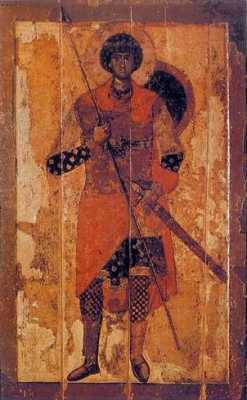 |
| Вмч. Георгий. Храмовая икона Георгиевского собора Юрьева монастыря под Новгородом, XII в., ныне в Государственной Третьяковской галерее. |
Георгий Победоно́сец (280 — 303/304), великомученик, чудотворец
Память 23 апреля в день кончины [1], 3 ноября в день обновления Георгиевского храма в Лидде в IV в., 10 ноября в память колесования (Груз.), 26 ноября в день освящения Георгиевской церкви в Киеве в 1051 г. (Рус. — «Юрьев день»), 30 января — воспоминание чуда вмч. Георгия в Закинфе — спасения от чумы 1688/1689 г. (Греч. [2])
Родился в 280 году [3] в Каппадокии [4], в знатной семье язычника Геронтия и христианки Полихронии. Мать воспитала Георгия в христианской вере. Однажды, заболев горячкой, Геронтий по совету сына призвал имя Христа и исцелился [5]. С этого момента он также стал христианином, и вскоре сподобился принять мучения и смерть за свою веру. Это произошло, когда Георгию было 10 лет [6]. Овдовевшая Полихрония переселилась с сыном в Палестину, где была её родина и богатые владения.
Поступив в 18 лет на военную службу, Георгий выделялся среди прочих воинов своим умом, храбростью, физической силой, воинской осанкой и красотой. Достигнув вскоре звания трибуна, он проявил такую храбрость в бою, что обратил на себя внимание и сделался любимцем императора Диоклетиана — талантливого правителя, но фанатичного приверженца языческих римских богов, учинившего одно из жесточайших гонений на христиан. Ещё не знавший о Христианстве Георгия, Диоклетиан почтил его саном комита и воеводы.
С того времени как Георгий убедился, что неправедный замысел императора об истреблении христиан не может быть отменён, он решил, что настало время, которое послужит ко спасению его души. Тотчас он раздал всё свое богатство, золото, серебро и драгоценные одежды нищим, бывшим при себе рабам даровал свободу, а о тех рабах, которые находились в палестинских его владениях, распорядился, чтобы одни из них были освобождены, а другие переданы неимущим. После этого он явился на совещание императора и патрициев об истреблении христиан и мужественно обличил их в жестокости и несправедливости, объявив себя христианином и приведя сборище в смятение.
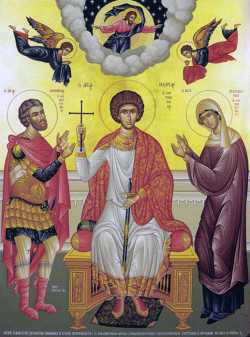 |
| Вмч. Георгий Победоносец и его родители мч. Геронтий и мц. Полихрония. Греческая икона |
После безрезультатных уговоров отречься от Христа император приказал подвергнуть святого различным мучениям. Георгий был заключён в темницу, где его положили спиной на землю, ноги забили в колодки, а на грудь положили тяжёлый камень. Но святой мужественно переносил страдания и прославлял Господа. Тогда мучители Георгия начали изощряться в жестокости. Они били святого воловьими жилами, колесовали, бросали в негашёную известь, принуждали бежать в сапогах с острыми гвоздями внутри, поили ядом. Святой мученик всё терпеливо переносил, непрестанно призывая Бога и будучи затем чудесно исцеляем. Его исцеление после нещадного колесования обратило ко Христу ранее уже оглашённых преторов Анатолия и Протолеона, а также, по одному преданию, императрицу Александру, супругу Диоклетиана. Когда призванный императором волхв Афанасий предложил Георгию воскресить мёртвого, святой вымолил у Бога это знамение, и множество народа, включая и самого́ бывшего волхва, обратились ко Христу. Неоднократно богоборец-император спрашивал Георгия, каким «волхованием» тот достигает презрения мук и исцеления, но великомученик отвечал твёрдо, что спасается лишь призыванием Христа и Его силою.
Когда великомученик Георгий пребывал в темнице, к нему приходили люди, от его чудес уверовавшие во Христа, давали страже золото, припадали к ногам святого и наставлялись им во святой вере. Призыванием имени Христова и крестным знамением святой исцелял и больных, во множестве приходивших к нему в темницу. Среди них был и земледелец Гликерий, чей вол разбился до смерти, но был возвращён к жизни по молитве святого Георгия.
В конце концов император, видя, что Георгий не отрекается от Христа и приводит всё больше людей к вере в Него, решил устроить последнее испытание и предложил ему стать своим соправителем, если тот принесёт жертву языческим богам. Георгий проследовал с императором в капище, но вместо жертвоприношения изгнал оттуда бесов, обитавших в статуях, отчего идолы сокрушились, а собравшийся люд набросился на святого в ярости. Тогда император приказал отрубить ему мечом голову. Так святой страдалец отошел ко Христу в Никомидии 23 апреля 303 года [7].
Мощи и почитание
Слуга Георгия, записывавший все его подвиги, также получил от него завет предать его тело погребению в родовых палестинских владениях. Мощи святого Георгия положили в палестинском городе Лидда, в храме, получившем его имя, глава же его хранилась в Риме в храме, тоже посвященном ему. Святитель Димитрий Ростовский добавляет, что в Римском храме также сохранялись его копьё и хоругвь. Десница святого ныне пребывает на Афоне в монастыре Ксенофонт в серебряной раке.
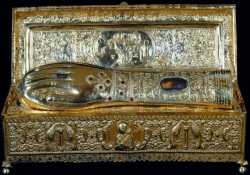 |
| Десница святого Георгия Победоносца. Монастырь Ксенофонт |
Великомученика Георгия за мужество и за духовную победу над мучителями, которые не смогли заставить его отказаться от христианства, а также за чудодейственную помощь людям в опасности, стали называть Победоносцем.
Святой Георгий прославился своими великими чудесами, из которых самым знаменитым является его чудо о змие. По преданию, недалеко от города Бейрута [8] в озере жил змей, который часто пожирал людей той местности. Суеверные жители для утоления ярости змея начали регулярно по жребию отдавать ему на съедение юношу или девицу. Однажды жребий выпал на дочь правителя. Её отвели к берегу озера и привязали, где она в ужасе стала ожидать появления чудовища. Когда же зверь стал приближаться к ней, вдруг появился на белом коне светлый юноша, поразил копьём змея и спас девицу. Этим юношей был святой Георгий, своим явлением прекративший жертвоприношения и обративший ко Христу жителей той страны, до этого бывших язычниками.
В Византии чудеса святого Георгия послужили поводом к почитанию его покровителем воинов, землепашцев (имя Георгий происходит от греч. слова γεωργός — земледелец) и особенно пастухов. Георгий Сфрандзи называет Георгия «освободителем пленников» [9], а в Каппадокии великомученик почитался как защитник путешественников. В народном представлении сложился образ строгого и справедливого святого [10]. В Греции в праздник святого 23 апреля проводились крестные ходы с иконой вмч. Георгия вокруг полей, устраивались скачки на лошадях (в память «чуда о змии»), закалывался посвященный великомученику агнец (айгеоргитис), кровью которого священник смазывал крестообразно лоб и щеки детей. «Чудо Георгия о змие» — излюбленный сюжет в иконографии святого, который изображается верхом на белом коне, копьем поражающим змея. Этот образ также символизирует победу над диаволом — «древним змием» (Откр. 12, 3; 20, 2).
Кроме чудес, зафиксированных в византийских агиографических сочинениях, сверхъестественные события, связанные с заступничеством Георгия, были отмечены, например, в 1593 году (явление великомученика Мураду III, после которого султан отказался от своего намерения разрушить церковь во имя вмч. Георгия в башне Фенер-капысы и отправил туда богатые дары), в 1689 году (прекращение эпидемии чумы на острове Закинф по молитве Георгия.). Образ Георгия запечатлен в народной греческой поэзии [11].
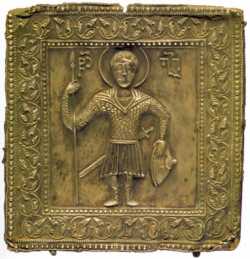 |
| Св. Георгий Победоносец. Серебро, X — XI вв., Музей Изобразительных Искусств в Тбилиси, 19 х 18,5 см. |
В Грузии
Вместе с Пресвятой Богородицей, мученик Георгий считается небесным покровителем Грузии и является у грузин самым почитаемым святым. Во многих языках Грузия называется «Георгией», и широко распространена версия о том, что это имя было дано Иверии именно в честь святого Победоносца.
По преданию, сохраняемому Грузинской Православной Церковью, святая равноапостольная Нина, просветительница Грузии была двоюродной сестрой святого Георгия. Она особо почитала его, установила праздновать день его колесования и завещала новообращённым грузинам любить великого святого. Первый храм в честь святого Геогрия был построен в Грузии уже в 335 году царём Мирианом на месте погребения святой Нины, а с IX века строительство церквей в честь Георгия стало массовым. В сражениях его часто наяву видели среди грузинского войска. Большинство грузинских церквей, особенно сельских, возведены в его честь, так что каждый день в Грузии праздновался день святого великомученика Георгия, связанный с какой либо из церквей его имени, или с его иконой, или же с чудом Победоносца.
Георгиевский крест украшает грузинский флаг. Впервые он появился на грузинских знамёнах при святой царице Тамаре.
 |
| Чудо Георгия о змие, спасении царевны и града, и об избавлении пленника. Фреска XVI в., скит св. Анны, Греция. |
В Арабских странах
Особенным почитанием святой Георгий пользуется в арабских землях, с которыми связаны предания о многих его чудесах, начиная с чуда о змие. Ещё одно примечательное чудо, получившее отражение в характерной местной иконографии святого, это чудо в Рамеле. Некий сарацин выстрелил в икону святого Георгия из лука, после чего у него опухла и стала нестерпимо болеть рука, так что он умирал от боли. Христианский священник посоветовал сарацину на ночь возжечь перед иконой святого Георгия лампаду, а утром помазать руку маслом из лампады. Сарацин послушался, а когда рука чудесно исцелилась, уверовал во Христа. Другие сарацины за это предали его мученической смерти. Этот уверовавший сарацин, даже имя которого не дошло до нас, изображается в местном варианте иконы чуда о змие как маленькая фигура с лампадой в руках, сидящая на крупе коня позади святого Георгия. Такой образ святого Георгия распространен не только среди местных православных, но также и среди коптов [12]. Он также перекочевал в Грецию и на Балканы.
В Египте и Эфиопии
В Египте почитание Георгия наложилось на культ бога Гора. Мученичество Георгия, написанное на коптском языке, возникло в VI — нач. VII века, а цикл чудес сложился до арабского завоевания. Согласно данным папирусов V — VIII веков, почитание Георгия отмечено в Афродито, Джеме (копт. Чеме, араб. Мединет-Абу), Гермополе, Оксиринхе, Птолемаиде и др. городах. Древнейшее упоминание о праздновании вмч. Георгия засвидетельствовано в т. н. Календаре Саккары (VIII век). В Египте вмч. Георгию было посвящено много церквей и монастырей, наиболее известны в Мит-Дамсисе (к северу от Мит-Гамра) и в Дельте. В Коптском Синаксаре особо указывается под 3 паопе (араб. бауна) освящение первой церкви во имя вмч. Георгия в г. Бирма, в оазисе Бахария. Синаксарь указывает, что мощи Георгия, хранившиеся в этой церкви, в патриаршество Матфея I (1378-1409) были перенесены в монастырь авы Самуила, а при патриархе Гаврииле V (1409-1428) — в церковь во имя вмч. Георгия в Старом Каире. В настоящее время, по свидетельству О. Мейнардуса, частицы мощей вмч. Георгия находятся в 15 церквах и монастырях Египта. Из Египта почитание вмч. Георгия проникло в Эфиопию [11].
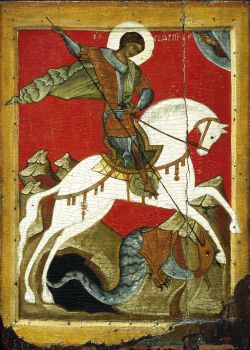 |
| Чудо св. Георгия о змие. Новгородская икона (XIV — нач. XV в.). Санкт-Петербург, Государственный Русский музей |
На Руси
На Руси особое почитание великомученика Георгия распространилось с первых лет по принятии Христианства. Благоверный князь Ярослав Мудрый, во святом крещении Георгий, следуя благочестивому обычаю русских князей основывать храмы в честь своих ангелов-хранителей, положил начало храму и мужской обители в честь великомученика Георгия. Храм находился перед вратами Святой Софии в Киеве, на его строительство князь Ярослав затратил большие средства, в возведении храма принимало участие большое число строителей. 26 ноября 1051 года храм был освящен святителем Иларионом, митрополитом Киевским, и установлено ежегодное празднование в честь этого события. В «Юрьев день», как его стали называть, или на «осеннего Георгия» до времён царствования Бориса Годунова крестьяне могли свободно переходить к другому помещику.
Изображение всадника, поражающего змия, известное на русских монетах с раннего времени, впоследствии стало символом Москвы и Московского государства.
В дореволюционное время в день памяти святого Георгия жители русских деревень в первый раз после холодной зимы выгоняли скот на пастбище, совершив молебен святому великомученику с окроплением домов и животных святой водой.
В Англии
Святой Георгий — покровитель Англии со времён короля Эдмунда III. Английский флаг представляет собой Георгиевский крест. Английская литература неоднократно обращалась к образу святого Георгия как воплощения «старой доброй Англии», в частности в известной балладе Честертона.
Молитвословия
Тропарь, глас 4
Я́ко пле́нных свободи́тель/ и ни́щих защи́титель,/ немощству́ющих вра́ч,/ царе́й побо́рниче,/ победоно́сче великому́чениче Гео́ргие,/ моли́ Христа́ Бо́га// спастися душам нашим.
Ин тропарь, глас тот же
По́двигом до́брым подвиза́лся еси́,/ страстоте́рпче Христо́в,/ ве́рою и мучи́телей обличи́л еси́ нечестие,/ же́ртва же благоприя́тна Бо́гу прине́слся еси́./ Те́мже и вене́ц прия́л еси́ побе́ды/ и моли́твами, свя́те, твои́ми// все́м подае́ши прегреше́ний проще́ние.
Кондак, глас 4 (Подобен: Вознесыйся:)
Возде́лан от Бо́га, показа́лся еси́/ благоче́стия де́латель честне́йший,/ доброде́телей рукоя́ти собра́в себе́:/ се́яв бо в слеза́х, весе́лием жне́ши,/ страда́льчествовав же кро́вию, Христа́ прия́л еси́/ и моли́твами, свя́те, твои́ми// все́м подае́ши прегреше́ний проще́ние.
Кондак из службы Обновления храма святого Георгия в Лидде, глас 8 (Подобен: Взбранной:)
К возбра́нному и ско́рому заступле́нию Твоему́/ прибе́гше, ве́рнии,/ мо́лим изба́витися, страстоте́рпче Христо́в,/ от собла́зн вра́жиих воспева́ющим тя́,/ и вся́ких бе́д, и озлобле́ний, да зове́м:// ра́дуйся, му́чениче Гео́ргие.
Тропарь из службы освящения церкви вмч. Георгия в Киеве, глас 4
Дне́сь блажа́т тя́ ми́ра концы́,/ Боже́ственных чуде́с испо́лншеся,/ и земля́ ра́дуется, напи́вшися кро́ве твоея́./ Христоимени́тии же лю́дие гра́да Ки́ева/ освяще́нием Боже́ственнаго хра́ма твоего́/ ра́достию возвесели́шася,/ страстоте́рпче Гео́ргие,/ сосу́де избра́нный Свята́го Ду́ха, уго́дниче Христо́в./ Его́же моли́ с ве́рою и мольбо́ю приходя́щим во святы́й тво́й хра́м/ да́ти очище́ние грехо́в,// умири́ти ми́р и спасти́ ду́ши на́ша.
Кондак из службы освящения церкви вмч. Георгия в Киеве, глас 2 (Подобен: Твердый:)
Боже́ственнаго и венцено́снаго великому́ченика Христо́ва Гео́ргия,/ на враги́ побе́ду взе́мшаго одоле́ния,/ соше́дшеся ве́рою во освяще́нный хра́м, восхва́лим,/ его́же благоволи́ Бо́г созда́ти во и́мя его́,// Еди́н во святы́х почива́яй.
Использованные материалы
- Свт. Димитрий Ростовский, Жития Святых:
- http://ru.wikisource.org/wiki/Жития_святых_(Димитрий_Ростовс…/23
- «Великомученик Георгий Победоносец» // Православие.ru:
- http://days.pravoslavie.ru/Life/life6523.htm
- «Освящение церкви святого великомученика Георгия в Киеве» // Православие.ru:
- http://days.pravoslavie.ru/Life/life3228.htm
- Березин, И. Н., Русский энциклопедический словарь, Том V, Санкт-Петербург, 1875.
- Сегень А. Ю., «Египет — вторая родина Христа» (продолжение — «Коптские иконы»), Православная газета. Екатеринбург, 2007, № 9:
- http://orthodox.etel.ru/2007/09/egipet.htm
- Минея-апрель, ч. 2. Изд. Московской Патриархии, сс. 142, 149:
- http://files2.regentjob.ru/minea/apr2/apr2142.html — тропари
- http://files2.regentjob.ru/minea/apr2/apr2149.html — кондак
- Минея-ноябрь, ч. 1. Изд. Московской Патриархии, с. 67:
- http://files2.regentjob.ru/minea/nov1/nov167.html — кондак на освящение церкви в Лидде
- Минея-ноябрь, ч. 2. Изд. Московской Патриархии, с. 391, 395:
- http://files2.regentjob.ru/minea/nov2/nov2391.html — тропарь на освящение храма в Киеве
- http://files2.regentjob.ru/minea/nov2/nov2395.html — кондак на освящение храма в Киеве
[1] В новостильной Болгарской Церкви его память («Гергьовден, Ден на храбростта и българската армия») празднуется в этот же день — 6 мая н. ст. См. Месяцеслов на официальном сайте Болгарской Патриархии, http://bg-patriarshia.bg/calendar.php?month=04; «Църковен календар, жития и проповеди» на болгарском сайте «Православие», http://www.pravoslavieto.com/1/calendar.htm#4.
[2] «Μνήμη θαύματος Μεγαλομάρτυρος Γεωργίου στὴ Ζάκυνθο», страница греческого сайта Μέγας συναξαριστής (Большой месяцеслов), по кн.: Αγαθάγγελος (Χαραμαντίδης), Επ. Φαναρίου, Μέγας συναξαριστής (Епископ Фанарийский Агафангел, Синаксарь Православной Церкви), Αποστολικής Διακονίας της Εκκλησίας της Ελλάδος, — http://www.synaxarion.gr/gr/sid/1957/sxsaintinfo.aspx
[3] «Ὁ Ἅγιος Γεώργιος ὁ Μεγαλομάρτυρας ὁ Τροπαιοφόρος», страница греческого сайта ΜΕΓΑΣ ΣΥΝΑΞΑΡΙΣΤΗΣ (Большой месяцеслов), по кн.: Αγαθάγγελος (Χαραμαντίδης), Επ. Φαναρίου, ΜΕΓΑΣ ΣΥΝΑΞΑΡΙΣΤΗΣ (Епископ Фанарийский Агафангел, «Синаксарь Православной Церкви»), Αποστολικής Διακονίας της Εκκλησίας της Ελλάδος, http://www.synaxarion.gr/gr/sid/2743/sxsaintinfo.aspx.
[4] Так в «Житиях» святителя Димитрия Ростовского. По другим данным — в городе Белит (ныне Бейрут), у подножия Ливанских гор. См. http://days.pravoslavie.ru/Life/life6523.htm
[5] Виноградов А. Ю. Георгий. Раздел «Мученичество» // Православная энциклопедия, т. 10, с. 665-692, http://www.pravenc.ru/text/162188.html.
[6] «Память святого великомученика Георгия Победоносца … » // Синаксарь. Жития святых Православной Церкви. Автор-составитель иеромонах Макарий Симонопетрский. Адаптированный перевод с французского. В 6 тт. — М.: Издательство Сретенского монастыря, 2011. — Т. IV. — С. 658.
[7] По другим данным, включая житие у свт. Димитрия Ростовского, — 304 года.
[8] в соответствии с этой традицией святой родился в этих местах, а не в Каппадокии.
[9] Sphrantzes. Hist. 19. 1.
[10] Χαλκιᾶ-Στεφάνου Π. Οἱ ̀λδβλθυοτεΑγιοι Γεώργιοι. ᾿Αθήνα, 1996. Σ. 62.
[11] О.В.Л. Георгий. Раздел «Почитание в Византии» // Православная энциклопедия, т. 10, с. 665-692, http://www.pravenc.ru/text/162188.html
[12] Сегень А. Ю., «Египет — вторая родина Христа» (продолжение — «Коптские иконы»), Православная газета. Екатеринбург, 2007, № 9, http://orthodox.etel.ru/2007/09/egipet.htm
Георгий Победоносец — христианский святой, великомученик. Георгий пострадал во время гонений на христиан при императоре Диоклетиане в 303 году, после восьмидневных тяжких мучений был обезглавлен. Память великомученика Георгия Победоносца совершается несколько раз в год: 6 мая (23 апреля ст. ст.) — гибель святого; 16 ноября (3 ноября ст. ст.) — освящение храма великомученика Георгия в Лиде (IV век); 23 ноября (10 ноября ст. ст.) — страдание (колесование) великомученика Георгия; 9 декабря (26 ноября ст. ст.) — освящение церкви великомученика Георгия в Киеве в 1051 году (празднование Русской Православной Церкви, известное в народе как осенний Юрьев день).
Содержание
- Великомученик Георгий Победоносец. Жизнеописание
- Чудеса великомученика Георгия Победоносца
- Великомученик Георгий Победоносец. Почитание
- Великомученик Георгий Победоносец. Тропарь и кондак святому
- Великомученик Георгий Победоносец. Иконы
- Великомученик Георгий Победоносец. Картины
- Великомученик Георгий Победоносец. Скульптуры
- Храмы во имя Георгия Победоносца
- Старообрядческие храмы во имя великомученика Георгия Победоносца
- Великомученик Георгий Победоносец. Народные традиции
Великомученик Георгий Победоносец. Жизнеописание
Великомученик Георгий Победоносец родился в III веке в семье христиан в Лиде. Поступив на военную службу, Георгий отличился умом, мужеством и стал одним из тысяченачальников и любимцем императора Диоклетиана (245-313 гг.). Его мать скончалась, когда ему было 20 лет, и он получил богатое наследство. Георгий отправился ко двору, надеясь достичь высокого положения, но, когда начались гонения на христиан, он, будучи в Никомидии, раздал имущество бедным и перед императором объявил себя христианином, его арестовали и стали пытать. В первый день, когда его стали толкать в темницу кольями, одно из них сломалось чудесным образом, словно соломинка. Затем его привязали к столбам, а на грудь положили тяжелый камень. На второй день его пытали колесом, которое было утыкано ножами и мечами. Диоклетиан подумал, что Георгий мертв, но вдруг явился ангел, и мученик приветствовал его, как это делали воины. Тогда император понял, что Георгий выжил, а все раны, которые нанесли ему, чудесным образом зажили. Затем его бросили в яму с негашеной известью, но и это не навредило святому. Через день ему перебили кости на руках и ногах, но наутро они опять стали невредимы. Его заставили бежать в раскаленных докрасна железных сапогах. Всю следующую ночь он молился и наутро опять предстал перед императором. Его избили воловьими жилами так, что со спины слезла кожа, но Господь снова даровал ему исцеление. На 7 день мучений его принудили выпить две чаши с зельем, которое было приготовлено волхвом Афанасием. От одной чаши Георгий должен был лишиться разума, а от второй — умереть. Но они не навредили ему. Георгий совершил несколько чудес: воскресил умершего и оживил павшего вола. Благодаря этому многие из видевших чудеса уверовали во Христа. После бесполезных уговоров отречься от Господа и принести языческое жертвоприношение Георгия приговорили к смерти. В эту ночь ему во сне явился Христос с золотым венцом на голове и сказал, что его ожидает Рай. Георгий тотчас позвал слугу, который записал все сказанное (один из апокрифов написан от лица именно этого слуги), и велел после смерти отвезти свое тело в Палестину.
В конце мучений Георгия император Диоклетиан спустился в темницу и снова предложил мученику отречься от Христа. Георгий на это сказал: «Отнесите меня в храм Аполлона». И когда его отвели туда, Георгий встал в полный рост перед статуей и сказал: «Неужели ради тебя я иду на заклание? И можешь ли ты принять от меня эту жертву, как Бог?» При этом Георгий осенил себя и статую Аполлона крестным знамением — и этим вынудил беса, обитавшего в статуе, объявить себя падшим ангелом. После этого рухнули все идолы в храме. Разозлившись, жрецы кинулись избивать Георгия. В это время в храм прибежала жена императора — Александра, она бросилась к ногам великомученика и, рыдая, просила простить за грехи ее мужа-мучителя. Она обратилась в христианство благодаря случившимся только что чудесам. Диоклетиан разгневался и велел отсечь головы Георгию и своей супруге. Георгий, помолившись, со спокойной улыбкой положил голову на плаху. Вместе с Георгием приняла смерть царица Александра Римская, которая названа в Житии супругой императора Диоклетиана. Она предала Богу свой дух по молитве св. Георгия по дороге на казнь (Макарьевские Четьи Минеи, 23 апреля). Другие исторические источники сообщают, что жену императора звали Приска. Как сообщает предание, святой Георгий был погребен в городе Лида. Над его гробницей был сооружен храм, который ныне принадлежит Иерусалимской православной церкви. Глава и меч святого Георгия хранятся под главным алтарем в римской базилике Сан-Джорджио-ин-Велабро. Частица мощей великомученика Георгия Победоносца хранится в храме-реликварии Сент-Шапель в Париже. Мощи великомученика Георгия Победоносца, его десница, хранится в серебряной раке на святой горе Афон, в монастыре Ксенофонта.
Чудеса великомученика Георгия Победоносца
Одним из самых известных посмертных чудес святого Георгия является убийство копьем змея, который опустошал языческий город Гевал в стране Палестинской. Когда выпал жребий отдать на растерзание чудовищу царскую дочь, явился Георгий на коне и пронзил змея копьем, избавив царевну от смерти. Явление святого способствовало обращению местных жителей в христианство (Четьи Минеи митрополита Макария, 23 апреля). В многочисленных версиях и редакциях сказания о чуде Георгия о змие присутствуют разные названия города: Ласия, Гевал, Вирит, и т. д. Город Гевал упоминается в древнерусской редакции повести «Чудо, бывшее со святым великомучеником Георгием о змии», которая опубликована по списку XVI в. (Древнерусская редакция повести публикуется по списку XVI в. — РНБ, Погодинское собрание, 808, лл. 178—186 об.). Повесть основана на широко известном многим народам эпическом сказании о герое-змееборце; это сказание оказало большое влияние на развитие многих жанров народного творчества, в том числе и русского (былины, сказки, духовные стихи), отразилось в изобразительном искусстве и сделало популярным в народной среде имя Георгия Победоносца. Город Ласия указан на иконописных изображениях Чуда Георгия о змие (например, икона Чудо Георгия о змие из монастыря Дечаны в Сербии, до 1350 г.), но т.к. надписи на иконах не редактировали, как в Повести, их можно считать верными. В Четьих Минеях Преображенской печати 7423 года (напечатано с оригиналов киевской печати со ссылкой на рукописи) указано, что Чудо Георгия о змие произошло в городе Вирите.
Одно из чудес великомученика Георгия повествует о том, как в Сирии, где не было больших камней для столбов, которые должны были поддерживать здание, эти камни покупались в далеких странах и привозились морем. Так поступила и одна вдова, купившая хороший столб и умолявшая градоначальника взять его на корабль, чтобы отвезти к строящемуся храму Георгия великомученика. Тот не внял мольбам бедной женщины и отплыл, а она упала на землю и, горько рыдая, призывала в молитве святого Георгия. В слезах она заснула и увидела во сне явившегося ей Георгия на коне, который спросил, о чем она так скорбит. Вдова рассказала святому о своем горе. «Где хочешь поставить столб?» — спросил святой. «На правой стороне церкви», — ответила женщина. Тогда святой написал на столбе пальцем, где этот дар вдовы должен быть поставлен по ее желанию. Вместе с женщиной они подняли столб, который вдруг стал легким, и опустили в море. Проснувшись, вдова не обнаружила на прежнем месте столба, а когда вернулась домой, то оказалось, что ее столб с надписью, сделанной рукой святого, уже лежал на берегу. Градоначальник раскаялся в содеянном прегрешении, а столб вдовы был поставлен на том месте, где и было велено.
В том же сирийском городе Рамеле, уже завоеванном сарацинами, в церковь святого Георгия во время службы зашло несколько сарацин, и один из них, взяв лук, пустил стрелу в икону великомученика. Но стрела полетела вверх и, падая оттуда, вонзилась самому стрелку в руку. Рука раздулась, очень болела, и сарацин, мучаясь от страшных страданий, признался во всем своим служанкам, среди которых было несколько христианок. Они посоветовали хозяину позвать священника, и тот объяснил варвару, кто был святой Георгий и почему он получил от Бога благодать творить чудеса. По совету священника сарацин приказал принести к себе в дом икону великомученика Георгия, поставил над своей постелью, молился перед ней и смазал руку маслом из лампады. Сарацин исцелился, уверовал в Бога, тайно крестился, а потом начал на площади города громогласно проповедовать учение Христа как истинного Бога. Новообращенный сарацин принял мученический венец, ибо тут же был разрублен своими бывшими единоверцами на части.
Чудо о плененном пафлагонском юноше повествует об избавлении молодого человека, захваченного в плен агарянами в церкви великомученика Георгия во время торжества в день памяти святого. Год пробыл он в плену у агарянского князя, и через двенадцать месяцев, точно в тот день, когда юноша был захвачен иноверцами, по молитвам его бедной матери пленник был чудесным образом возвращен родителям. Он только что прислуживал агарянскому князю за столом и явился перед пораженными родителями прямо с сосудом для вина в руках. Рассказывая о том, что произошло, юноша сказал: «Я налил вино, чтобы подать князю, и вдруг поднят был светлым всадником, который посадил меня к себе на коня. Я держал в одной руке сосуд, а другой держался за его пояс, и вот очутился здесь…».
Великомученик Георгий Победоносец. Почитание
Легенды о великомученике Георгии излагали Симеон Метафраст (вторая половина X века), Андрей Иерусалимский (ок. 660–740 гг.), Григорий Кипрский (1241–1289 гг.). В традиции Византийской империи существует легендарная связь между Георгием Победоносцем и святыми воинами Феодором Стратилатом (ум. 319 г.) и Феодором Тироном (306 г.). Исследователи объясняют это тем, что Галатия и Пафлагония, которые являлись центрами почитания святых Феодоров, были недалеко от Малой Азии и Каппадокии, где почитали святого Георгия. Латинские тексты Жития великомученика Георгия изначально являлись переводами греческих текстов, но со временем стали сильно отличаться от них. Они сообщают, что по дьявольскому наущению персидский император Дациан, повелитель 72-х царей, подверг жестоким гонениям христиан. В это время жил некий Георгий из Каппадокии, уроженец Мелитены. Его подвергли многочисленным пыткам. После каждой пытки Георгий снова исцелялся. Мучения продолжались 7 дней. Его стойкость и чудеса обратили в христианство 40 900 человек, в том числе и царицу Александру. Когда по приказу Дациана казнили Георгия и Александру, с неба сошёл огненный вихрь и испепелил самого императора. К наиболее ранним источникам апокрифических сказаний о святом Георгии относят:
- Венский палимпсест (V век);
- «Мученичество Георгия», упоминаемое в Декрете папы Геласия (ранняя редакция конец V — начало VI веков). Геласий отвергает акты мученичества святого Георгия как еретическую фальсификацию и относит Георгия к святым, которые более известны Богу, чем людям;
- «Деяния Георгия» (Нессанские отрывки) (VI век, найдены в 1937 году в пустыне Негев).
Апокрифическая агиография относит мученичество Георгия к правлению персидского или сирийского правителя Дадиана. Житие «Страдание славного великомученика Георгия» Феодора Дафнопата, жившего в X веке, называет Дадиана топархом Сирии и племянником императора Диоклетиана. По этому апокрифу казни Георгия приказывал делать Диоклетиан, Дадиан при этом требовал усилить пытки, и присутствовал также Максимиан. Мученичества святого Георгия известны в латинских, сирийских, грузинских, армянских, коптских, эфиопских и арабских переводах, которые содержат различные подробности о перенесенных святым страданиях. Один из лучших текстов его жития находится в славянской Минее. В исламе Георгий (Джирджис, Гиргис, Эль-Худи) является одной из главных некоранических фигур, и легенда его весьма похожа на греческую и латинскую. Жил он в те же времена, что и пророк Мухаммед. Аллах послал его к правителю Мосула с призывом принять истинную веру, но владыка повелел казнить его. Его казнили, но Аллах его воскресил и послал обратно к правителю. Его казнили во второй раз, затем в третий (сожгли и пепел бросили в Тигр). Он восстал из пепла, а властитель и его приближенные были истреблены. Житие святого Георгия было переведено на арабский язык в начале VIII века, и под влиянием арабов-христиан почитание святого Георгия проникло в среду арабов-мусульман. Греческий историк XIV века Иоанн Кантакузин отмечает, что в его время существовало несколько храмов, возведенных мусульманами в честь святого Георгия. Великомученик Георгий Победоносец почитался еще со времен раннего христианства. В Римской империи, начиная с IV века, возникали церкви, посвященные Георгию: сначала в Сирии и Палестине, затем и на всем Востоке. На Западе империи почитание святого проявилось не позднее V века, о чем свидетельствуют как апокрифические тексты и жития, так и церкви, известные в Риме с VI века, в Галлии — с V века. По одной из версий, святого Георгия противопоставляли языческому культу Диониса, строились храмы на месте прежних святилищ Диониса. Георгий считается покровителем воинов, земледельцев (имя Георгий происходит от греч. γεωργός — земледелец) и пастухов, а в ряде мест — путешественников. Интересно, что святого Георгия также почитают балканские и румынские цыгане. В Сербии, Болгарии и Македонии верующие обращаются к нему с молитвами о ниспослании дождя.
В Грузии к Георгию обращаются с просьбами о защите от зла, о даровании удачи на охоте, об урожае и приплоде скота, об исцелении от болезней, о чадородии. На Западе святой Георгий почитается как покровитель рыцарства, участник крестовых походов. Святой Георгий известен исламским народам Африки и Ближнего Востока под именами Джирджис и аль-Хидр. На Руси с древних времен великомученик Георгий почитался под именем Юрий или Егорий. В 1030 годах великий князь Ярослав основал в Киеве и Новгороде монастыри святого Георгия (Юрьев монастырь) и повелел по всей Руси «творити праздник» святого Георгия 26 ноября (ст. ст.). В русской народной культуре Георгия почитали как покровителя воинов, земледельцев и скотоводов. 23 апреля и 26 ноября (ст. ст.) известны под именем весеннего и осеннего дней святого Георгия. В весенний Юрьев день крестьяне первый раз после зимы выгоняли скот на поля. Изображения святого Георгия встречаются издревле на великокняжеских монетах и печатях. Великомученик Георгий вместе с Богородицей считается небесным покровителем Грузии и является у грузин самым почитаемым святым. В Греции 23 апреля отмечают Агиос Георгиос — праздник Святого Георгия, покровителя пастухов и хлеборобов, давно уже превратившийся в один из главных сельских фестивалей страны. Если даты его проведения приходятся на Великий пост, празднества переносятся на первый понедельник после Пасхи.
Со времен Димитрия Донского святой Георгий считается покровителем Москвы, поскольку город был основан тезоименным ему князем Юрием Долгоруким. Изображение всадника, поражающего копьем змия, с рубежа XIV-XV веков появляющееся в московской геральдике, в народном сознании воспринималось как образ святого Георгия; в 1730 г. это было закреплено официально. В настоящее время эта фигура в гербе Российской Федерации описывается как «серебряный всадник в синем плаще на серебряном коне, поражающий серебряным копьем черного опрокинутого навзничь и попранного конем дракона», то есть без прямой ссылки на святого Георгия, и изображается без нимба. Великий князь Киевский Ярослав Мудрый в честь своего святого покровителя Георгия основал и назвал следующие города: Юрьев (Гюргев, ныне Тарту) и Юрьев Русский (сейчас Белая Церковь). В 1152 году Юрием Долгоруким был основан Юрьев-Польский. В 1225 году владимирским князем Юрием Всеволодовичем был основан город на месте явления ему иконы великомученика Георгия Победоносца. Город получил название в честь святого Юрьев-Повольский, современное название — Юрьевец.
Память великомученика Георгия Победоносца совершается несколько раз в год: 6 мая (23 апреля ст. ст.) — гибель святого; 16 ноября (3 ноября ст. ст.) — освящение храма великомученика Георгия в Лиде (IV век); 23 ноября (10 ноября ст. ст.) — страдание (колесование) великомученика Георгия; 9 декабря (26 ноября ст. ст.) — освящение церкви великомученика Георгия в Киеве в 1051 году (празднование Русской Православной Церкви, известное в народе как осенний Юрьев день). В Католической церкви память святому Георгию совершается 23 апреля.
Библиотека Русской веры
Поучение на память великомученика Георгия Победоносца. Великие Минеи Четьи →
Читать онлайн в оригинале
Великомученик Георгий Победоносец. Тропарь и кондак святому
Тропарь, глас 4:
П0двигомъ д0брымъ подвизaсz, страстотeрпче хrт0въ вёрою, и3 мучи1телємъ њбличи1лъ є3си2 нечeстіе. жeртва же бlгопріsтна бGови принесeсz, тёмъ же и3 вэнeцъ пріsтъ побёды, и3 моли1твами с™е твои1ми, всёмъ даeши согрэшeніемъ њставлeніе.
Подвигом добрым подвизася, страстотерпче Христов Георгие, веры ради мучителем обличил еси нечестие, жертва же благоприятна Богови принесеся. Отнюду же и венец прият победы, и молитвами твоими святе, всем даеши грехов прощение.
Кондак, глас 4:
Воздёланъ бGомъ ты2 показaсz, бlгочeстіz дёлатель чeстенъ, добродётелей рукоsти собрA себЁ. сёzвъ бо со слезaми, весeліемъ жнeши. постарадaвъ же кр0вію, хrтA пріsтъ. и3 мlтвами с™е твои1ми, всёмъ даeши согрэшeнієм прощeніе.
Возделан Богом ты показася, благочестия делатель честен, добродетелей рукояти собра себе. Сеяв бо со слезами, веселием жнеши. Постарадав же кровию, Христа прият. И молитвами святе твоими, всем даеши согрешением прощение.
Библиотека Русской веры
Канон великомученику Георгию Победоносцу →
Читать онлайн
Великомученик Георгий Победоносец. Иконы
Уже к VI веку сформировались два типа изображения великомученика Георгия: мученик с крестом в руке, в хитоне, поверх которого плащ, и воин в доспехах, с оружием в руках, пеший или конный. Георгий изображается безбородым юношей, с густыми кудрявыми волосами, доходящими до ушей, иногда с венцом на голове.
С VI века Георгий часто изображается с другими воинами-мучениками — Феодором Тироном, Феодором Стратилатом и Димитрием Солунским. На объединение этих святых могло повлиять и подобие их обликов: оба юные, безбородые, с короткими, доходящими до ушей волосами.
Редко встречающийся иконографический извод — Георгий-воин, восседающий на троне, — возник не позже конца XII в. Святой представлен фронтально, сидящим на троне и держащим перед собой меч: правой рукой вынимает меч, левой придерживает ножны. В монументальной росписи святые воины могли изображаться на гранях подкупольных столпов, на подпружных арках, в нижнем регистре наоса, ближе к восточной части храма, а также в нартексе.
Иконография великомученика Георгия пришла на Русь из Византии. На Руси она претерпела некоторые изменения. Древнейшим из сохранившихся является поясной образ великомученика Георгия в Успенском соборе Московского Кремля. Святой изображен в кольчуге, с копьем; о мученическом подвиге напоминает его пурпурный плащ.
Образу святого из Успенского собора созвучна житийная икона великомученика Георгия XVI века из Успенского собора г. Дмитрова. Святой на среднике иконы изображен в рост; кроме копья в правой руке он имеет меч, который придерживает левой рукой, у него есть также колчан со стрелами и щит. В клеймах — эпизоды мученических страданий святого.
В основе иконографии Георгия на коне лежит позднеантичная и византийская традиции изображения триумфа императора. Различаются несколько вариантов: Георгий-воин на коне (без змея); Георгий-змееборец («Чудо великомученика Георгия о змии»); Георгий со спасенным из плена отроком («Чудо великомученика Георгия с отроком»).
Композиция «Двойное чудо» объединила два наиболее известных посмертных чуда Георгия — «Чудо о змии» и «Чудо с отроком»: Георгий изображен на коне (скачущем, как правило, слева направо), поражающим змея, а позади святого, на крупе его коня, — небольшая фигурка сидящего отрока с кувшином в руке.
На Руси сюжет Чудо Георгия о змие широко известен с середины XII века.
До конца XV века существовал краткий извод этого образа: всадник, поражающий копьем змия, с изображением в небесном сегменте благословляющей десницы Господа. В конце XV века иконография Чуда святого Георгия о змие дополняется рядом новых деталей: например, фигура ангела, архитектурные детали (город, который св. Георгий спасает от змия), изображение царевны. Но одновременно существует и немало икон в прежнем кратком изводе, но с разнообразными отличиями в деталях, в том числе в направлении движения коня: не только традиционное слева направо, но и в обратном направлении. Известны иконы не только с белым окрасом коня — конь может быть вороной или гнедой масти.
Иконография Чуда Георгия о змие сформировалась, вероятно, под влиянием античных изображений фракийского всадника. В западной (католической) части Европы святой Георгий обычно изображался как мужчина в тяжелых доспехах и шлеме, с толстым копьем, на реалистичном коне, который с физическим напряжением пронзает копьем относительно реалистичного змея с крыльями и лапами. В восточных (православных) землях отсутствует этот акцент на земном и материальном: не очень мускулистый юноша (без бороды), без тяжелых доспехов и шлема, с тонким, явно не физическим, копьём, на нереалистичном (духовном) коне, без особого физического напряжения, пронзает копьем нереалистичного (символического) змея с крыльями и лапами. Также великомученик Георгий изображается с избранными святыми.
Великомученик Георгий Победоносец. Картины
К образу великомученика Георгия неоднократно обращались живописцы в своих произведениях. В основе большинства работ лежит традиционный сюжет — великомученик Георгий, который поражает копьем змея. Святого Георгия на своих полотнах изображали такие художники, как Рафаэль Санти, Альбрехт Дюрер, Гюстав Моро, Август Маке, В.А. Серов, М.В. Нестеров, В.М. Васнецов, В.В. Кандинский и другие.
Великомученик Георгий Победоносец. Скульптуры
Скульптурные изображения святого Георгия находятся в Москве, в пос. Большеречье Омской области, в г. Иваново, Краснодаре, Нижнем Новгороде, Рязани, Крыму, в с. Частоозерье Курганской области, Якутске, Донецке, Львове (Украина), Бобруйске (Белоруссия), Загребе (Хорватия), Тбилиси (Грузия), Стокгольме (Швеция), Мельбурне (Австралия), Софии (Болгария), Берлине (Германия),
Храмы во имя Георгия Победоносца
Во имя великомученика Георгия Победоносца построено большое количество церквей, как в России, так и за рубежом. В Греции в честь святого освящены около двадцати церквей, а в Грузии — около сорока. Кроме этого, церкви в честь великомученика Георгия есть в Италии, Праге, Турции, Эфиопии и других странах. В честь великомученика Георгия приблизительно в 306 году была освящена церковь в Салониках (Греция). В Грузии находится монастырь святого Георгия Победоносца, построенный в первой четверти XI века. В V веке в Армении в с. Карашамб была построена церковь в честь Георгия Победоносца. В IV веке в Софии (Болгария) была построена ротонда святого Георгия.
Георгиевская церковь — один из первых монастырских храмов в Киеве (XI век). Упоминается в Лаврентьевской летописи, согласно которой освящение храма состоялось не ранее ноября 1051 года. Церковь была разрушена, возможно, вследствие общего упадка древней части Киева после разорения города ордами хана Батыя в 1240 году. Позднее храм был возобновлен; уничтожен в 1934 году.
Великомученику Георгию Победоносцу посвящен монастырь в Новгородской области. По преданию, обитель основана в 1030 году князем Ярославом Мудрым. Ярослав во святом крещении носил имя Георгий, которое в русском языке обычно имело форму «Юрий», откуда и пошло наименование монастыря.
В 1119 году было начато строительство главного монастырского собора — Георгиевского. Инициатором строительства был великий князь Мстислав I Владимирович. Строительство Георгиевского собора длилось более 10 лет, перед окончанием его стены были покрыты фресками, уничтоженными в XIX веке.
Во имя святого Георгия освящена церковь на Ярославовом Дворище в Великом Новгороде. Первое упоминание о деревянной церкви датируется 1356 годом. Жителями Лубяницы (лубянцами) — улицы, которая некогда проходила через Торг (городской рынок), была выстроена церковь в камне. Храм неоднократно горел и отстраивался вновь. В 1747 году обвалились верхние своды. В 1750-1754 годах церковь была вновь восстановлена.
Во имя Георгия Победоносца освящена церковь в с. Старая Ладога Ленинградской области (построена между 1180 и 1200 годами). Храм был впервые упомянут в письменных источниках лишь в 1445 году. В XVI веке церковь была перестроена, однако интерьер остался неизменным. В 1683-1684 годах была проведена реставрация церкви.
Во имя великомученика Георгия Победоносца освящен собор в Юрьеве-Польском (Владимирская область, построен в 1230-1234 годы).
В Юрьеве-Польском существовала Георгиевская церковь Михайло-Архангельского монастыря. Деревянная Георгиевская церковь из села Егорье была перенесена в монастырь в 1967-1968 годах. Эта церковь — единственная сохранившаяся постройка древнего Георгиевского монастыря, первое упоминание о котором относится к 1565 году.
Во имя великомученика Георгия освящен храм в Ендове (г. Москва). Храм известен с 1612 года. Современная церковь построена прихожанами в 1653 году.
В честь святого Георгия освящена церковь в Коломенском (г. Москва). Церковь была построена в XVI веке как колокольня в виде круглой двухъярусной башни. В XVII веке к колокольне с запада была пристроена кирпичная одноэтажная палата. В то же время колокольня была перестроена в церковь святого Георгия. В середине XIX веке к церкви была пристроена большая кирпичная трапезная.
Известна церковь Георгия на Красной горке в Москве. По разным версиям, Георгиевская церковь основана матерью царя Михаила Романова — Марфой. Но название церкви было записано еще в духовной грамоте великого князя Василия Темного, а в 1462 году обозначалась каменной. Вероятно, из-за пожара храм сгорел, а на его месте инокиня Марфа построила новую, деревянную церковь. В конце двадцатых годов XVII века церковь сгорела. В 1652-1657 гг. храм был возобновлен на возвышенности, где проходили народные гулянья на Красную Горку.
Во имя святого Георгия освящена церковь в г. Ивантеевке (Московская область). Первые исторические сведения о храме относятся к 1573 году. Вероятно, деревянная церковь была построена в 1520-1530 годы. К концу 1590-х годов церковь была построена заново и служила прихожанам до 1664 года, когда братья Бирдюкины-Зайцевы получили разрешение на владение селом и на строительство новой деревянной церкви.
Уникальная деревянная церковь во имя великомученика Георгия Победоносца находится в деревне Родионово в Подпорожском районе Ленинградской области. Первое упоминание о церкви датируется 1493 или 1543 гг.
В честь великомученика Георгия был освящен храм в Орле. Деревянная Георгиевская церковь существовала с момента основания города Орла. Когда после опустошения Орла литовцами город был разрушен, были разрушены и все деревянные храмы. Георгиевская церковь была возобновлена в 1700-х годах.
Старообрядческие храмы во имя великомученика Георгия Победоносца
В честь великомученика Георгия Победоносца освящены храмы РПсЦ в г. Егорьевске (Московской область), в г. Кызыле (Республика Тыва), в г. Хмельницком (Украина), в с. Бычок (Приднестровье, Григореопольский район), в г. Нэводари (Румыния). Храмы РДЦ освящены в честь великомученика Георгия в с. Новохаритоново (Московская область, Раменский район), в с. Елионка (Брянская область, Стародубский район), в с. Черкесская Слава (Румыния, уезд Тулча).
Великомученик Георгий Победоносец. Народные традиции
В народной культуре день памяти великомученика Георгия называли Егорий Храбрый — защитник скота, «волчий пастырь». В народном сознании сосуществовали два образа святого: один из них был приближен к церковному культу святого Георгия — змееборца и христолюбивого воина, другой — к культу скотовода и землепашца, хозяина земли, покровителя скота, открывающего весенние полевые работы. Так, в народных легендах и духовных стихах воспевались подвиги святого воина Егория, который устоял перед пытками и обещаниями «царища Демьянища (Диоклетианища)» и поразил «люту змию, люту огненну».
Великомученик Георгий Победоносец всегда почитался среди русского народа. В честь него возводили храмы и даже целые монастыри. В великокняжеских семьях имя Георгий было широко распространено, день нового чествования в народной жизни, при крепостной неволе, получил экономическое и политическое значение. Особенно знаменательно оно было на лесном севере России, где имя святого, по требованию законов наречения и слуха, изменилось сначала в Гюргия, Юргия, Юрья — в письменных актах, и в Егорья — в живом языке, на устах всего простонародья. Для крестьянства, сидящего на земле и от нее во всем зависящего, новый осенний Юрьев день до конца XVI века был тем заветным днем, когда для рабочих кончались сроки наймов и любой крестьянин становился свободным, с правом перехода к любому землевладельцу. Это право перехода, вероятно, было заслугой князя Георгия Владимировича, который погиб на р. Сити в битве с татарами, но успел положить начало русскому заселению севера и обеспечить его крепкою защитою в виде городов (Владимира, Нижнего, двух Юрьевых и других). Народная память окружила имя этого князя исключительным почетом. Для увековечения памяти князя были нужны легенды, сам он олицетворял богатыря, подвиги его приравнены к чудесам, его имя соотносили с именем Георгия Победоносца.
Русский народ приписал святому Георгию деяния, которые не упоминались в византийских Минеях. Если Георгий ездил всегда на серой лошади с копьем в руках и пронзал им змея, то тем же копьем, по русским легендам, он поразил и волка, который выбежал ему навстречу и вцепился зубами в ногу его белого коня. Раненый волк заговорил человеческим голосом: «За что ты меня бьешь, коли я есть хочу?» — «Хочешь ты есть, спроси у меня. Вон, возьми ту лошадь, ее хватит тебе на два дня». Легенда эта укрепила в народе верование, что всякая зарезанная волком или задавленная и унесенная медведем скотина обречена им как жертва Егорием — ведомым начальником и повелителем всех лесных зверей. Эта же легенда свидетельствовала, что Егорий говорил со зверями людским языком. На Руси был известен рассказ о том, как Егорий приказал змее ужалить больно пастуха, который продал овцу бедной вдовы, а в свое оправдание сослался на волка. Когда виновный раскаялся, святой Георгий явился к нему, обличил во лжи, но возвратил ему и жизнь, и здоровье.
Почитая Егория не только повелителем зверей, но и гадов, крестьяне обращались к нему в своих молитвах. Однажды некий крестьянин, по имени Гликерий, пахал поле. Старый вол надорвался и пал. Хозяин сел на меже и горько заплакал. Но вдруг к нему подошел юноша и спросил: «О чем, мужичок, плачешь?» — «Был у меня, — ответил Гликерий, — один вол-кормилец, да Господь наказал меня за грехи мои, а другого вола, при бедности своей, я купить не в силах». «Не плачь, — успокоил его юноша, — Господь услышал твои молитвы. Захвати с собою «оброт», бери того вола, который первый попадется на глаза, и впрягай его пахать — этот вол твой». — «А ты чей?» — спросил его мужик. — «Я Егорий Страстотерпец», — сказал юноша и скрылся. На этом повсеместном предании основывались трогательные обряды, которые можно было наблюдать во всех без исключения русских деревнях в день весенний день памяти святого Георгия. Иногда, в более теплых местах, этот день совпадал с «выгоном» скота в поле, в суровых же лесных губерниях это только «обход скота. Во всех случаях обряд «обхода» совершался одинаково и заключался в том, что хозяева обходили с образом святого Георгия Победоносца всю домашнюю скотину, собранную в кучу на своем дворе, а затем сгоняли ее в общее стадо, собранное у часовен, где служился водосвятный молебен, после которого все стадо окроплялось святой водой.
В старой Новгородчине, где, бывало, скот пасли без пастухов, «обходили» сами хозяева с соблюдением древних обычаев. Хозяин для своей скотины утром готовил пирог с запеченным туда целым яйцом. Еще до солнечного восхода он клал пирог в решето, брал икону, зажигал восковую свечу, опоясывался кушаком, затыкал спереди за него вербу, а сзади топор. В таком наряде у себя на дворе хозяин обходил скот посолонь три раза, а хозяйка подкуривала из горшочка с горячих угольев ладаном и поглядывала, чтобы двери на этот раз были все заперты. Пирог разламывался на столько частей, сколько в хозяйстве голов скота, и каждой давали по куску, а верба либо бросалась на воду речки, чтобы уплыла, либо втыкалась под стреху. Считалось, что верба спасает во время грозы от молнии.
В глухой черноземной полосе (Орловская губерния) верили в Юрьеву росу, старались в Юрьев день возможно раньше, до восхода солнца, когда еще не высохла роса, выгнать скот со двора, особенно коров, чтобы они не болели и больше давали молока. В той же местности верили, что свечки, поставленные в церкви к образу Георгия, спасают от волков, а кто забыл поставить, у того Егорий возьмет скотину «волку на зубы». Чествуя Егорьев праздник, домохозяева не упускали случая превратить его в «пивной». Еще задолго до этого дня, рассчитывая, сколько выйдет ушатов пива, сколько сделать «жиделя» (пива низшего сорта), крестьяне думали, как бы не было «нетечи» (когда сусло не бежит из чана) и толковали о мерах против такой неудачи. Подростки лизали ковши, вынутые из чанов с суслом; пили отстой или гущу, которая осела на дне чана. Женщины пекли, мыли избы. Девицы подготавливали свои наряды. Когда пиво было готово, каждого родственника в деревне приглашали «гостить о празднике». Праздник Егорья начинался с того, что каждый большак нес в церковь сусло, которое на этот случай называлось «кануном». Его на время обедни ставили перед иконой святого Георгия, а после обедни жертвовали причту. Первый день пировали у церковников (в Новгородчине), а потом шли пить по домам крестьян. Егорьев день в черноземной России (например, в Чембарском уезде Пензенской губернии) сохранил еще следы почитания Егорья, как покровителя полей и плодов земных. Народ верил, что Георгию были даны ключи от неба и он отпирал его, предоставляя силу солнцу и волю звездам. Многие еще заказывают обедни и молебны святому, испрашивая у него благословения нивам и огородам. А в подкрепление смысла древнего верования соблюдался особый обряд: выбирали наиболее смазливого юношу, украшали его разной зеленью, клали на голову круглый пирог, украшенный цветами, и в целом хороводе молодежи вели в поле. Здесь трижды обходили засеянные полосы, разводили костер, делили и ели обрядовый пирог и пели в честь Георгия старинную священную молитву-песню («окликают»):
Юрий, вставай рано — отмыкай землю,
Выпускай росу на теплое лето,
Ни буйное жито —
На ядренистое, на колосистое.

